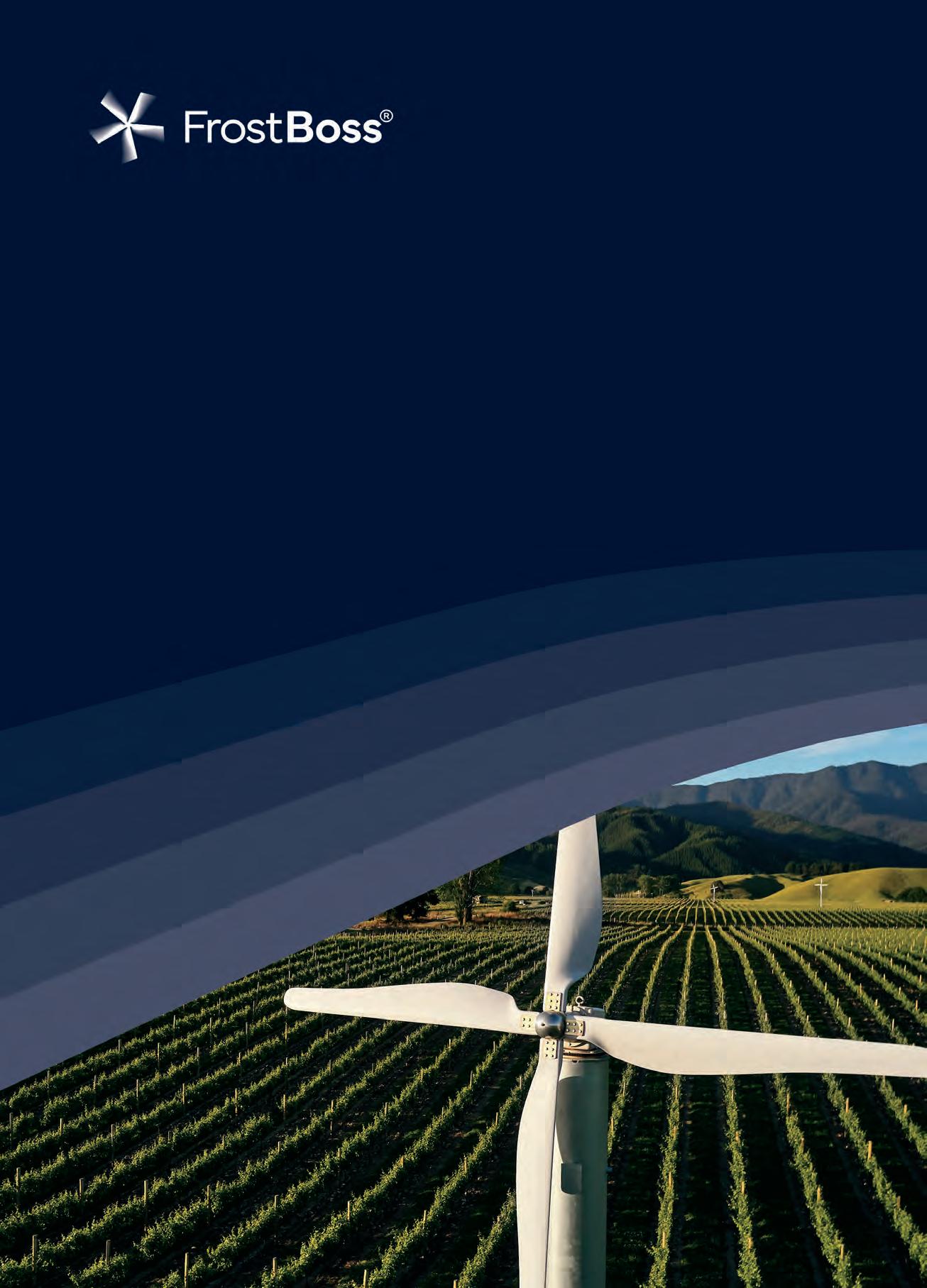

Vintage 2024
Regional update
Maude at 30
Sarah-Kate Dineen
The Profile
Chris Scott
Side Hustles
The moonlighters forging a new path in New Zealand wine



Vintage 2024
Regional update
Maude at 30
Sarah-Kate Dineen
The Profile
Chris Scott
The moonlighters forging a new path in New Zealand wine
Invitations are open for all New Zealand wineries to become part of the exclusive parliamentary wine range.
An exclusive, signature line to showcase the best of New Zealand wine is being created by New Zealand Parliament’s catering service.
This new wine range will be the exclusive wine served at parliamentary events, serve as the house wine in Bellamys restaurant and Pickwicks bar, and be available in the Parliament Gift Shop.
“Diners and visitors to Parliament already enjoy food which showcases the best of New Zealand cuisine, while soaking up the atmosphere at the heart of New Zealand’s democracy. Now, we want to pair this quintessentially New Zealand experience with some of our country’s finest wines”, Catering Manager, Bryce Hughes said.
“We want to showcase our homegrown produce to the over 80,000 people who visit Parliament every year.”
All wineries in New Zealand can submit their varietals to be part of the exclusive Parliament wine range when applications open on 25 March 2024. The range will


“We’re proud of this industry and all those who have put New Zealand on the wine map, and we want to showcase our homegrown produce to the over 80,000 people who visit Parliament every year.” - Bryce
Hughes.feature a variety of white and red wines, a Port or Tawny Port, and a Méthode Traditionnelle, so wineries are encouraged to submit their favourite varietals for consideration.
“One of the reasons our wine industry is so unique is the range of styles we’re able to produce from

subtropical Northland to icy Otago, and we’d like our wine list to reflect how diverse our winemaking regions are,” Mr Hughes said.
From the applications, a shortlist of wineries will be invited to present their contender(s) to a panel in Wellington, who will evaluate each on a range of criteria, including sustainability, technical merit, and value for money.
More information about the Parliament wine criteria and important material for applications will be available on the Parliament website from 25 March 2024.


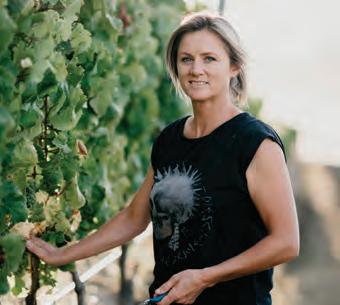

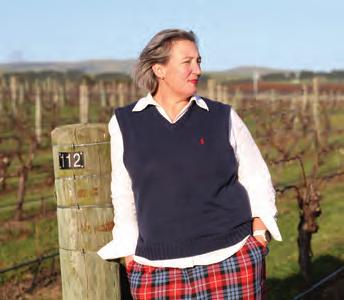
Editorial
Sophie Preece
From the CEO
Philip Gregan
Women in Wine
Sarah-Kate Dineen
The Profile
Chris Scott
Point of View
Jo Cribb
Wine Weather
James Morrison
Sustainability Update
Dr Edwin Massey
Vintage 2024
With low crops and dry weather, winegrowers around the country are looking at a light but beautiful 2024 vintage. For those who suffered the horrors of Cyclone Gabrielle last year, the sunlit harvest has been a welcome change. But many growers will be feeling the financial cost of poor flowering.
BRIght Ideas
Ngarita Warden will have 270 ferments under the microscope this vintage. “It’s going to be really busy,” says the Bragato Research Institute (BRI) Research Winemaker, as small parcels of grapes come steadily in, filling 17 litre tanks for some of the 22 commercial and four major BRI trials this year.
Women in Wine
Our industry needs the best, most skilled and motivated people, and gender shouldn’t get in the way. But research shows that it does, says the new Chair of New Zealand Women in Wine, Jo Cribb.
EDITOR Sophie Preece sophie@sophiepreece.co.nz
CORRESPONDENTS
Wellington Wine Country: Joelle Thomson mailme@joellethomson.com
Hawkes Bay: Olly Styles oliverstyles@hotmail.com
Canterbury: Jo Burzynska jo@joburzynska.com
ADVERTISING
Upper North Island: Stephen Pollard stephenp@ruralnews.co.nz
Ph: 021 963 166
Central & Lower North Island: Lisa Wise lisaw@ruralnews.co.nz
Ph: 027 369 9218
South Island:
Kaye Sutherland kayes@ruralnews.co.nz
Ph: 021 221 1994
CIRCULATION & SUBSCRIPTIONS
Sarah Adams saraha@nzwine.com
027 700 0740
New Zealand Winegrowers PO Box 90 276, Auckland Mail Centre, New Zealand
PUBLISHING & PRE-PRESS
Rural News Group
PO Box 331100, Takapuna, Auckland 0740
Ph: 09 307 0399
Location: Top Floor, 29 Northcroft Street, Takapuna, Auckland 0622
Publisher: Brian Hight
Managing Editor: Adam Fricker
Production: David Ferguson, Rebecca Williams
Published by Rural News Group Ltd under authority of New Zealand Winegrowers Inc. Unless directly attributed, opinions expressed in the magazine are not necessarily those of Rural News Group and/or its directors or management, New Zealand Winegrowers Inc. or its constituent organisations. Published every second month. One free copy is mailed to every member of New Zealand Winegrowers Inc, New Zealand Society of Viticulture & Oenology and the New Zealand Vine Improvement Group, and to such other persons or organisations as directed by the owners, with provision for additional copies and other recipients to be on a subscription.
ISSN 1174-5223

Rachael Cook is the smiling grape grower on this month’s cover, tending vines on the miniscule, beautiful and dream-driven vineyard she and her husband Murray have created on an east facing hillside of Marlborough’s Brancott Valley. But there’ve been plenty of tears shed while forging their wine label Nous in the moonlit margins of busy lives, with a young family, fulltime jobs at Dog Point Vineyard, and little more than basic tools to develop this wonderful side-hustle.
It’s a common theme of this edition’s focus feature, which explores the plethora of passion projects growing around New Zealand, as winegrowers and winemakers and wine marketers seek something unique, authentic and personal in their wines, sacrificing plenty along the way. “Everyone thinks it’s living the dream, which it definitely is, but it is by no means easy,” says Donald van der Westhuizen of Moko Hills in Central Otago. “Unless your whanau or partner are on the same page and support what you are doing it will put strain on these relationships,” agrees Jannine Rickards of Huntress in the Wairarapa.
Jules Taylor, whose own side hustle began in 2001 with 400 cases of wine and a busy fulltime job, feels a “a bit queasy” when she sees others following that path now. It’s akin to seeing a young person with a small child, and thinking “thank God that’s not me”, she says. “I do take my hat off to people. It’s not easy… You are dealing with something so driven by nature and the season, that just complicates things even more. But it’s also what makes the job really interesting, because every year is different.”
That’s a neat segue to this edition’s harvest update, which is largely about sunny days, dry vineyards, light crops, great quality and earlier than normal harvest dates. “They’re not all like each other,” says Valli Winemaker Jen Parr. “Or else it would be easy and everyone would do it.”
Sophie Preece EDITOR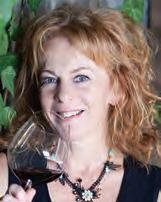
Joelle Thomson



Wine and viticultural research is on an upwards trajectory in New Zealand, Ngarita Warden tells journalist and wine expert Joelle Thomson. “Like any industry, we need to be a lot smarter about what we do.”
Go to page 31

Claire Finlayson
Sarah-Kate Dineen talks
to writer Claire Finlayson about 30 years of Maude.
“The fact that Mum and Dad had the foresight to plant a vineyard and the dedication to find the right site – we’re just reaping the benefits of that now.”
Go to page 37

Emma Jenkins MW
Running a side hustle is not for the faint-hearted, Saorsa co-founder Alex Hendry tells Emma Jenkins MW in this month’s Focus package.
Emma also speaks to Dave Nash about the Chardonnay partnership behind Helio Wines.
Go to page 27
With over 20 years’ experience working with the wine industry throughout the New Zealand Pacific region, we understand what it takes to enhance productivity and decrease costs for your winery. We can help you make your vintage a success by:
• Controlling fermentation
• Providing temporary cooling for cellars or other critical functions
• Providing additional power when needed
We are on call 24 hours a day, seven days a week to serve you.
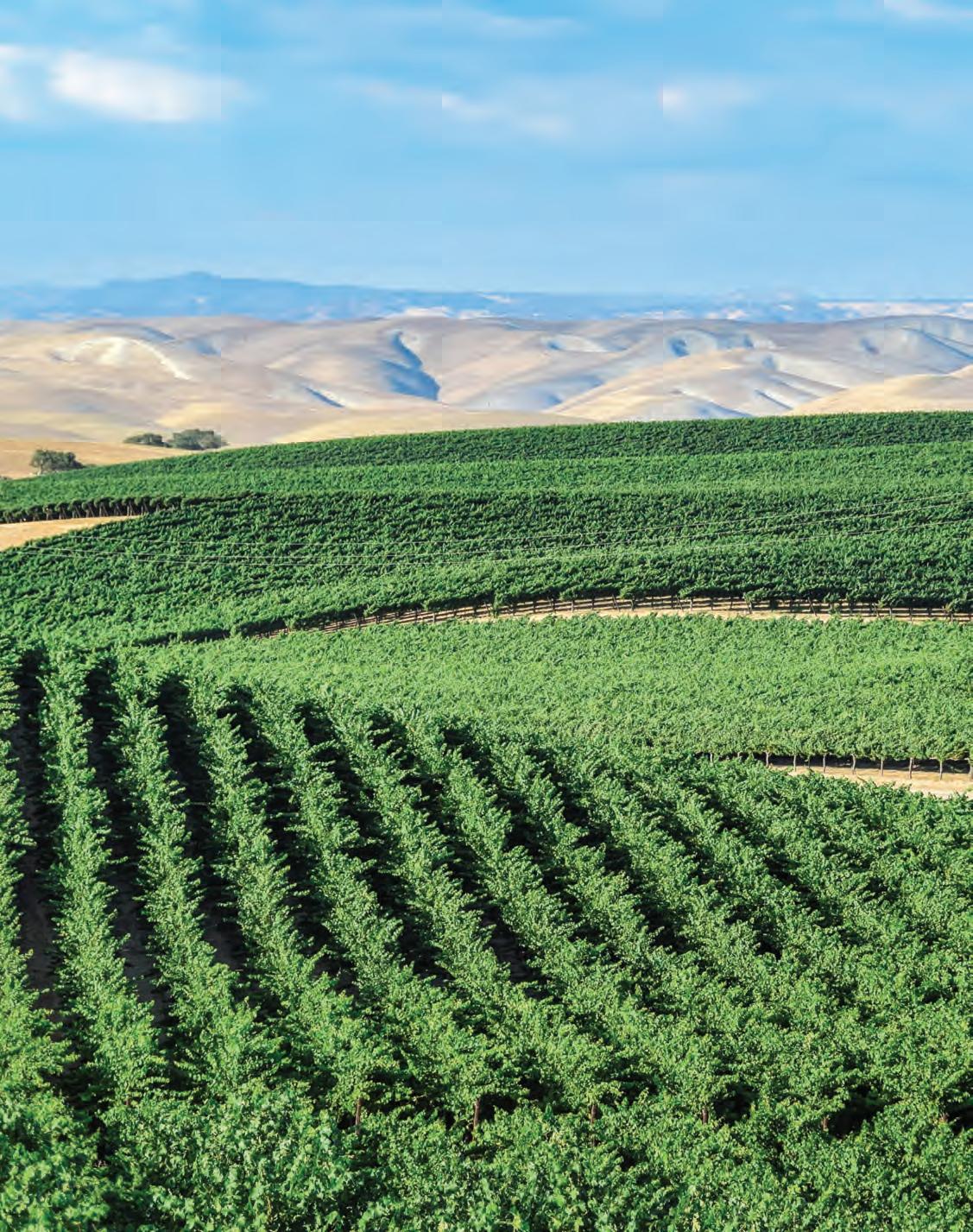
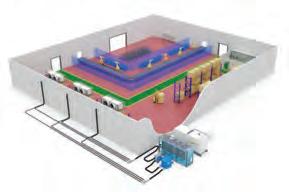
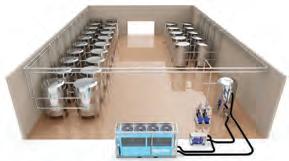
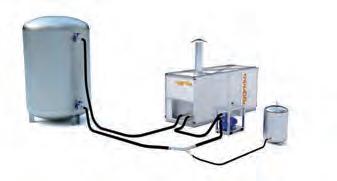

Harvest begins, and almost immediately we start to get media enquiries about how the vintage is going and whether it is going to be a good year for New Zealand wine. It is great to see the media interest in the industry, but in early February it is always difficult to give an answer that is not pure speculation.
At the time of writing, mid-March, harvest is well underway throughout the country, and, to date, it seems that growers and wineries appear very happy with quality. The summer and autumn so far have delivered close to ideal conditions, which is being reflected in the grapes –there is little disease pressure and flavours are good. After the challenges posed by Cyclone Gabrielle last year, this will be a big relief for many in the industry. On the other hand, it seems nationally the harvest volume is going to be well down on the past two years, reflecting cool flowering weather and the impact of frosts.
So, it appears that nature is going to deliver on the quality front this year, but it has been somewhat stingier in terms of quantity. Vintage quality, of course, is not just determined by nature; it is also a function of all those decisions, from pruning onwards, made by growers and wineries through the course of the vineyard year, and in the winery once the grapes have been picked. I’ve yet to meet a producer in New Zealand who does not want to produce quality grapes and wine, so ‘quality’ is one of the outcomes driving those decisions.
Wine quality is one of the factors underpinning the reputation that New Zealand Wine has built over the past two or three decades. Without the right reputation – premium, distinctive, sustainable – our wines would not
command the prices that they do in international markets. As our reputation has grown over time, so has our industry. Curated well, that reputation will underpin future success and growth of our industry over the next generation and beyond. On the other hand, lose that reputation, or bring it into question, and that would put everything that has been achieved at risk.
“Curated well, that reputation will underpin future success and growth of our industry over the next generation and beyond. On the other hand, lose that reputation, or bring it into question, and that would put everything that has been achieved at risk.”
Philip Gregan
Protecting and enhancing the New Zealand wine brand reputation is the responsibility of every grower, winery, contractor, and employee in the industry. Small and big decisions all have the potential to add to, or diminish, the reputation of New Zealand wines. So, our reputation should be of interest to every industry member. It should help guide decision making for growers, winemakers, and wine marketers and sellers.
Of course, New Zealand Winegrowers
has a role in protecting our brand reputation. From an advocacy perspective, enhancing the reputation of our industry is fundamental, from legislation such as the Wine Act, to the Geographical Indications legislation, these underpin the industry. And we produce a range of guides for industry members, all of which are aimed at protecting the reputation of the industry, such as the Spray Schedule and winemaking and labelling guides. From a brand perspective, we are now tracking consumer views on our wine and reporting those back to members; our in-market seminars tell the New Zealand wine story to trade and media. Our sustainability activities support the brand of course, and our research activities, through Bragato Research Institute, virtually all have a strong focus on quality and sustainability, key components of the New Zealand Wine brand’s reputation.
There are also a host of industry initiatives all dedicated in one way or another to improving the quality and reputation of our grapes and wines. Regional associations, Organic Winegrowers New Zealand, the New Zealand Society for Viticulture and Oenology, the Pinot and Syrah workshops, Hawke’s Bay Wine’s Chardonnay Symposium, Appellation Marlborough Wine and others are all helping build our reputation.
The very high standards set by growers and wineries are the reason our wines and our industry have a positive global reputation today. Our future success depends on maintaining and enhancing all aspects of that reputation – whether it be for the quality of our wines, our commitment to sustainability, or for respecting and nurturing our people.
With each Origine by Diam solution, winemakers can master the ideal oxygen level and optimal bottle aging duration depending on their wine profile and wine history. With all the Diam guarantees, this bio-based cork range enables winemakers to best meet their consumers everchanging needs and environmental issues.
Origine by Diam, the power of choice
Distributed By:
Vinocor, the exclusive partner for DIAM closures in Oceania.
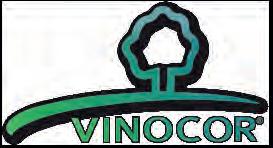
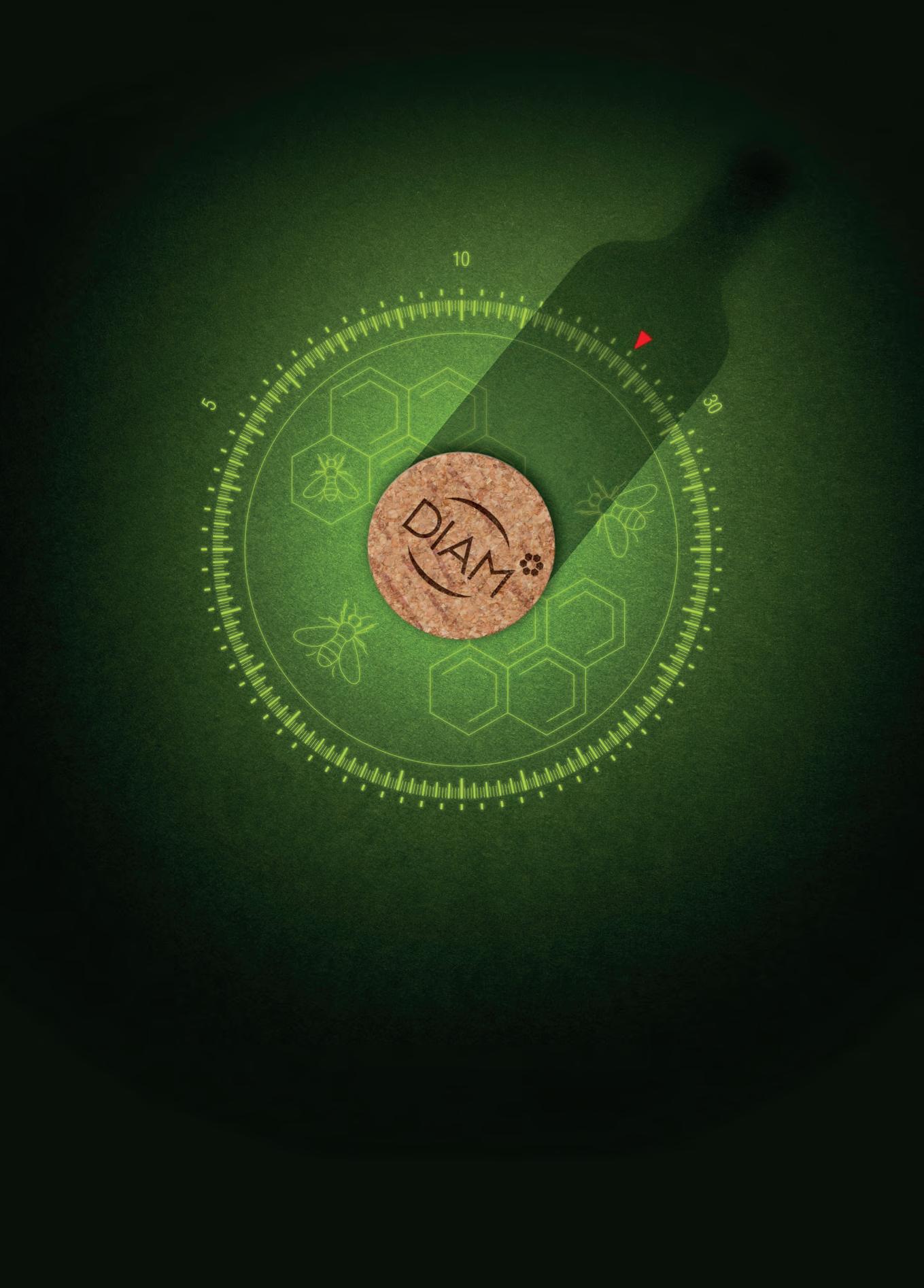
AUSTRALIA
Ph. +61 8 8392 9999
Email. info@vinocor.com.au
Web. vinocor.com.au
NEW ZEALAND
Ph. +64 2157 5380
Email. andrew.twiname@vinocor.co.nz
Web. vinocor.co.nz
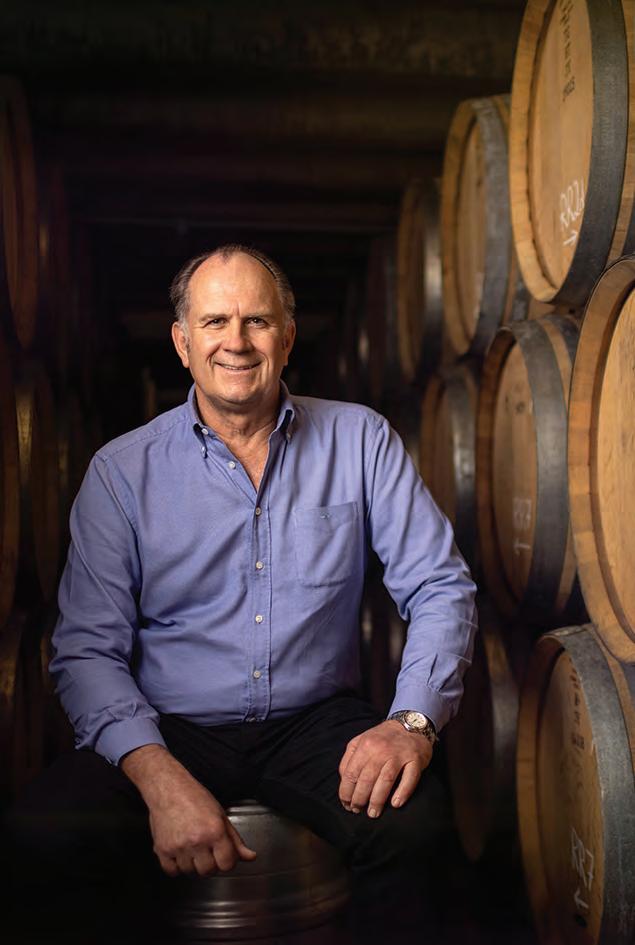
Michael Brajkovich MW has been honoured as the 2024 Winemakers’ Winemaker at a ceremony during ProWein trade fair in Düsseldorf. Presented by the Institute of Masters of Wine and The Drinks Business since 2011, the award recognises outstanding achievement in winemaking, with Masters of Wine winemakers and the previous award recipients voting in the recipient. The Kumeu River winemaker was mid-harvest (page 16) at the time, so accepted the award with a video message. “I am absolutely delighted and deeply honoured to be recognised by my peers of the Institute,” he said, as reception guests were poured a glass of the 2022 Kumeu River Hunting Hill Chardonnay. “It’s a real honour to be included in the list of people who have won this award in the past and even more so because it is a recognition from members of the Institute and particularly winemaker members of the Institute.” Michael emphasised that winemaking is a team effort and credited his family who are actively involved at Kumeu River. “My brother Milan looks after the vineyards, sales and marketing is taken care of by my sister Marijana and brother Paul. The company was started by my late father Maté Brajkovich and continued by his wife (my mother) Melba Brajkovich. And I’d also like to mention Nigel Tibbits who who’s been with the family business for 50 years and continues to help us make great wine.”

New Zealand’s wine industry shone in Cuisine Magazine’s list of ‘Aotearoa New Zealand’s TOP 50 most influential & inspiring women in food & drink 2024’. New Zealand Winegrowers General Manager Brand, Charlotte Read, joined winemakers Alice Rule, Jane Cooper, Jannine Rickards (page 24), and Lauren Yap (page 39) on the list, along with Loveblock owner and sustainability leader Erica Crawford, New Zealand wine and food champion Celia Hay, Invivo Marketing Manager Rachael Everitt, and liquor retail specialist Aroha Jakicevich. Many of the other women on the list are deeply involved in hospitality, including the celebration of New Zealand wine. In introducing the list, Cuisine Editor Kelli Brett noted that influence comes in many forms. “It can be found in someone who has an established brand and access to a massive number of people, but also in someone who works quietly in the background to instigate positive change.”

Matt Fox is now Chair of the New Zealand Young Viticulturist of the Year national committee. Matt was the 2013 national winner and is now Viticulturist for Rapaura Springs and Summerhouse Wines. “This competition gave me a great platform to grow my own career and I’m keen to help more young viticulturists flourish in an industry I’m passionate about,” he says. “It’s great to have a fantastic committee to work with: Nick Paulin, Annabel Bulk, Mike Saunders, Paul Robinson and Adam Yukich.”
New Zealand winemakers have been invited to take a seat at Parliament’s table, with plans for an exclusive signature wine range. “We want to showcase our homegrown produce to the over 80,000 people who visit Parliament every year,” says Parliamentary Service Chief Executive Rafael Gonzalez-Montero. The new wine range will be the exclusive wine served at parliamentary events, served as the house wine in Bellamys restaurant and Pickwicks bar, and be available in the Parliament gift shop. “Diners and visitors to Parliament already enjoy food which showcases the best of New Zealand cuisine, while soaking up the atmosphere at the heart of New Zealand’s democracy. Now, we want to pair this quintessentially New Zealand experience with some of our country’s finest wines.” All wineries in New Zealand can submit wines to be part of the range, which will feature a variety of white and red wines, a port, and a méthode traditionnelle. “One of the reasons our wine industry is so
This September Toby Buck hopes to drive a herd of sheep over the Thames, tapping into one of the entitlements of being a Freeman of London in the Vintners Company. “I feel somewhat obligated as a Kiwi,” he says a few weeks after joining the guild, as the first New Zealander in its 660-year history. The Vintners Guild was founded in 1363, as one of the 12 Great Livery Companies of London. It created the WSET and the Institute of Masters of Wine, “and have really stuck around because of their charitable works, constantly updating themselves while remaining true to their aims”, Toby says, fascinated by the age of the organisation. “Sophistication and continuity are always interesting ideas in wine.”
Having a New Zealander in the company is valuable, he says, “since the world that defines the Vintners Guild is fine wine, and global wine trade and
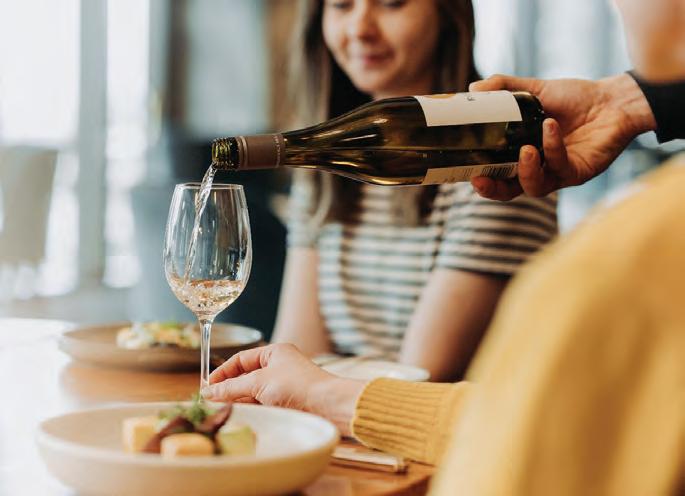
unique is the range of styles we’re able to produce from subtropical Northland to icy Otago,” Rafael says. “We’d like our wine list to reflect how diverse our winemaking regions are.” A shortlist of wineries will be invited to present their
wines to an expert panel in Wellington, who will evaluate each on a range of criteria, including sustainability, technical merit, and value for money. Go to parliament.nz for information about criteria and the application process.
wine culture… Having a New Zealander in that room and having the quality of New Zealand wine acknowledged in that
“Having a New Zealander in that room and having the quality of New Zealand wine acknowledged in that room, is something of value. It’s a mark of recognition.”
Toby Buck
room, is something of value. It’s a mark of recognition.” Traditionally, joining the Vintners Company occurred via
patrimony, restricted to those whose father or grandfather was a member. “Now they are a much more inclusive place, but this is the first time they’ve allowed outsiders like me in,” Toby says. “In my group of 40 joining, I’m one of only four on the Vintners’ Trade Entry Scheme for people in the industry.” Toby’s wine career started when he was five years old, working at his family’s Te Mata winery to pitchfork stalks into a bin as they flew out of the de-stemmer. He’d cleaned plenty of tanks and gutters, pruned and planted plenty of vines, and bottled, labelled and packaged plenty of wine, before starting work at the cellar door, and eventually representing the wines abroad. At times the guild, with its “incredible” buildings, collections, and traditions, “does seem a very long way from Hawke’s Bay and vineyard life”, he says. Not to mention herding sheep across the Thames.
To have events added to our calendar contact sophie@sophiepreece.co.nz
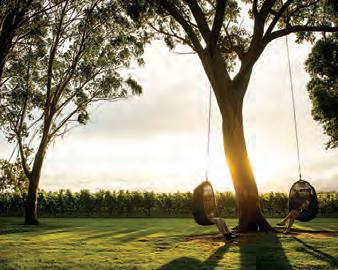
27 – 31 May
marlboroughwinenz.com/industyevents
The second Marlborough Wine Industry Wellness Week will build on the success of the inaugural event, which saw companies, individuals and organisations sharing tips for wellbeing during harvest and throughout the year. The week aims to strengthen a culture of wellness and wellbeing in the industry, while highlighting effective and innovative initiatives from across the sector.
7 June
hawkesbaywine.co.nz
A one-day workshop at Toi Toi in Hastings exploring the opportunities and challenges for this important category for Hawke’s Bay and beyond. To register interest email info@ hawkesbaywine.co.nz.

7 – 14 June
organicwinenz.com/kellymulvilletour Organic Winegrowers New Zealand is partnering with Kelly Mulville, from Paicines Ranch in California, to deliver a series of workshops around New Zealand
this winter. The Horticentre Charitable Trust OWNZ Kelly Mulville Tour workshops take place in Central Otago on 7 June, North Canterbury on 10 June, Marlborough on 12 June, and Hawke’s Bay on 14 June. Kelly is a pioneer of the regenerative viticulture movement in the United States, with an approach that aims to move with climate change and reduce the environmental footprint of vineyards by developing innovative viticultural growing systems.
Wellington 7 – 8 June
Auckland 26 – 27 July winetopia.co.nz
Winetopia sees thousands of wine lovers come together with sommeliers, Masters of Wine and winery representatives to taste new releases and meet new potential customers. All regions of New Zealand are represented and this year there are new attractions in both cities.

Marlborough: 24 June
Central Otago: 2 July
Hawke’s Bay: 4 July
nzwine.com/grape-days
Join Bragato Research Institute (BRI) at Grape Days 2024 for the latest grape and wine research. More information including the programme and tickets will be available at nzwine.com/grape-days.
WinePro
25 – 27 June winepro.co.nz
A major wine trade event in Marlborough this winter will feature an industry-led conference themed Innovate, Elevate, Celebrate. Focused on business intelligence, the WinePro conference will delve into emerging trends, sustainable practices, and
technological advancements, surrounded by wine industry suppliers and equipment, including the latest innovations and technologies shaping the future of the wine industry. The event has been supported by Marlborough District Council, New Zealand Winegrowers, Bragato Research Institute, AgriTech NZ and Wine Marlborough Ltd, ensuring strong industry support and a stellar line up of speakers and experts, says organiser Gary FitzRoy. “This event is not just about business, it’s a celebration and tribute to the remarkable achievements of the New Zealand wine sector.”

27 – 28 July (judging)
wine.theshow.co.nz
The Aotearoa Regional Wine Competition is focused on championing and promoting New Zealand’s regional uniqueness. Chaired by Jim Harré, with a panel of experienced judges, the Aotearoa Regional Wine Competition, sponsored by The George Hotel, is a fantastic opportunity to promote your wine to local and international markets, with all gold medal winning wines exposed to 115,000 people at The New Zealand Agricultural Show. Entries open on 8 May and close on 10 July.
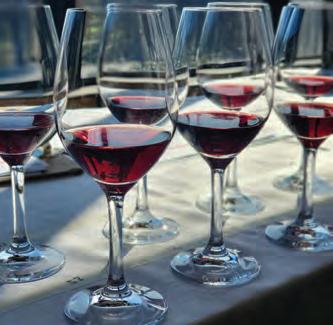
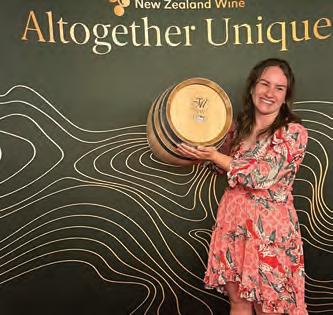
27 August
nzwine.com/en/initiativesevents/ young-winemaker/
Regional competitions for the 2024 Tonnellerie de Mercurey Young Winemaker of the Year will run throughout New Zealand in July and August, followed by the National Final on 27 August at Foley Wine’s The Runholder in Wairarapa. The winner will be announced at the Altogether Unique 2024 Celebration Dinner on 29 August.
28 August
nzwine.com/en/initiativesevents/ young-vit/
There are five regional competitions for New Zealand Young Viticulturist of the Year this year, with the National Final to be held at Escarpment in Wairarapa on 28 August. The winner will be announced at the Altogether Unique 2024 Celebration Dinner in Wellington.

29 – 30 August
nzwine.com/en/initiativesevents/ altogether-unique-2024
New Zealand Winegrowers’ (NZW)
annual Altogether Unique 2024 industry celebration will be held in Wellington at Te Papa. Two days of events will be headlined by a Celebration Dinner, honouring this year’s NZW Fellows, and featuring the 2024 Young Viticulturist and 2024 Young Winemaker awards. More details of all events will be released in May.
26 – 27 September
hawkesbaywine.co.nz
Expanding on the foundation of education and community laid in 2023, this year’s Symposium, to be held at Toi Toi in Hastings, shifts focus to explore the sense of place in Aotearoa Chardonnay, through informative case studies, inspiring speakers, and an expansive tasting programme.
MCC New Zealand is committed to telling your brand’s story through beautifully crafted labels, that complement the design and brand vision.
Talk to MCC New Zealand, where every product is labelled with care.
Producer:
No1. Family Estate
Designer: Alex Lloyd
Photographer: Jim Tannock
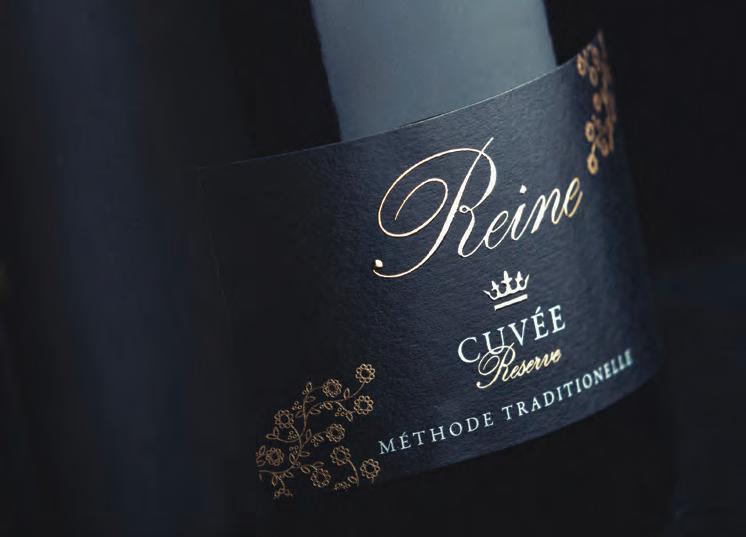
The year has kicked off with some great positives for New Zealand wine, despite softening sales volumes within New Zealand and in our key export markets. Our first activities of the year included February’s London and Dublin Annual Trade Tastings, which have always received strong visit numbers and subsequent media coverage. In March, The New Zealand Wine Pavilion at ProWein in Dusseldorf was 50% larger, as more of our members took the opportunity to showcase their wines to a global trade audience.
Meanwhile, the second wave of consumer research conducted in major markets for New Zealand Winegrowers (NZW) was explained in a recent webinar (page 13), that revealed strengthening brand health and potential growth for New Zealand Wine, which is very welcome news. We are seeing record member numbers in webinars like this, which share relevant market intel and insights. Our Wine Business Forum, to be held on the first day of Altogether Unique 2024 (29-30 August), will be another great opportunity for members to learn and connect. We look forward to sharing more details on the programme and speaker line up in the coming months.
Charlotte Read is NZW General Manager Brand


NZW featured in the National Liquor News 2024 Industry Leaders Forum magazine. The publication is considered a go-to source for the latest insights, trends and innovations in Australia’s dynamic liquor retail industry.
Catherine Wansink will now be a regular contributor to the monthly magazine, raising the profile of New Zealand Wine in Australia and keeping it top of mind with the trade.
The New Zealand Wine Annual Trade Tastings are the largest and most diverse tastings of New Zealand wine in the region, and we were delighted to welcome over 500 guests across both events in February. In London, the event was held on Waitangi Day and opened by the High Commissioner Phil Goff. Key highlights of the day included:
• A business briefing showcasing the strong performance of New Zealand wine in the United Kingdom.
• Oz Clarke delivering a passionate masterclass following his recent trip to New Zealand.
• A special regional focus table, highlighting wines from all of our winegrowing regions, along with an organic feature.
• More than 250 wines available to taste from across New Zealand, featuring a wide range of varieties, from Albariño to Viognier, Chenin Blanc to Cabernet Franc.
We are excited to welcome back Carolina Paiva to the Events Team as Events Manager, reporting to Sarah Szostak, Events Lead. Carolina has a breadth of experience in both event execution and with the NZW organisation. With a fantastic career to date, including work for the Brazilian fashion industry via her role with the Textile and Apparel Industry Association, Carolina brings passionate events knowledge and a great understanding of the complexities of working within an industry association. Carolina will support many of the key activities within the Events Team, including Grape Days, export market activities, and sponsorship execution, as well as working on the Industry Celebration and its surrounding events. For further information on NZW events, please get in touch with Carolina Paiva (carolina. paiva@nzwine.com) and Sarah Szostak (sarah.szostak@nzwine.com).

• Media coverage of the event in The Buyer, Harpers, Drinks Business, Drinks Retailing News, and Just Drinks, reaching a total of 482,192 people. To view the media coverage, check out the Press Coverage section on the NZW members site at nzwine.com/members.
In Dublin, the event began with a masterclass from John Wilson on Regional Heroes and Pioneers. There was a strong turnout of high-calibre trade and media, with leading importers, off-trade, and on-trade buyers represented. This was followed in the evening with the consumer tasting, which attracted a sell-out crowd of interested and keen consumers eager to learn and taste New Zealand wine.
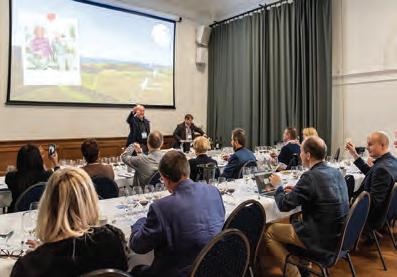
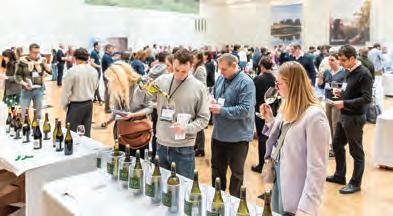
New Zealand wine is in robust health, says a data cruncher “taking the pulse” of consumers in key markets. Despite a drop in export shipment performance, New Zealand wine continued to grow and “significantly” outperform the wine category at point-of-sale in both value and volume in its two top markets – the United States and United Kingdom – last year, says New Zealand Winegrowers (NZW) Intel and Insights expert Richard Lee.
Speaking in a February NZW webinar on brand health, Richard dissected results of the 2023 IWSR consumer research on the category health of New Zealand Wine from a consumer perspective, commissioned by NZW and conducted in the US, UK, Australia, and New Zealand markets in late 2023. In introducing the webinar, NZW General Manager Brand, Charlotte Read, noted that the “treasure trove” of data behind the report and webinar showed that while exports have declined as a result of supply chains stabilising, “we do not have a problem at the consumer level”.
In the US market, scan data from early February shows New Zealand Wine is “very much in positive territory” up 7.1% in value growth over the last 12 months, “strongly ahead of the total wine market” which was down half a percent, Richard says. In the past quarter, including the Christmas trade, New Zealand wine remained “very strong”, up 6% in value terms, against a -0.5% change in the market. In terms of volume, New Zealand wine was up 3.5% for the year, while the category was down 4.3%.
Meanwhile there’s a good story around brand health, including the conversion of ‘potential buyers’ to ‘loyal buyers’, lifting the latter from 31% to 36% between 2022 and 2023. There’s an enormous reservoir of ‘potential buyers’, with that 30% – who had not yet bought New Zealand wine but were aware of and remained open to purchasing it – equating to 26 million regular wine drinkers in America. “That’s a significant number in terms of potential growth down the track,” Richard says, noting the additional potential of the 19% of regular wine drinkers as yet unaware of New Zealand wine. “New Zealand wine has

done very well in the US. But the exciting thing for me is that we are not done yet. There’s an awful lot of potential for future growth in this market according to these numbers.” There’s also a shift in the New Zealand wine buyer profile, skewing younger with a significant increase in LDA (legal drinking age) to 34-year-olds (23% to 33%). And there’s a larger proportion (20% to 24%) of the ‘Generation Treaters’, a younger consumer segment, mainly Millennials, who are more frequent and adventurous wine drinkers, Richard says. According to IWSR, ‘Generation Treaters’ account for around one in 10 ‘Regular Wine Drinkers’ in the US and, more importantly, around $1 in $5 of wine spend. “Younger consumers will be the ‘breadwinners of tomorrow’, replacing ‘baby boomers’ as a key success factor in the future growth of New Zealand wine,” he says.
Scan data from the UK also shows a sector in good health, with New Zealand wine continuing to track well ahead of the UK wine market on value and volume growth rates, on both an MAT and quarterly basis, versus 2022. However, like the US, the quarterly growth rates tracked slightly behind the year-long performance. Value growth for New Zealand wine was 8.8% compared to 2.7% in the market at large, and in the past quarter was 7.6%, compared to 4.1%. In terms of volume growth, the 12-month period saw growth of 6.5% compared to the market at -2.7%, with the past quarter up 2.3%, compared to the market at -3.9%. “This is a very positive result in what is a significant market for us,” Richard says. “In terms of wallet behaviour, there’s no sign of New Zealand wine falling off a cliff.” In the UK market, ‘From a place I trust’ was one of the top three associations for New Zealand wine, up significantly on the previous year.
Sales in Australia and New Zealand were comparatively less buoyant, with scan data from Australia showing value growth of 1%, compared to the market’s -0.8%, while volume growth was slightly below the category, at -1.7% compared to -1.2%. “But again it’s not a train smash,” Richard says. In New Zealand, Australia made gains of 5.7% in value while growth of domestic wines declined by 0.7%, compared to a modest 0.4% value growth gain for the category. Despite that drop, New Zealand wine’s market share and brand health remained strong, with the three top brand image associations of taste, trust and brand remaining stable, “which is good”. In both Australia and New Zealand there was a slight shift in demographic profile, with an increase in the proportion of female drinkers.
Richard says a consistent theme across the markets is that New Zealand has a very strong association with sustainability. At this stage that’s a “hygiene” factor in wine purchasing decisions, falling below many other motivations, but he expects that to change over time. In the New Zealand market sustainability jumped as a buying trigger between 2022 and 2023, which may reflect the influence of Cyclone Gabrielle. “My hypothesis is that as climate change becomes much more front and centre in people’s everyday lives, I would expect sustainability and environmental factors to become far more important as a driver of sales.”
Richard says the 148-page report, along with the data rich excel sheets behind it, is an invaluable resource for wine companies wanting to understand markets, consumers, and varietal trends. “This resource should be your first stop.”
Find Unlocking Insights; Taking the Pulse of the New Zealand Wine Consumer on the members section of nzwine.com
The continued rise of Marlborough Sauvignon Blanc
Paul Dunleavy grew up immersed in the wine industry, and these days has his own bespoke wine label on Waiheke Island, along with considerable Sauvignon Blanc interests in Marlborough. He shares some of his thoughts on the market, past, present and future.
You’ve said the word ‘surplus’ has no place in Marlborough wine. Why?
New Zealand’s Sauvignon Blanc story is a textbook example of the ups and downs that happen with exponential growth in a new industry. Despite a seemingly insatiable demand from our export market, we are tormented internally by negative sentiment around markets turning sour and oversupply. From September to December 2022, we exported 126 million litres of wine, annualising to 175% of average production over the previous decade. This was due to our export markets lifting in market inventories, so they did not run out because of Covid-impacted shipping. These record shipments lifted exports to an alltime high of $2.4 billion for the year ended June 2023. That cannot be matched in the near term because we do not grow enough. From September to December 2023 the year-on-year comparisons shown in New Zealand Winegrowers (NZW) export report showed reductions of 25%, as ‘in market inventories’ corrected to ‘just-in-time’. Although inevitable, these reductions were interpreted by most of our winegrowers as a sign that our markets were tanking and we would move into oversupply. This thinking did result in a collapse of bulk wine pricing.
As a student of wine, particularly Sauvignon Blanc, my forecast back then was one of a shortage emerging prior to vintage 2025 following a low 2024 harvest. Global sales momentum continues to lift demand. We do not have the land to increase supply as we have in the past. Last November I shared my thoughts in a paper considering our long-term average production, seasonal swings in supply, and continuing growth in value per litre.
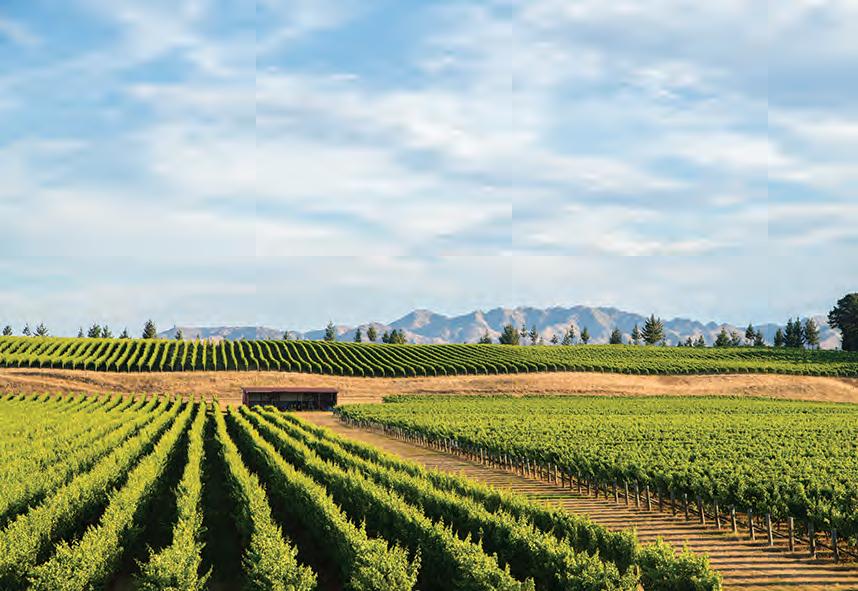
Most growers will be aware of this season’s slow growth due to a cold dry spring. Poor flowering, continuing dry, and a far from ideal berry cell division have worsened the outlook. As a grower of Marlborough Sauvignon Blanc, I lowered my already low expectations for vintage 2024 based on yield estimates. I now expect a national vintage of 230 million litres, 22.5% down on 2023. This, together with what is left in tanks for 2023, will not be enough to maintain exports over the 18 months from January 2024 at the rate we have exported during the 18 months to December 2023. Export market demand for our wine has moved beyond our ability to produce. I am surprised that more people in our industry have not realised this and do not seem to understand just how much wine they need in tanks to maintain their current supply.
How are companies responding to market shifts?
Many people interpreted the wine export data to mean that export markets had shifted negatively. In fact the reason our export markets bought forward and upped their inventories is because they value our product so highly. It’s a fair bet that the markets did not buy Australian Shiraz or Italian Prosecco forward like they did New Zealand Sauvignon Blanc. Back here some panicked at what was they thought was bad news. The bulk price collapsed. Some companies have clearly used the negativity to lower their grape pricing, while other companies understand the need for supply and have maintained reasonably stable
grape pricing. The polarity of grape pricing this year is astonishingly wide.
What’s the outlook as you see it?
The outlook is great for New Zealand wine as a whole and we now see Sauvignon Blanc lifting interest in other varieties from New Zealand. However, we have to be careful about starving the market for a period when we run out of Sauvignon Blanc, before vintage 2025 comes on stream. The outlook for individual companies is varied. We will not have enough Sauvignon Blanc for them all to execute their market ambitions. Nearly half of our Sauvignon Blanc supply is through growers, and it is clear to me that loyalties are being tested.
What’s the secret to Marlborough Sauvignon’s success?
Globalisation allows anyone, anywhere, to drink what they like in the glass, rather than what has been grown for centuries in local vineyards. Marlborough Sauvignon Blanc is not a short-term trend. It is part of a global change in drinking preference that has been 50 years in the making, and one where our offering excels. NZW’s recent Market Pulse webinar (page 13) hit the nail on the head – people are drinking our Sauvignon Blanc because they like the taste and see it as great for every occasion. What Oz Clarke said so long ago still stands today: “There had never before been a wine that crackled and spit its flavours at you from the glass.”
To read more of Paul’s analysis on export data and sales trends, email him at paul@temotu.co.nz

With a date set for Pinot Noir New Zealand 2025, to be held in Ōtautahi Christchurch 11-13 February 2025, Committee Member Paul Donaldson gives us a taste of what’s to come.
Our latest news is... with the event being held in a new city, I’ve been gauging interest in the desire for a list of reputable latenight establishments capable of providing a high-class soothing libation … All feedback welcome!
“Prepare for Pinot and partying, reconnecting and rollicking, cultivation and celebration. Oh and learning for sure. Bring it on.”Paul Donaldson
Prepare for... Pinot and partying, reconnecting and rollicking, cultivation and celebration. Oh and learning for sure. Bring it on.
Our committee is... laser focused with a terminator-esque determination to deliver a great event. Oh, and they are great people as well (unlike the actual terminator… well, in the first movie anyway).
New Zealand Pinot is... ready to create more hype than a Taylor Swift world tour.
One thing you should know about me is... that as one of the few committee members to have carried over from the previous board, I have been awarded official mascot status. I am “Paul the Purple Pinot Porpoise”. There is no going back, I may need a costume.

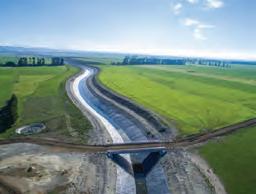

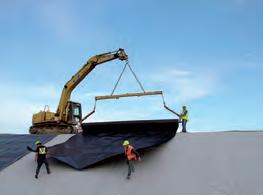
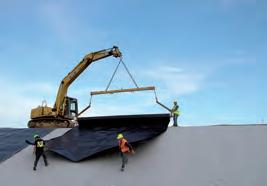
Viking Containment is New Zealand’s leading supplier and installer of geosynethic products for the primary, civil and building construction sectors.
Viking Containment is New Zealand’s leading supplier and installer of geosynthetic products for the primary, civil and building construction sectors.
Geomembrane Liners for
Geomembrane Liners for
➤ Water Storage Dams
➤ Dairy Effluent
Landfill & leachate
➤ Irrigation Canals
➤ Frost Protection
Potable Water Reservoirs
➤ Wasterwater Lagoons
Wastewater Lagoons
Irrigation & Dairy Effluent
➤ Floating Covers
➤ Baffle Curtains
Floating Covers
Baffle Curtains
Geosynthetic Products
➤ Bentomat®
Geosynthetic Products
➤ Geogrids
➤ Geosynthetic Clay Liners
Bentomat ® Geosynthetic Clay Liners
Geogrids
➤ Geocells
Geocells
➤ Geocomposits
➤ Geotextiles
Geotextiles
Associated Products
Associated Products
➤ Geoladder®
Geocomposites
➤ Depth Gauge
Geoladder ®
➤ Geolock®
Geolock ®
Depth Gauge
➤ Viking Vent
Viking Vent P

If vintage 2023 is remembered for rain, rain, and more rain, 2024 stands out for sunny skies and tinder dry vineyards. Yields are down for many, but winemakers are heralding excellent quality across all varieties.
Kumeu River’s 2024 harvest was done and dusted by mid-March, with light crops ripening quickly in the dry and warm conditions. The quality of fruit is “really good”, says Michael Brajkovich, but yields are around 40% down on the long-term average at their Kumeu site, and at least 50% down at Raukawa in Hawke’s Bay, thanks to inclement weather during initiation and flowering. Michael also believes last year’s sodden soils, including the downpours of Cyclone Gabrielle, have depleted vineyard health. “You can’t have that much water run through the soil profile and not have an effect on nutrition.” They have been soil sampling
“It’s absolutely stunning as far as quality goes,” says Church Road winemaker Chris Scott (page 40) of Hawke’s Bay 2024 harvest. “We’ll have no trouble making the top tier wines.” Speaking from home isolation on 12 March, having caught Covid in the first week of vintage, Chris says the handpicked Chardonnay for the premium programme is all but complete, “and the quality of the fruit has been just amazing”. With good flavour ripeness at relatively low brix, they chose to pick reasonably early, he says. “We’re quite happy getting stuff in around 21 brix; we haven’t been pushing things too hard because we were a little bit worried about things blowing out and looking too soft and amorphous.” The reds are looking “fantastic” as well, Chris says, expecting to end his isolation in time to check Merlot around 15 March.
The low yields are thanks to a combination of last year’s low sunshine hours, reducing potential fruitfulness of

to see “what the story is” in order to mitigate the impact.
Despite a wet winter and spring, which meant tractors couldn’t get into the vines, the growing season was a complete turnaround from 2023, with a “kind of an El Niño” that saw soil moisture completely depleted before vintage. Michael says one rain event of around 20mm “kept the lawns alive, but not much more than that”. He welcomed the long run of dry, warm (but not too hot) conditions this season, with daytime temperatures between 25C and 28C ensuring even ripening.
The lower volumes but high quality will mean less production of the lower priced
the vines, as well as poor weather over flowering in spring, cutting yields even further. He has also heard stories of some blocks yielding particularly poorly after cyclone-struck growers left fruit on the vine in the 2023 harvest, potentially compromising carbohydrate stores.
A couple of quick “southerly cold flicks” came through in March, including an unexpected drop to 1.4C at Bridge Pa, which put the brakes on the rapid ripening of Chardonnay, giving hand picking teams a reprieve, Chris says. “Other varieties like Merlot didn’t seem to blink an eye.”
The fine weather has been a welcome change from a series of challenging seasons, culminating in last year’s cycloneaffected vintage, he adds. “From a quality standpoint at least, there are a lot of happy winemakers and viticulturists around the region at the moment.”
Growers are less buoyant, with low tonnage a blow after recent rain-affected seasons. “Whilst we are celebrating the harvest, it’s a difficult season for some,”
Village range, but also less of the hallowed single vineyard wines, with the Estate range getting much of the fruit. Michael says light seasons like this one remind him why historically the best vineyards in Burgundy have two things in common: that they produce good wine every year, and those wines can age, “so you can ride through those humps and hollows”.
Tai Nelson at Soljans Estate says harvest carried very low disease incidence, except for some late-season downy and powdery mildew in the canopy after the “rain dump” in February. He’s also seeing low crops but high quality, “so we are looking forward to the wines that come out of this vintage”.
says viticulture consultant Ollie Powrie (page 23). “It’s an incredible harvest from a quality point of view, but it has been tempered by the fact that yields are so low… I think everyone is excited to see such quality coming off their vineyards, but they wish there was more of it.”
One grower explained that their Chardonnay crop was entirely uneconomic this year, “but he still said he was pleased it was going to someone who would make a great wine”, Ollie says. “They have spent the year working and if they break even, they’ll be lucky.” He’s also concerned to see growers with unsold Syrah and Merlot this year, and is hoping the high-quality fruit won’t go to waste because of sluggish demand for those varieties. Harvest started at the end of February, for blocks that would normally be picked around 10 March, thanks to low yields teamed with excellent canopies from a wet spring, Ollie says. “That’s the perfect recipe for ripening the grapes faster, and the flavours are sensational.”
“I’m walking through the winery at the moment and the smells in there are just bloody amazing,” says GisVin Chief Winemaker Mark Thompson early on 12 March. Tasting rounds are a delight in the wake of the wet 2023 vintage, when the region’s winemakers were “pulling out every trick in the winemaking book to make decent wine”, he says. “This year you don’t have to do anything.” The quality is “awesome” but quantity is “quite significantly” down, with a conservative estimate of a 30% drop on the long-term average, Mark says. Discussions “around the table and around the harvesters” put that down to a combination of poor flowering as well as a cyclone hangover. “Having grapes on the ground with wet feet for six, nine months probably hasn’t helped.” But the region’s wine community is resilient he adds, flagging a couple of growers who “lost everything” in the cyclone and now have lighter crops than they’d expected. “But at the same time they are chin up and pretty happy that they’re going to have an income this year.” He’s

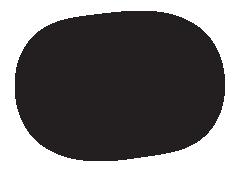
positive about next season’s prospects, and philosophical about this season’s light yields. “As far as a country is concerned, I think we probably need a reset this year just to clear the tanks that are full of last year’s wine.”
Matawhero owner Kirsten Searle says fruit ripened quickly in a season of low yields, low stress and high quality. “There are going to be some really good wines coming out of the region.” Annie Millton at Millton Vineyards says oscillating temperatures, from beautiful 30C days to “cold flicks of southerly”, have been an unusual situation to deal with, and another example of the weather extremes being felt by wine growers around the world. But the Chardonnay and Chenin Blanc they were picking the week of 11 March, less than a week into starting harvest, is “just beautiful”, she says. There’s a lot less of it than she would like, which is likely a consequence of last year’s deluge, followed by a mild winter, meaning a lot of buds didn’t mature properly. “Then a little bit of moisture through flowering and our crops are very low.”
The 2024 vintage could be one of Wairarapa’s greatest yet, says Foley Wines winemaker John Kavanagh, who heads the winery team at Te Kairanga. “The very dry summer with great heat and cool nights has given us excellent potential to make wines with great structure this year. I have high hopes.” After a series of wet seasons, the lead up to vintage has been a dream for winemakers, says Wilco Lam, Chair of Wairarapa Wine Region. “The excitement for the 2024 vintage is felt by everyone in the region after a super warm summer with really hot days and cool nights coming along at just the right time. It is a relief after a few tough years to have a beautiful year with very good quality grapes hanging in the vineyard.” Harvest came slightly early, with volumes expected to be 15% to 20% down on long term average, thanks to cooler temperatures at flowering. Wilco says cool nights in late February ensured grapes retained freshness, but “pronounced northwest winds” may lead to thicker skinned grapes. “This is an opportunity as well as a challenge to be managed in the winery.”



“I’m just kind of pinching myself that the weather is so good,” says Pernod Ricard’s New Zealand Group Winemaker Jamie Marfell, as he approaches what will likely be his first Easter off in 34 years. In midMarch, with the “brilliant” Marlborough handpick for sparkling wines all done, and the first Sauvignon Blanc crop in at 20.5 brix “on day one”, he predicts it will all be over before April. “We’ve never finished this early.”
“The fruit looked amazing; perfectly clean and certainly packed with great flavour and nice acidity.”Jules Taylor
The sparkling wine harvest started seven days earlier than expected in Marlborough, thanks in large part to low crop levels and “amazing weather”, adding to a trend towards earlier harvests. The wine quality
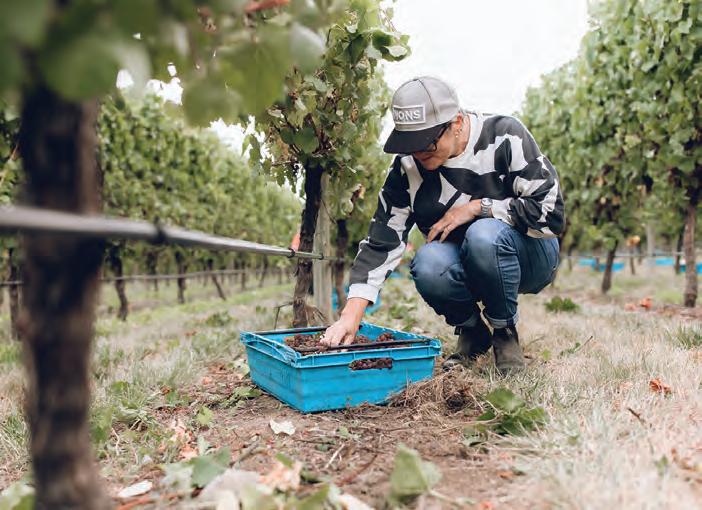
is going to be “outstanding”, thanks to those light yields, with drops of between 20% and 40%, depending on the vineyard and subregion, Jamie says. Cool spring weather affected all New Zealand’s wine areas, apart from Central Otago, “and we’re seeing crops down across all those regions,” he says, noting that Hawke’s Bay is further down
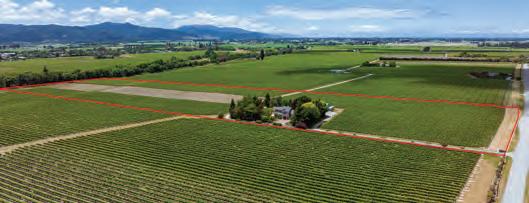

than Marlborough.
The low crops, paired with great weather, shrunk the interval between flowering and harvest, challenging spray diary management. “It’s made everyone aware of the short period between flowering and flowering sprays until bunch closure sprays and then harvest.” But the harvest itself has

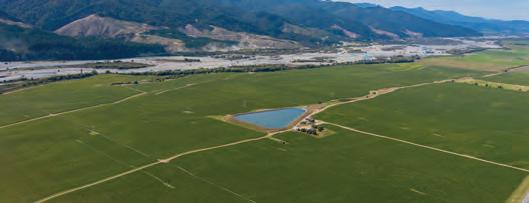
been one of the easiest he’s experienced, thanks to relentlessly fine weather that saw the region become tinder dry. The low crops and high quality will see the company directing a good proportion of its fruit to higher tier wines, to maintain roll dates in those brackets. Slowing orders for New Zealand wine are likely to result in a later than typical release for some wines, with 2023 wines in market longer, helping cover the shortfall of 2024’s vintage. “Once we roll from 23s to 24s… we’ll roll into a short vintage,” Jamie says. “But it’ll be stunning.”
Jules Taylor Wines kicked off their Pinot Gris harvest at Meadowbank on Friday 8 March. “The fruit looked amazing”, says Jules. “Perfectly clean and certainly packed with great flavour and nice acidity.”
Viticulturist Claudia Small is “extremely positive” about the season. “It has “the potential to be a really nice vintage”, she says in midMarch. The Small & Small Pinot Noir harvest started early and yields were down, with small bunches and lower berry numbers, but great quality, she says. Expectations are for things to get “very busy, very fast” when Sauvignon Blanc comes on, “but the geographical spread of our fruit means I am feeling pretty relaxed”. She says the very dry season has exposed issues with their irrigation, with leaks “extremely obvious”
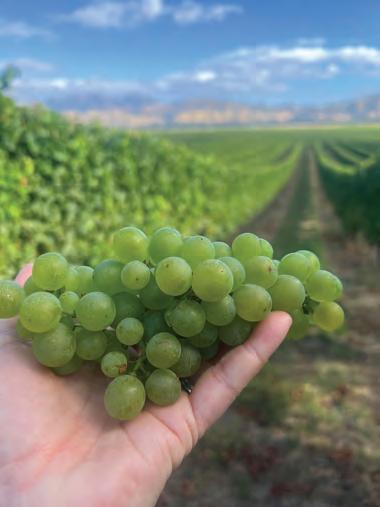
against the tinder dry landscape. Marlborough’s hot and dry season was exacerbated by a windy summer, says Fruition Horticulture consultant Jim Mercer, calling it one of the driest years he has seen in the region.
“It’s one of the best vintages, I think,” says Chris Seifried on day one of Seifried Estate’s Nelson harvest. “I’m really excited about it.” The company started with Pinot Noir on 12 March, and Gewürztraminer the second cab off the rank. “Things are looking wonderful; the weather forecast is looking good; the sugars are looking really good; it’s got lovely acids.” The crop is “on the lighter side” but not as low as he anticipated, with current estimates of a 10% to 15% drop on the average. “But we haven’t started on Sauvignon Blanc and that’s the biggie, so that might be a bit lighter.” They also have some areas that were badly frosted, with 90% of the yield lost. But with the rest of the vineyard just under normal, “we are pretty happy,” Chris says.
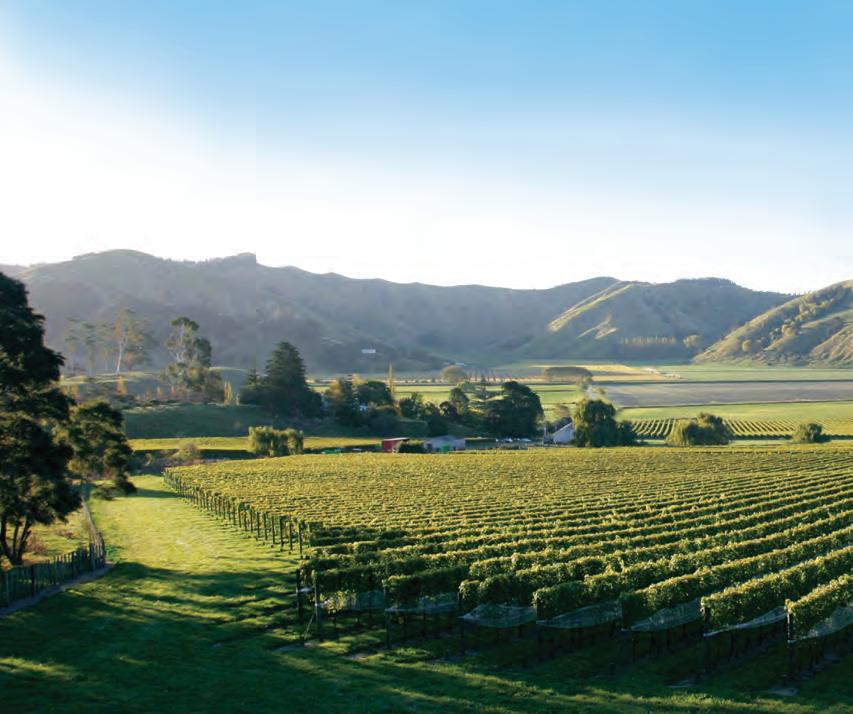
“Conditions ae incredible”, and “the quality is going to be exceptional”, says Mike Saunders from North Canterbury in midMarch, as harvest kicked off for many. Greystone’s Viticulturist says yields are coming in on target, “which was definitely on the more moderate size”, thanks to poor flowering, the impact of the dry weather, and in some cases a disappointing bounce back after a late spring frost. Mike estimates a 20% to 25% yield reduction on the long-term average, with some unirrigated blocks carrying bunches half the size of a normal year, “which makes it pretty tough to meet yield targets”. But with vines carrying small berries with great intensity and “amazing” flavours, the region’s winemakers are very happy, he says. “You cannot fault the quality; it’s going to be exceptional.”
Greystone’s High Wire project is set to expand across 25% of the North Canterbury vineyard, allowing sheep to graze those blocks year round. Viticulturist Mike Saunders says 1.5 hectares of vines are already under the innovative trellising system – which has a Y bracket at 1.8 metres high, extending 350mm from the post. This year another 12ha will be converted. The trellising has been tested and refined over three years of trials, so that the vines grow beyond the range of the sheep, unless there’s enough vigour for them to trail low enough. In that case the sheep nibble the ends, managing trimming, weeding, mowing and bud rubbing as they graze, leaving shoot thinning “and a wee tuck” for the human vineyard crews. This season Greystone did less shoot thinning and leaf plucking on the trial blocks than expected, but the fruit had great exposure, and ripened “really nicely and evenly”, Mike says.
The trial began with the desire to reduce tractor passes and diesel usage, and over the trial phase Greystone, which is certified Net Carbon Zero, achieved a 50% reduction in its vineyard emissions. The project has also
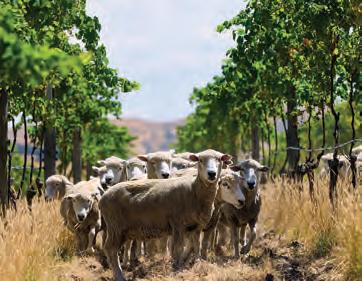
targeted enhanced soil health through cover crops, biodiversity, increased organic matter, and facilitating nutrient exchange with the vines, while mitigating soil compaction, Mike says. “The ability to incorporate the natural grazing habits of sheep in the vineyard all year round, along with the enhanced biodiversity fostered by multispecies pastures, has created an environment that enriches our vines in profound ways. It’s shown us that grazing behaviours can contribute to a more efficient nutrient cycling process and is helping nourish the vines and cultivating the growth of strong, resilient vines and root systems.”
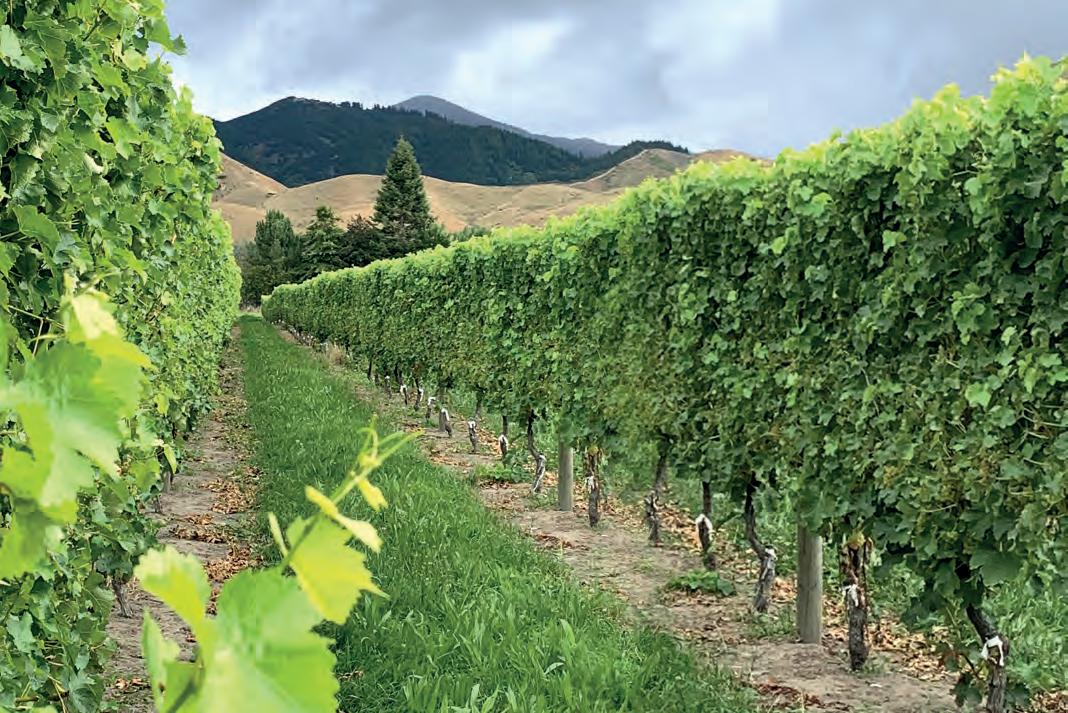
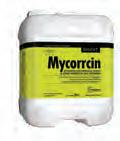


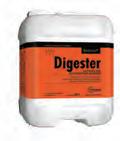
With a late frost last year, a hailstorm in February, and frost fighting in March, some subregions of Central Otago have been kept on their toes this season.
“They’re not all like each other, or else it would be easy and everyone would do it,” says Valli Winemaker Jen Parr on 13 March, contemplating a slightly early budburst and flowering, and the region’s early shift into autumnal hues. “Frost fighting in March is not normal. And it feels like we have lost the heat part of the season, so well and truly into autumn.” However, she anticipates “another great season”, noting clean fruit, good canopies, nice set, “and I think really good flavour development”.
Preparing for Valli’s 27th vintage, she says sparkling producers are well into harvest, and expects Pisa and Cromwell to be the first subregions to kick off the main harvest, running a little earlier than usual. For others, things may get “frenetic” after the Easter break. Jen says the unseasonal March frost seems to have been successfully fought, but she’s wary of the impact of more of the same. “The plants
won’t take too many cold shocks before they decide it’s time to be like bears.”
Winemaker Matt Connell says there have been challenges in the season, “but there always are”. Statistically, the temperatures are not as warm as the past few seasons, “but I am looking at what I’m tasting and think we’re tracking about the same”. And he’s optimistic about the vintage. “There
“We all know there’s a bit of wine floating around, so it has to be good. And the whole industry needs to focus on that really.”
Matt Connell
are great flavours there and I am really encouraged by how the vineyards are looking. I am just keen to get going.”
He too is seeing an early onset of autumn, and expects to pick around
a week earlier than last year, with the earlier ripening potentially influenced by winds throughout the season, “which has provided a bit more stress”.
Yields look good, depending on location, with some pockets that were frosted last year less abundant. “My message for people I am making wine for is obviously quality over quantity,” Matt says. “We all know there’s a bit of wine floating around, so it has to be good. And the whole industry needs to focus on that really.”
Grape growing in Waitaki is a challenging business, says Valli Winemaker Jen Parr. “But occasionally we get a slightly easier ride. And we’ll take it when we’re given it.” The tiny wine region flowered early, and harvest may follow suit. “Everyone over east is quite excited. It should hopefully be a bit of an easier year, with excellent results.”


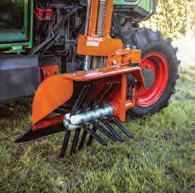
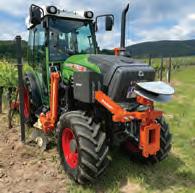

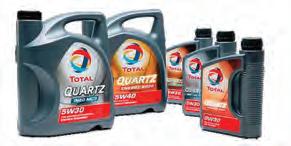


•
•
•
•
•

An eye watering amount of work goes into starting, growing and balancing New Zealand’s myriad side hustle wine labels. In this Focus feature we marvel at some of the many passion projects forged in the moonlit margins of busy lives.
Chateau Garage, with its ficus-covered turrets, is a hive of side hustle industry.
Beyond rustic barn doors, thick brick walls are stacked with barrels of Chardonnay, Cabernet Sauvignon, Rosé, and Syrah, each born of foraged fruit, opportunistic harvests, and a workforce of nearest and dearest. The Hawke’s Bay wine label is a family affair for consultant viticulturist Ollie Powrie and his wife Rebecca Moses, who’ve been making wine in their garage since handpicking an abandoned row of Chardonnay at the turn of the century.
“Within 30 seconds of tasting it, I rang Rebecca and explained that we needed some Cabernet in the garage this year.” The wine was the first commercial release for Chateau Garage and brought attention to the nascent label with extraordinary wines. The on-trade are increasingly devoted and enjoy being part of the garage-industry story, Ollie says, wondering whether this and other moonlighting wine projects provide something of a contrast to commercial winemaking.
and growing grapes, and by 2007 he was Chief Viticulturist for Villa Maria, where he occasionally lamented the handover of his grapes at harvest. The garage projects were a perfect opportunity to “complete the cycle” and make the wines he wanted. Ollie left Villa Maria in 2022 and later that year the family moved to Italy for seven months, where he did a harvest in Chianti “and had so many cool experiences in wineries”, returning home with a bolstered sense of adventure.
Now building, servicing and selling Croplands Quantum Vineyard Sprayers Croplands Sales and Service Agent for the Marlborough Region
Spray Equipment Specialists at Agrivit.
Their hobby turned hustle in 2020, when Two Terraces grape grower Ian Quinn called about a beautiful parcel of Syrah orphaned by the Covid-19 lockdowns. Ollie – then viticulturist at Villa Maria – knew they were sorted for Syrah in his day job, and that the complexities of a pandemic vintage meant few people were likely to adopt more fruit. “So we agreed that I would take half of it and the other half he would make into wine at another winery.” The result was the “amazing” Two Terraces 2020 Wild Ferment Syrah, and the creation of a label that juxtaposes seriously good wines with their modest abode – humble in all but its curious turrets.
“Within 30 seconds of tasting it, I rang Rebecca and explained that we needed some Cabernet in the garage this year.”
Ollie Powrie
Jeremy Watts | 021 446 225 | jeremy@agrivit.co.nz | 03 572 8787 | www.agrivit.co.nz
The next year Ollie got another call, this time from Bob Newton at the iconic Cornerstone Vineyard on Gimblett Road.
Ollie and Rebecca’s first foray into foraged fruit and garage winemaking was in 2000, with handpicked Chardonnay and seasoned oak barrels in their Napier Hill garage while Ollie was studying at EIT. They went on to make small batches of wine every year the opportunity arose, with “dark brooding reds, a fragrant Cabernet Franc, and even a noble botrytis Viognier”. Ollie’s studies “hooked” him on managing vineyards
Selling, building and servicing Croplands Quantum Vineyard Sprayers. For more information or to order your next Quantum Vineyard Sprayer. Contact the crop protection specialists at Agrivit.
Jeremy Watts | 021 446 225 | jeremy@agrivit.co.nz 03 572 8787 | www.agrivit.co.nz
On the day we talk he is walking down a row of Hawke’s Bay Montepulciano, somewhat distracted by garage possibilities. These grapes, sitting pretty on the edge of veraison, could be one of the four Italian reds he plans to pick in one day this vintage, then co-ferment in the amphora that recently arrived from Hungary, sitting quietly in a corner of the garage. He’s also thinking of Albariño, with the new collaborative Albariño Brothers project – a side hustle to the side hustle – delving into four versions of the variety. It’s all part of reaching for the potential of Chateau Garage while remaining within the confines of its thick brick walls. “I guess there are lots of little opportunities out there,” Ollie says. “And if you are open to them, it makes it a lot of fun.”
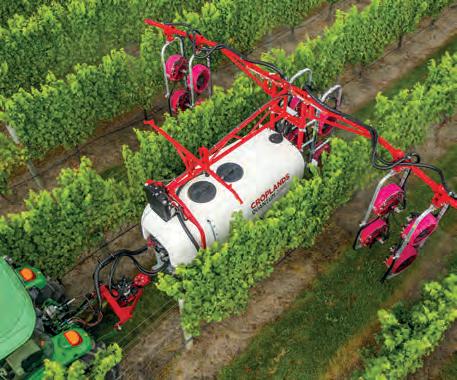
Wairarapa winemaker Jannine Rickards made a “tiny” batch of her own wine in 2017, on the moonlit edge of her harvest job at Julicher. Later that year she became winemaker at organic wine company Urlar, and Huntress grew incrementally, as a passion project that poured her personality – including as a hunter and forager, increasingly engaging with te ao Māori – into wines that hark back to nature. Huntress wines, Jannine says, are “wild, pure and honest”, fermented with indigenous yeasts and handled as little as possible, so they can express the soils and environment they come from.
The rich authenticity of the brand captured attention as it grew to a few tonnes, then 4 tonnes in the 2020 Covid-19 harvest, and 13 tonnes last year. Meanwhile, Jannine has harnessed help from family and friends to “navigate” marketing and business plans. “It’s such a community driven thing,” she says of the abundant support she’s received, including from her parents, Ata Rangi Winemaker Helen Masters, winemaker and MBA graduate Francis Hutt, and Claire Edwards, who worked in wine marketing before founding the Tora Collective seafood company in Wairarapa. “I think there are a lot of small businesses who want to see others thrive.”
Wines like the Waikura Rose, named for the red glow in the sky, anchor her brand to its place and personality, as do Jannine’s food matches, like the venison heart and onions she suggests matching with the Waikura, or creamed paua, harvested from the Wairarapa coastline, paired with the Waikoa white blend. Jannine says it’s increasingly important for the storytelling


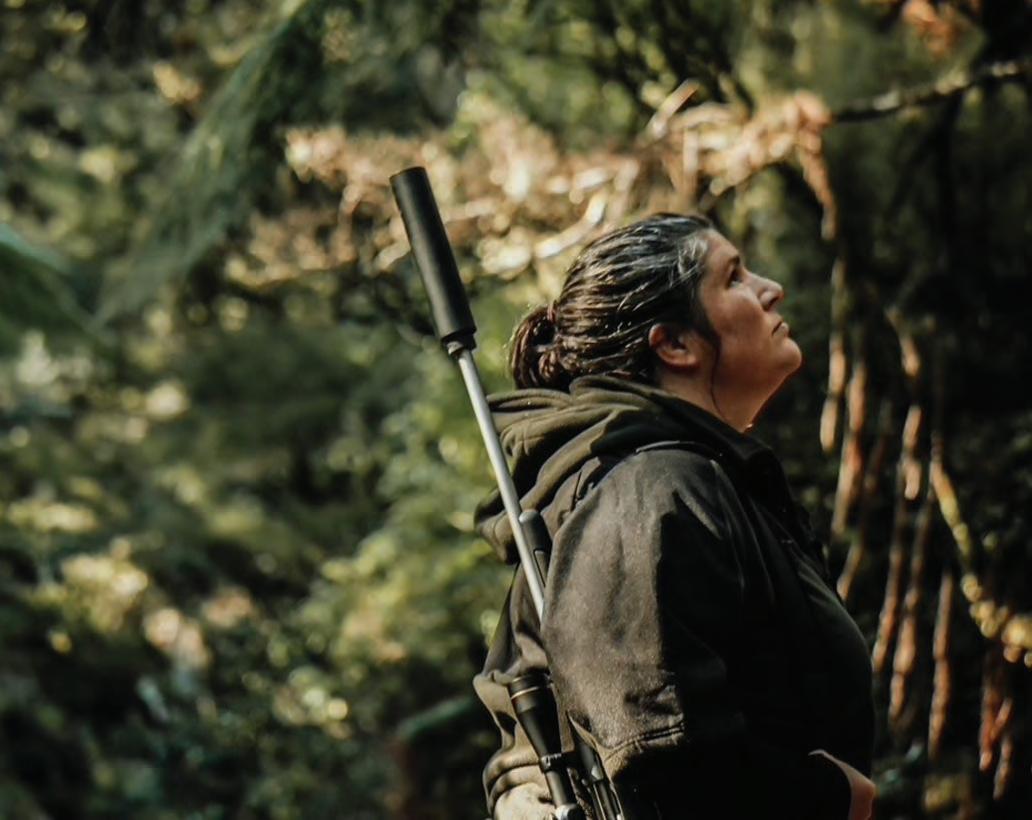
behind a brand to be real, “and maybe that’s one of the beauties of a side hustle – that the winemaker or grower is so connected with every aspect of the brand that it is intrinsically authentic, because they’re right there, hands on”.
That hands-on-ness could be deemed an advantage for an employer, as a moonlighting winemaker or viticulturist gleans a greater understanding of the complexities of running a wine business, Jannine notes. “So, you are a bit more knowledgeable on the reality of running a wine business. I think that is positive for Urlar, that I have more of an understanding to how many costs are involved and some of the logistical challenges around a wine business.”
It’s those same challenges that make Huntress something of a cautionary tale, because anyone considering a side hustle
needs to consider the “huge commitment”, she says, reflecting on invoicing at midnight to ensure her day job doesn’t suffer. “Unless your whanau or partner are on the same page and support what you are doing it will put strain on these relationships.” And while the plan might be to stay small, there’s quickly a realisation that without growth there’s little chance of getting a return on the huge investment of time and money. “I think also you get to a point where if you don’t jump off and fully immerse yourself in it, you will never see the full potential of what it might be.”
Jannine is grateful to be able to make her own wines while working full time. But as Huntress has grown, she has become aware of a greater tension between her day job and her side hustle, which is often what people want to talk about. “It is a tricky balance to find.”
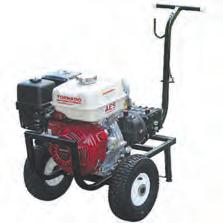
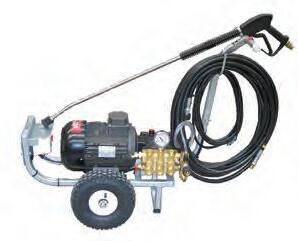
In 2016 Murray and Rachael Cook weighed up plans to renovate their Blenheim villa or invest in a long-held dream of growing their own wine label. “The more we were in the industry the more we realised it had to start in the vineyards,” Rachael says eight years later, from a tiny hand-hewn vineyard overlooking the Brancott Valley.
Choosing vines over villa has meant an eye watering commitment from the Cooks, who spend their days working at Dog Point Vineyards and the hours left over on their 0.29-hectare block, oscillating between the largest certified organic vineyard in New Zealand and the smallest. “Having our own label we were keen to push the boundaries and not do the norm,” Murray says. “It’s Chardonnay, not Sauvignon, it’s high density, it’s hill slope, and it’s organic and biodynamic from inception as well. Everything is probably the hardest way to do it.”
Every post here was hammered in with brute force, every irrigation trench dug with a spade, and every row planted, ploughed, plucked, picked and pruned by hand. “I still look at this and think ‘how did we actually do this?’ Because it is so much work,” Rachael says, looking uneasy as Murray discusses the opportunity to plant a small Pinot Noir vineyard above the Chardonnay. But they’ve found a rhythm, Murray says, “and we’ve found ways to make it work better for us”. That rhythm includes Rachael driving a mower, or skidding down the hill to weed, and Murray following behind with a Boisselet hand plough, or a hoe thats handle is a fraction of its 2017 length. “It’s very manual, because of the scale,” he says. “You cannot overcapitalise with heaps of expensive equipment. So Kiwi ingenuity comes into it as well.” That philosophy is
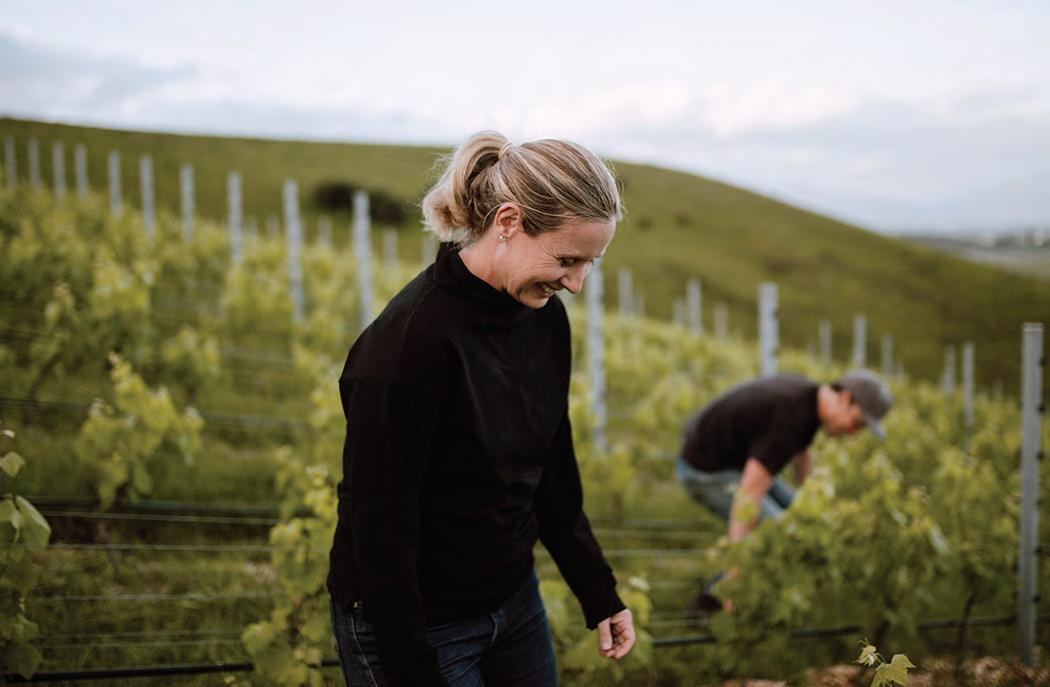
reflected in the name Nous, which some days refers to the ancient Greek term for intellect and intuitive thought; some days for number 8 wire common sense; and some days simply as French for ‘we’.
They bought this “magic” 4ha block in 2017, with a house site looking west to the Omaka Valley and, just over the ridge, an east-facing clay hillside grazing cattle in the Brancott. “As soon as we saw it, we knew it was a special place,” Rachael says. They wanted something small enough they could manage on their own, and that’s exactly what they’ve done, with help from their daughters, Chloe and Maddie, and a “motley crew” of livestock, with three Wiltshire rams managing the winter weeding, and two Red Devon cows –Ginger and Nutmeg – providing necessary resources for the vineyard’s biodynamic preparations.
Murray is a winemaker and Rachael a marketer at Dog Point Vineyard, and the company’s founders have been part of the conversation from the beginning, he says. “It needs both parties to think about
The secret to the future success is taking care of a vital part of the growing system – the soil. Working with nature through planting a diverse range of plant species to naturally overcome today’s challenges

it and come up with a plan and make it work.” In 2021 the Cooks made one barrel of wine from their young vines, leaving the winemaking to indigenous yeasts and meticulously tended fruit. “We knew everything we had done within the vineyard side of things was right in terms of what we wanted to do from a quality aspect,” Rachael says. They watched and tasted and bottled, then waited eight months before deciding to release their first Nous, with 300 bottles swiftly snapped up. “People have followed the journey with us and were as excited to see the bottle of wine as we were.” By 2022’s harvest the vines yielded a little over a barrel, and last year two barrels, with the wines destined for the likes of Milbrook, Blanket Bay and Arbour, and to customers quick enough to get in directly.
And for all the hard yards there’s seldom a time they’d trade idyll moments in a villa for miniscule winemaking on a hill. “For me the interest in the small-scale stuff is really where my mind is at and what I am attracted to,” Murray says. “You live and breathe it.”
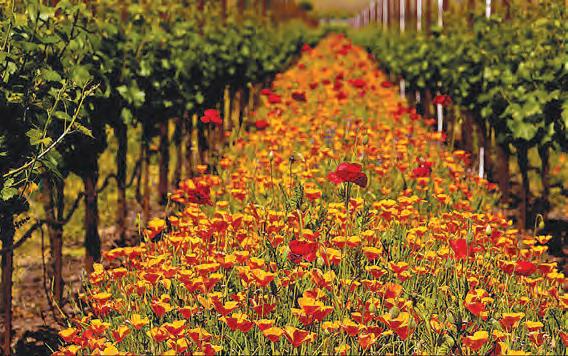
When Donald van der Westhuizen was studying ecology at university, his father urged him to switch to viticulture. “I used to say, ‘mate, you are dreaming. We are never going to have a vineyard’.” It turns out his father was right, Donald admits, walking through Moko Hills vineyard 15 years later, talking of chickens, truffles, geckos and vines on this unique 40-hectare Bendigo block in the foothills of the Dunstan Range.
These days he’s a viticulturist too, but it was the ecologist that found and fell for this land in 2016, when he saw a for sale sign and parked up in his van for the night. He named it the same day, after finding gecko (mokomoko) under some rocks. “The site itself drew me straight away,” Donald says, talking of the view over Lake Dunstan, the rocky outcrops above, and the remnants of kōwhai and tōtara, once prolific in the area. It is “super rugged” and beautiful, he says. “With a trained eye you can see the historical degradation on the land, in terms of invasive pests and weed species, but also the potential as well.”
He and his parents had been looking for properties for about a year, motivated in part by Donald’s desire to tackle an ecology restoration that would yield tangible results. By 2017 they’d decided vines were a way of earning from a portion of the land, but the reality was daunting. “We have always been interested in wine, but when we decided to plant grapes I realised, ‘holy shit I don’t know what I am doing’.” He studied in Auckland while they planted, going “straight in the deep end really”, then gathered experience on overseas vintages, before beginning work with James Dicey at Grape Vision in Central Otago. Working as a viticulturist off site “puts bread on the table” but is also rich with learning and insights into a range of sites, Donald says. Meanwhile, James “has been
Prophet’s Rock and Scapegrace, already highly regarded for their wine and gin respectively, have combined their talents to create two limited release single vintage vermouths based on Prophet’s Rock wine, Scapegrace wheat spirit, and predominantly Central Otago botanicals. The two recently became neighbours when Scapegrace built their Bendigo distillery next to the Prophet’s Rock Rocky
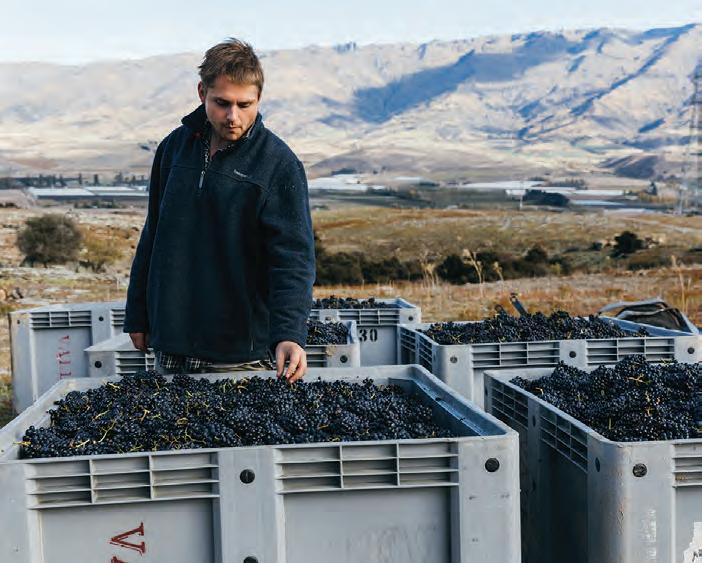
insanely good to me”, with advice, machinery and labour a phone call away, he adds. “It wouldn’t be where it is without him.”
Despite being immersed in the work and culture of wine, the 9ha of grapes are “one small aspect” of Moko Hills.
The van der Westhuizens have planted fruit trees, established bee hives, and targeted the pests that ravage the land’s fauna and flora. “I have seen a massive change in vegetation just by removing rabbits,” Donald says. He works with a farmer to graze sheep in return for lamb, is delving deep into restorative viticulture and agriculture, and is currently contemplating a few cattle. A few days before we speak, he has picked up another 10 chickens, doubling his brood, with a weekly egg subscription now underway. “A big thing for me, which I am going crazy into, is sustainable food production.”
His plethora of side hustles, alongside
a day job, make for a busy life, he admits. “Everyone thinks it’s living the dream, which it definitely is, but it is by no means easy.” When he arrived that dream was to take the land to an original version. But Donald now sees the restoration work as “integrated between us and nature”, with space for ecology and production.
“Viticulture is actually probably the lowest impact horticulture and agriculture system within Central Otago, with very minimal water use and, depending on your viticulture methodology, very low pesticide and herbicide, with good opportunities to create soil carbon and biodiversity.”
That integration is clear on every bottle of Moko Hills wine, with beautiful watercolours that celebrate the ecosystem it’s grown in, portraying kōwhai and native bees, gecko and corokia. “It’s a part of the story,” Donald says. “And you can taste something from this place.
Point vineyard. Winemaker Paul Pujol quickly seized the opportunity to further a long-held desire to make vermouth with a strong fine wine. The dry white vermouth is made with Prophet Rock’s Pinot Gris aged in barrel on gross lees for around 10 months, with elderflower, wild thyme, dandelion, kānuka and grapefruit botanicals, while the red is a sweeter style based on the Rocky Point vineyard Pinot
Noir, aged eight months in barrel, with rosehip, cherry, horopito, kanuka and orange. Pujol says the small parcel, single vintage approach not only reflects the ethos of Prophet’s Rock but is also a key part of the vermouths. “I wanted to make something that was still quite ‘winey’, reflecting the vineyard and vintage, that would drink really well by themselves and work in classic cocktails.”
Hawke’s Bay’s Saorsa likely flies under the radar for most wine drinkers. But this tiny, distinctive label focusing on Syrah and Viognier elicits praise and excitement from those in the know. It’s a passionate labour of love and reflection of deeply held wine philosophies for founders Alex Hendry and Hana Montaperto, which they tend with fierce devotion.
“Not the smartest financial decision for a small-scale side hustle project but I feel that the modern world has moved on from or forgotten the importance of time in wines.”Alex Hendry
Alex’s day job is winemaker at Linden Estate, while Hana is a qualified sheetmetal engineer. Saorsa (pronounced Sa-or-sha) is a Gaelic word that encompasses freedom, liberty, salvation, redemption, reflecting the label’s ethos. “I have to be careful here not to end up on a two-day rant,” Alex says with a wry laugh, when asked about their approach. “For us Saorsa is about honesty. I never wanted a wine label to be about myself or what we can do, but rather one that shows exactly where the fruit comes from – the vineyards’ uniqueness and beauty. Our aim is to take fruit from the best sites and just let it be.” This means a hands-off approach to winemaking too,

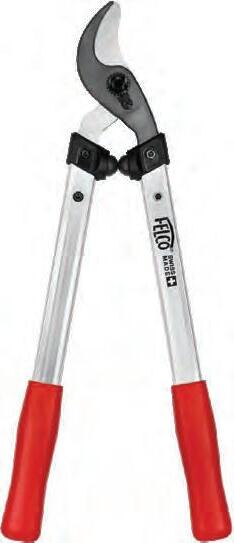

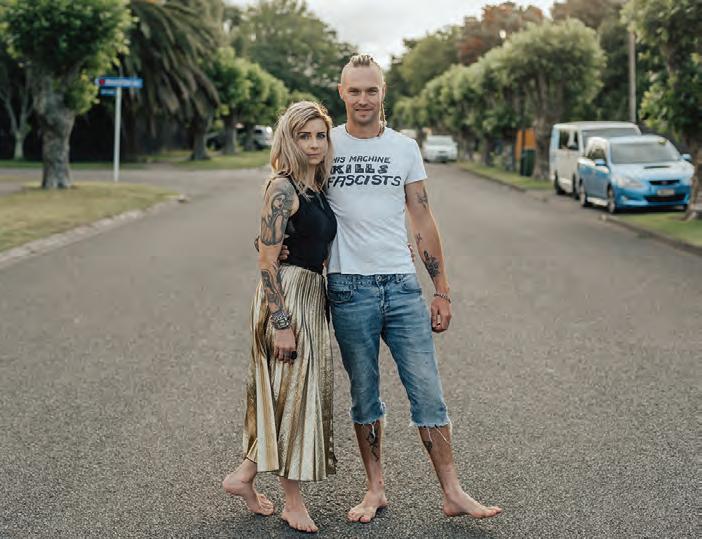
using time and the careful use of oxygen to do everything that is required, he adds. “Not the smartest financial decision for a small-scale side hustle project, but I feel that the modern world has moved on from or forgotten the importance of time in wines. The aging of wines for us is as important as the vineyards themselves. We use sulphites in our wines as it is used in the vineyards too, but no other additions. The wines are unapologetic in style and don’t always fit into a mould that you would expect from New Zealand wines – not in an experimental or strange way, but just from letting them be what they are.”
While making Syrah was their ultimate goal, a chance opportunity to harvest a small plot of Gimblett Gravels Viognier around 10 years ago became the genesis of Saorsa. “I was never the biggest fan of New Zealand Viognier as a style but once we started producing it, it really captivated us.
A difficult variety to say the least – growing, crop levels and even selling – it has taught us so much about how we handle all our wines.”
Their passion for the vineyards and wines, and the freedom of expression they allow, makes up for the hard yards. “Running a company as well as working full time and fitting it all in with family life as well presents the greatest challenge. Time, and being time poor. But there’s the beautiful people we meet and get to work with, some of whom we wouldn’t have met without a project like this. Seeing people enjoy the wines we have worked tirelessly on is always great.” The work goes on, Alex adds. “It’s not an easy industry to work in, and I will say running a side hustle is also not for the faint-hearted. The workload can be punishing at times and we all end up questioning why we do it, but it’s what keeps artisan winemaking alive.”
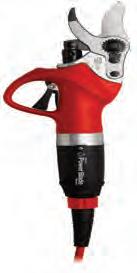
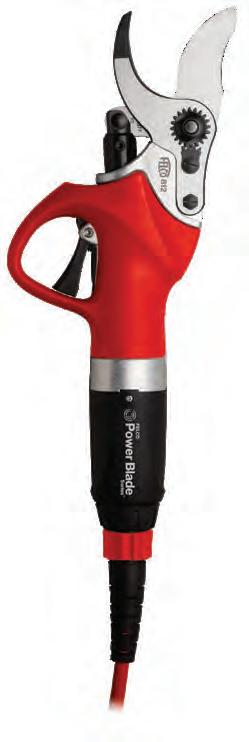

Vandal was born from the desire to capture the moment when wine is at its ultimate drinkability. “There are times in the winery when you sample a wine in its raw state and think to yourself ‘I wish I could bottle that now’. Vandal allows us to do just that,” explains an unnamed co-owner. Let’s call this source, Agent K.
“We had all reached a point in our careers where we wanted an additional project.”
Agent K
Vandal is an unsigned identity. It could be described as a clever marketing plan but it is also out of respect for the three co-founders and winemakers’ formal employers. It provides the trio an “invigorating creative outlet”, says Agent K. “We are all very happy with our day jobs, but Vandal is a cool collaboration that adds an extra dimension to our week.”
As side hustles go, it has also been very successful. “We currently trade in six markets and are enjoying the response from consumers and trade alike.” When asked how they keep their identities a secret when visiting markets, he admits that they don’t. “However, our stockists like becoming ‘part of the gang’ and weave our meetings into their stories with mystery and intrigue.”
Vandal was established in 2016 after conceptualising the brand for more than a year. “We had all reached a point in our careers where we wanted an additional project,” Agent K explains. “Over a few beers, we talked about that moment in the
Jordan Hogg always had a hankering to make his own wines, pushing boundaries and “showcasing another side of Marlborough”. When he joined Rock Ferry Wines in 2020, on the brink of Covid-19 restrictions, the company gave him the opportunity to give it a go, with Atípico launched the next year. Its first wine – Under the Plum Tree – comes from a small block behind the Rapaura winery, planted with Pinot Noir, Pinot

winery when a wine shone. We nutted out the details of bottling that raw product, the varietals we had access to, and the branding… It took a bit of time before the name and the concept of Vandal was fully agreed upon. It still evolves as we go and that adds to the fun.”
Vandal was launched with two wines, Gonzo Combat Rouge and Gonzo Militia White. Rouge is made primarily of Pinot Noir with a portion of Viognier. “It’s a crunchy Beaujolais-esque red wine,” Agent K says. “There is no significant oak use, just good fruit and hands-off winemaking. The style leans towards a youthful bottling and we bottle unfined and unfiltered.” The field blend, as the name suggests, is a broader selection of varietals and varies year to year. “Historically, it is Viognier dominant and incorporates up to another seven varieties, such as Pinot Noir, Malbec, Pinot Gris and Sauvignon Blanc. There is plenty of skin contact with this wine. We want it to be unique; we want it to capture the imagination.”
Gris and Pinot Blanc. “It used to be an orchard, so there are some plum trees dotted throughout in a nod to the land’s past. I decided to make a wine around this story, so with family and friends we handpicked the three varieties and put them straight into the fermenter in the vineyard. The wine is a co-ferment field blend, fermented in the vineyard, which I tongue in cheek coined vinsitu. It is definitely atypical.” His key focus was making something delicious with an interesting story “while walking the
A few years into production, Vandal added Resistance Sauvignon Blanc and Gonzo Pet Bat (a pétillant naturel) to its range. “The Sauvignon Blanc is probably our trickiest wine to sell. New Zealand, and Marlborough in particular, is renowned for its signature style of Sauvignon Blanc and this one doesn’t fit the mould. We love that but it’s also a double-edged sword.” Resistance Sauvignon Blanc is hand harvested, skin fermented and incorporates whole bunch. “There is funk but it is definitely recognisable.”
All Vandal wines are fermented dry and free of malic acid. “We are pro minimal intervention, but we also have the ability and inclination to manage risk,” Agent K says.
“There is a fine line between quirky and drinkability. Vandal is about drinkability,” says Agent K. “We want people to imbibe our wines and we want them to enjoy the experience.”
tightrope of avoiding being gimmicky.”
The tiny label is a family affair, with his brother’s partner Pippa the artist behind the labels, and a family crew for picking, bottling, labelling, waxing and packing. “It is hand-on and labour intensive, but we love it.” Jordan is “incredibly proud” of Marlborough wines, and wants to showcase the diversity and quality that is possible in the region, beyond its Sauvignon Blanc. “There are other stories to be told and we want to tell them with the wines we love making.”
“It’s all about producing benchmark Hawke’s Bay Chardonnay… not necessarily the biggest or the best, but wine that people around the world will hold up as great example of Hawke’s Bay Chardonnay.” Dave Nash is outlining the vision that seeded Helio, the company he created with husband and wife winemakers Matt Kirby and Sarah Little. Dave and Matt met in 2018 while filming New Zealand wine film A Seat at the Table, bonding over their mutual love of Chardonnay, and musing about a little project that’s raison d’etre would be making great ones. Dave didn’t think much would come of it until Matt called a few weeks later to say he had found the perfect vineyard to lease. What had been an interesting conversation suddenly got real. Helio (named to reflect the connection between wine and the sun) was launched in the first 2020 lockdown, and Sarah quickly came on board, as a driving force in vineyard management and winemaking operations.
As Chardonnay-obsessives around the same ages and stages of life, Helio represented the chance to have some skin in the game and to risk a few different things from what their day jobs offered, including Matt’s Chardonnay-intense role as Chief Winemaker for Clearview Estate. While Chardonnay is at its heart, Helio has expanded to encompass a Tempranillobased rosé, a Hawke’s Bay Syrah and a Martinborough Pinot Noir. Dave says the chance to buy Syrah from Warren Gibson and Lorraine Leheny of Bilancia, and Pinot Noir from Larry McKenna, was simply too good to turn down. “When you get to work with great growers, why try to do it better than what they do?” This vintage they will also be picking Gamay from Hawke’s Bay’s Two Terraces Vineyard.
While their focus on quality fruit and wines is clear, the rest of the strategy has been a little more ad hoc. “We initially thought it would be just family and friends indulging us, but then quickly sold-out pre-release,” Dave says. They
have subsequently built a solid directto-customer following, and have an unexpected but burgeoning on-premise presence. And while they could sell all their production domestically (currently around 1,500 cases), they are building a tiny export portfolio based upon keen buyers in Japan and the United States, with the United Kingdom soon to be in the mix. Dave presents this as mostly via people approaching them, but there’s no doubt that he, Matt and Sarah are savvy and enthusiastic operators.
Helio also benefits from a bit of benign neglect, Dave says. “We never get a chance to overthink things – be it picking, winemaking, marketing or sales, and we have to be a tightknit unit to pull that off. We always seem to have more than three opinions on anything, and at times we have had some robust, um… discussions, but any differences are minimal as ultimately, we are all focused and united on the same goal. There are no egos here”. No egos, just great Chardonnay.



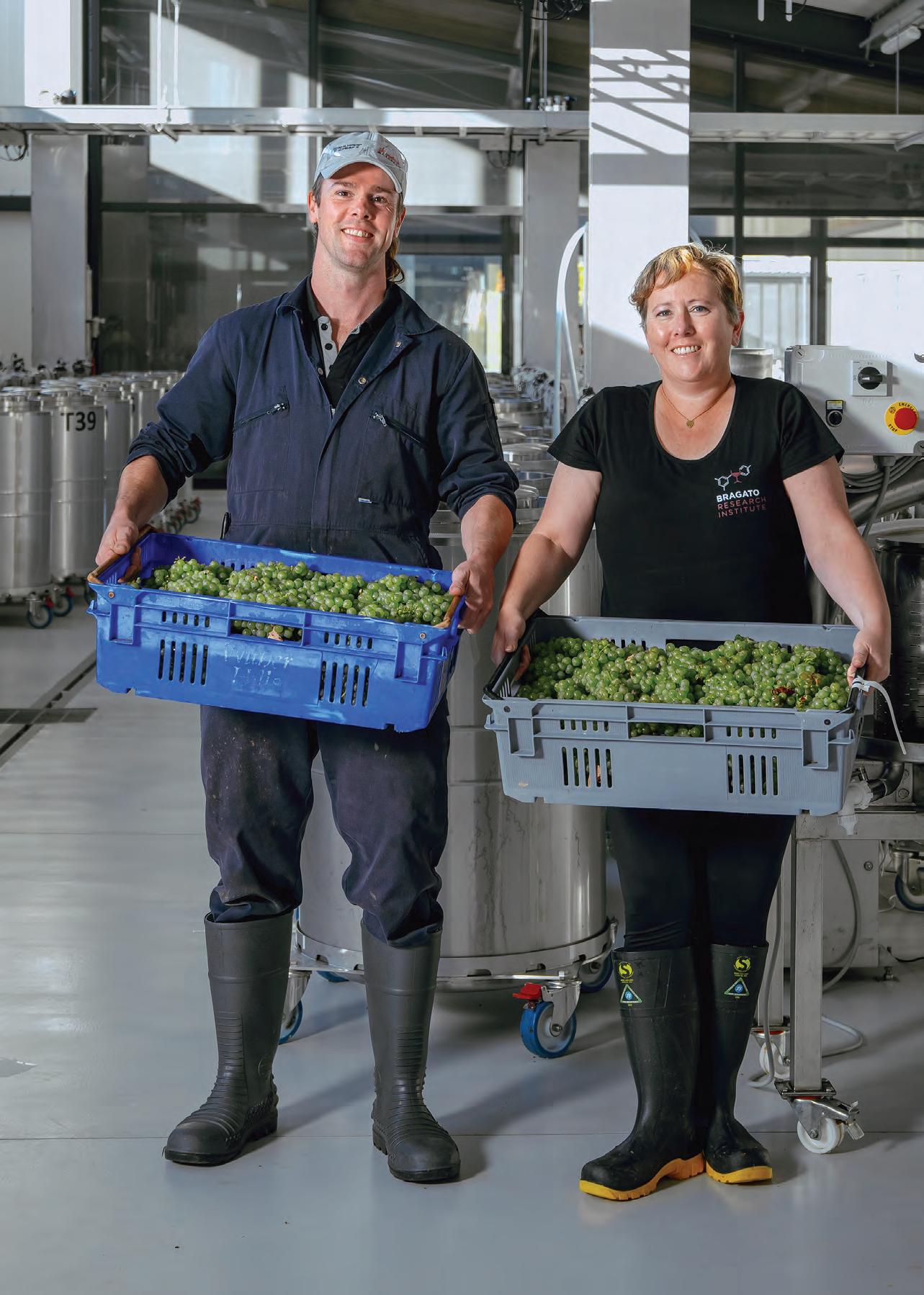
Winemaker, marketer, communicator and educator Ngarita Warden is diving deep into wine research, with 270 ferments under the microscope this vintage. “It’s going to be really busy,” says the Bragato Research Institute (BRI) Research Winemaker, as small parcels of grapes come steadily in, filling 17 litre tanks for some of the 22 commercial and four major BRI trials this year. Wine and viticultural research is on an upwards trajectory in New Zealand, she notes. “Like any industry, we need to be a lot smarter about what we do.”
This Blenheim-based role is something of a full circle for Ngarita, who followed a double degree in microbiology and zoology with postgraduate viticulture and oenology studies at Lincoln University in 2002. She went on to do vintages in New Zealand and Australia, a stint as a wine buyer in the United Kingdom, and work as a research and development coordinator at the Wine & Spirit Education Trust (WSET) in London. When she returned home, Ngarita worked in wine production and as a cellar door manager and marketer at Matua in West Auckland, and at Mudbrick and Te Motu on Waiheke Island, while also teaching WSET qualifications.
She joined the BRI team in February 2023, after a stint teaching winemaking and wine chemistry at Nelson Marlborough Institute Technology. She loves her role, which includes working with
BRI’s commercial clients, such as yeast companies, agrichemical companies and wineries. “I also make wine, test it, and run a sensory panel to blind taste the wine and provide valuable feedback.” She also tests different antioxidants and thiol levels, which are important for Sauvignon Blanc. “We have capacity for 230 ferments each vintage, but this year I will have 270 ferments, which technically exceeds capacity,” Ngarita says. “But I am confident, because it includes a significant number of red wine ferments this year, which don’t take as much time in tank so we turn tanks.”
Other research projects include investigating colour in Pinot Noir and mitigating mildew aromas in powderyimpacted fruit. “The best thing to do is to discard fruit if it has powdery. But if you can’t, there are ways to deal with it. One thing we have found to be effective is the use of tannins in the fermentation. You’re never going to get rid of the powdery mildew taint but there are ways to minimise it.”
One of the most fascinating aspects of her work for BRI to date has been quercetin levels, Ngarita says. “That has been an increasing problem in the last few years. In hotter vintages with less cloud cover, we start to see quercetin instability in some wines. We have found that the biggest impact we can make on this problem is in the vineyard by giving fruit a bit of shade. Drought conditions can impact it as well, so ensuring there is enough water is another helpful factor. But the main issue is that this instability often doesn’t appear until the wine is in the bottle, so we need to look at whether the risk factors suggest it is going to be a risk and to take mitigation steps, if we think that’s the case.”
Ngarita is also excited by research into varieties such as Albariño. “We’re looking
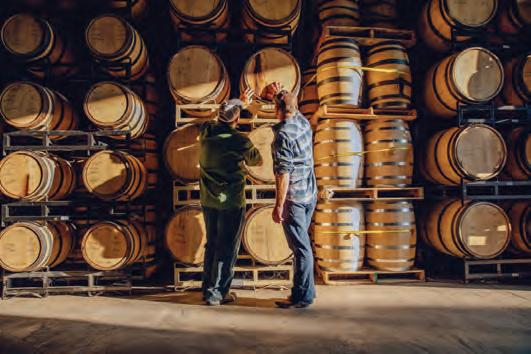
at it as a similar but different variety to Sauvignon, and predicting weather patterns and what’s going to happen in the future in terms of humidity and rainfall,” she says. “The aim is to consider whether this is a good alternative to Sauvignon Blanc because it’s a much more disease resistant variety, which has developed to grow in conditions with about double the rainfall that we have in its Spanish homeland.”
Beyond the work in the winery, she is excited by BRI’s seven-year research programme to create greater diversity in Sauvignon Blanc, being undertaken with BRI partners Plant & Food Research and Lincoln University, with the goal of creating 12,000 new variants to build greater resilience into the wine industry. “We pretty much have one clone of Sauvignon Blanc in this country and it is nearly all planted on the same rootstock. If something goes wrong, we are very exposed,” Ngarita says. “The programme will select improvements in traits such as yield, resistance to fungal infection, frost tolerance and water use efficiency. We want to have vines that either maintain the iconic Marlborough Sauvignon Blanc wine flavour and aroma or offer novel Sauvignon Blanc styles to expand market opportunities.”
Her passion for the science of wine is perfect complement to her love of the final product. The WSET tutor has been teaching people how to drink wine since 2007, and notes that the qualifications take a winemaker’s understanding to the next level. “Knowing why a wine tastes the way it does in terms of terroir, history, oak and all the other factors that go into it all helps so much when discussing wines and making decisions on future wine styles or winemaking choices in the winery.”
We don’t transport goods, we transport dreams.
A one-year Erasmus Programme in France in year three of an agricultural degree introduced Victoria Raw to the wine industry, and changed her life. “I had to choose an elective and was told about oenology. I had no idea what it was and had to have it explained to me,” says the Research Associate at Plant & Food Research. “Winemaking seemed like a good idea. I had engaging teachers and great classmates. We got into visiting vineyards and tasting wine. Agriculture became quite fun and I realised I wanted to take it further.”
Her career was now destined to change direction. “I became interested in vines and their growth, rather than the end product, rather than the selling and marketing. A doorway had opened and I thought it might be an interesting field to work in.” Victoria

returned to Edinburgh to work in a wine shop for a year but the science of growing held her attention. “I knew that if I wanted to take wine and vines seriously, I’d need to focus on viticulture.”
A worldwide search for the right programme led her to Adelaide, where she completed a graduate diploma in viticulture in 1999. A short plane ride across the Tasman in 2000 brought her to Corbans Wines, where she worked directly in the vineyards and the nursery. Victoria then moved into more research and development
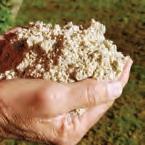
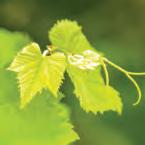
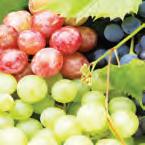

as the viticultural technician, which brought her into contact with Plant & Food Research (then HortResearch) and the team using the vineyards for research.
In 2006, Victoria moved to Plant & Food Research. “My interest has always focused on the research, delving into the deep, asking questions and not always getting the answers, and being surrounded by other people with the same interests.” She also describes herself as a bit of a weather junkie, which makes sense when you think about New Zealand and the United Kingdom: islands that experience a lot of interesting weather. HortResearch helpfully brought together Victoria’s interests in research and weather when she was introduced to Rob Agnew (see facing page). VineFax, as it was first called, began in 1997, going out to subscribers in Marlborough using data from 10 HortResearch weather stations and two others, with a focus on Sauvignon Blanc. In 2014, it found a new home with New Zealand Winegrowers. Coverage extended to vineyards and climate in Gisborne, Hawke’s Bay, Wairarapa, North Canterbury and Central Otago, and then to Nelson, creating a key tool for growers in those areas. Today, it covers a range of
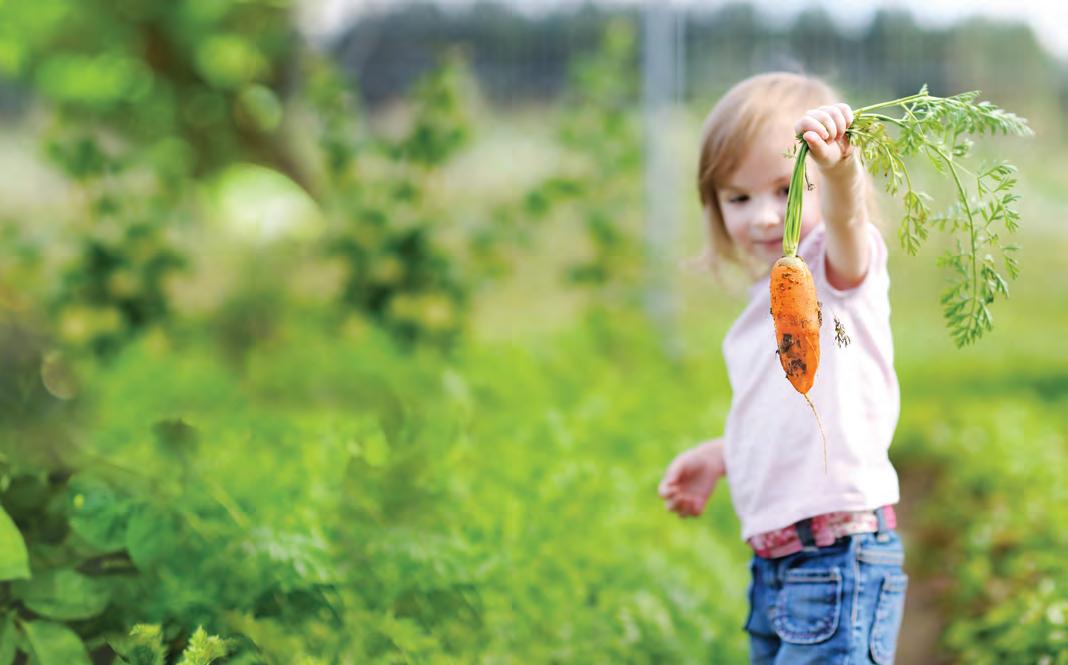

topics, from disease management through to flowering and year-onyear comparisons for Chardonnay, Pinot Gris, Pinot Noir, Merlot and Sauvignon Blanc across 31 monitored blocks.
Victoria has worked on VineFacts alongside Rob for the past 18 years, collating and writing for the regular Friday dispatch. “We are growing exponentially. We began as a subscriber service; now we’re on a website. We were Marlborough-only, now we’re across seven regions.” This growth has created an invaluable data resource. “We now have 20 years of Marlborough data and 10 years for those other areas. We can compare seasons; we can see how the season is tracking in different parts of New Zealand for different grapes. Growers can look at the data and work out how they’re tracking, are they late or early with flowering, when did harvesting begin?”
Where to from here? Victoria says she’s not taking over from Rob Agnew, who is retiring from Plant & Food. She is simply continuing what he started, and looking at where technology such as an app might take them.

“We’ve just had the first decent shower in three months,” says Rob Agnew when we call him. He reckons the top of the south is in drought; the hydrologist at the local council says not. Rob has been watching Marlborough’s weather for some 38 years and writing about it in VineFacts since 1997. Over those years, he and his team have shepherded VineFacts into a ‘must have’ for the wine industry, adding in seven different areas, and creating our first – and invaluable – dataset on phenology. Thanks to their work, we now have 20 years of phenology data that enables us to run more accurate modelling, such as flowering, ripening and harvesting. These are becoming increasingly important as our climate changes. “That data has given us clues about what’s changing – warmer, earlier summers, movement in flowering, and maturity – helping growers to manage their vineyards,” Rob says.
Watching, analysing and writing about the weather and then communicating that to growers has really spun his wheels, as he puts it. “I’m not an academic researcher. I get frustrated if I can’t see uses for research.” He is now ready to hand over that work to his number two: Victoria Raw. Rob Agnew is retiring – but only from Plant & Food Research. He’s not planning on sitting around; he has an active Christian faith that translates into a strong community service and support ethic.
And that drought question? Rob says people look at the lush, green growth in vineyards and ask how can there be a drought? What they don’t understand is that winegrowers irrigate their crops but pastoral operators don’t. What’s the bet he’s right?

NADINE WORLEY
Collective data from more than 1,000 Marlborough Sauvignon Blanc vineyards is helping grow understanding of the region’s terroir.
A recent paper in the Australian Journal of Grape and Wine Research –Underpinning Terroir with Data: Integrating Vineyard Performance Metrics with Soil and Climate Data to Better Understand Within-Region Variation in Marlborough, New Zealand – uses yield and harvest dates supplied by local wine companies.
Lead researcher Dr Rob Bramley, Senior Principal Research Scientist at CSIRO in Adelaide, has done similar studies in the Barossa Valley and Margaret River with publicly available soil and climate data, but says the Marlborough study was able to take that a step further. “Wine companies already collect a huge amount of data for their own purposes, and it is a great credit to the growers and wine companies in Marlborough that they were willing to share their data. The overwhelming majority of people who we asked for data were willing to contribute it and I think the study shows the power of doing that”.
The project’s initial purpose was to address the question of whether there are areas in Marlborough that are sufficiently similar “that under the same kind of management, you can make measurements in one place to help you make a decision in another”, he says. But that quickly became much more of a “terroir question”. The research team was able to overlay data on vineyard performance (yield and harvest date) with biophysical data (soils and climate) to give a holistic view of regional-scale variation in the terroir of Marlborough. The study concluded that the Marlborough region has characteristically variable Sauvignon Blanc production, with a key finding being the apparent distinction between the Wairau and Awatere valleys. “Interestingly, the delineations that we’ve identified are a little bit different to those which have been identified previously. The Wairau and Awatere Valleys are very clearly quite different and then there is an area in the
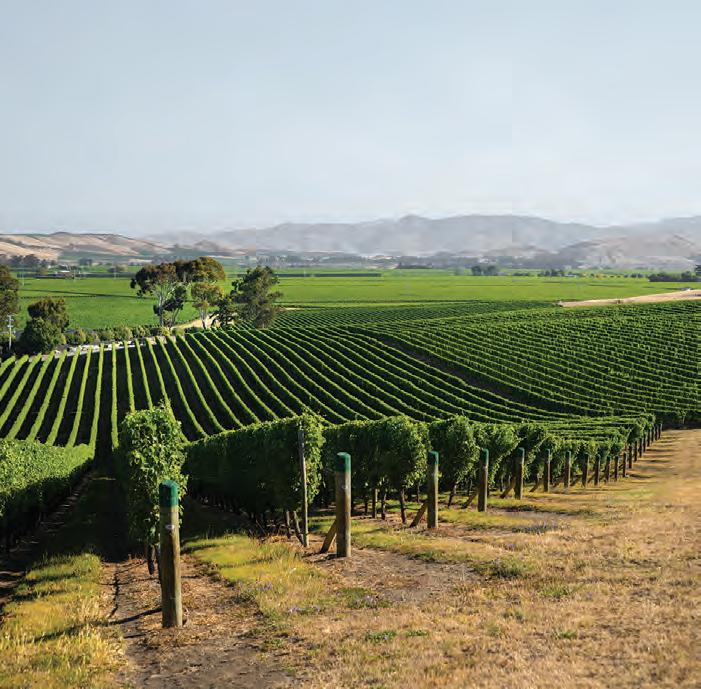
lower Wairau which is inherently higher yielding than anywhere else and that’s quite clearly associated with its much siltier soils.”
Co-author Dr Mike Trought has had a
“The overwhelming majority of people who we asked for data were willing to contribute it and I think the study shows the power of doing that”.
Dr Rob Bramley
long interest in Marlborough terroir and says the study also highlighted pockets of the Wairau plains that consistently appear to be lower yielding. The study is a first step, highlighting research opportunities to “further understand the ’why?’ behind regional variability”, Mike says. “There are a lot of hypotheses as to why we see these variations... If you look at the soil types,
one area is distinctly different to other areas on the Wairau Plain. If it is simply high water holding capacity, then why doesn’t irrigation have the same effect? If it is a nutritional effect, how will fertiliser alter that?”
The study points to future implications for many aspects of the Marlborough industry, from vineyard management and winery logistics to future planning around regional expansion and contraction. The study can start conversations about subregionality in Marlborough and “to what extent our knowledge of subregional differences can be used in the marketing perspective”, Mike says. “While some wines comparing various vineyards at the same harvest soluble solids were made during the Sauvignon Blanc research programme, the number of sites were limited,” he adds. Rob would like the research to delve into the resulting wines. “If we could analyse some fruit chemistry or get some sensory analysis done based on the clustering that we’ve identified, it would be very interesting to see to what extent those differences are expressed in the wines.”
To read more go to hindawi.com/journals/ ajgwr/2023/8811402/
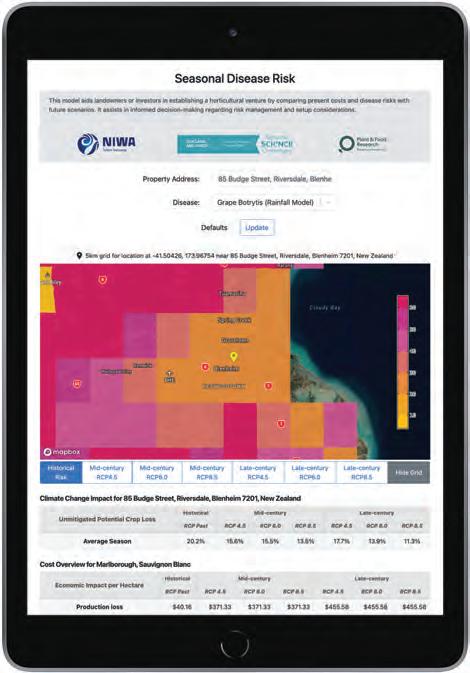
A free interactive tool has been launched to provide grape and apple growers with information on how climate change may affect the risks and costs of living with common plant diseases in different parts of New Zealand. Created as part of the Our Land and Water National Science Challenge, the ‘Changing Climate: Disease Risk & Costs’ tool allows people to enter their vineyard’s address to view the risk of powdery mildew and botrytis on their crops under different climate change scenarios.
It also translates that risk into financial terms, helping people understand how climate change may affect the cost of managing plant diseases on their land in the decades ahead. “In simple terms it’s a portal into the future,” says Mike Barley, Director of New Zealand agri-tech company HortPlus. “It helps with climate adaptation planning and provides easy to digest information for people in the apple and winegrowing industry who want to understand how plant disease risks are likely to change, and importantly, what the cost implications of those changes might be.”
HortPlus developed the tool in collaboration with Plant & Food Research (disease models, Te Ao Māori), NIWA (climate models), The Agribusiness and Economics Research Unit (economic modelling), and Applied Research & Technologies (disease model reviews). Agribusiness and Economics Research Unit researcher John Saunders said the tool’s combination of GIS risk mapping and climate, disease and economic modelling made it unique. “The aim is to let people get a bit of an idea about what the future holds before it arrives. If you are buying a house, you would check flood maps. Why shouldn’t we have rich information about the likely impact of plant diseases for horticulturalists?”











Sauvignon, Chardonnay, Albariño… well, while we do love a good drop, what we really mean is that we have decades of wine industry experience and know the industry and processes inside out.
This understanding enables us to offer insights and create seamless solutions that make a real difference for even the most complex projects.
Learn more about our winery engineering services and experience.
Marlborough Canterbury Hawke’s Bay Otagokotahistudio.co.nz/winery
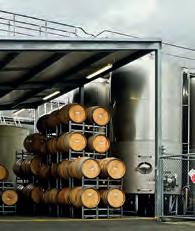
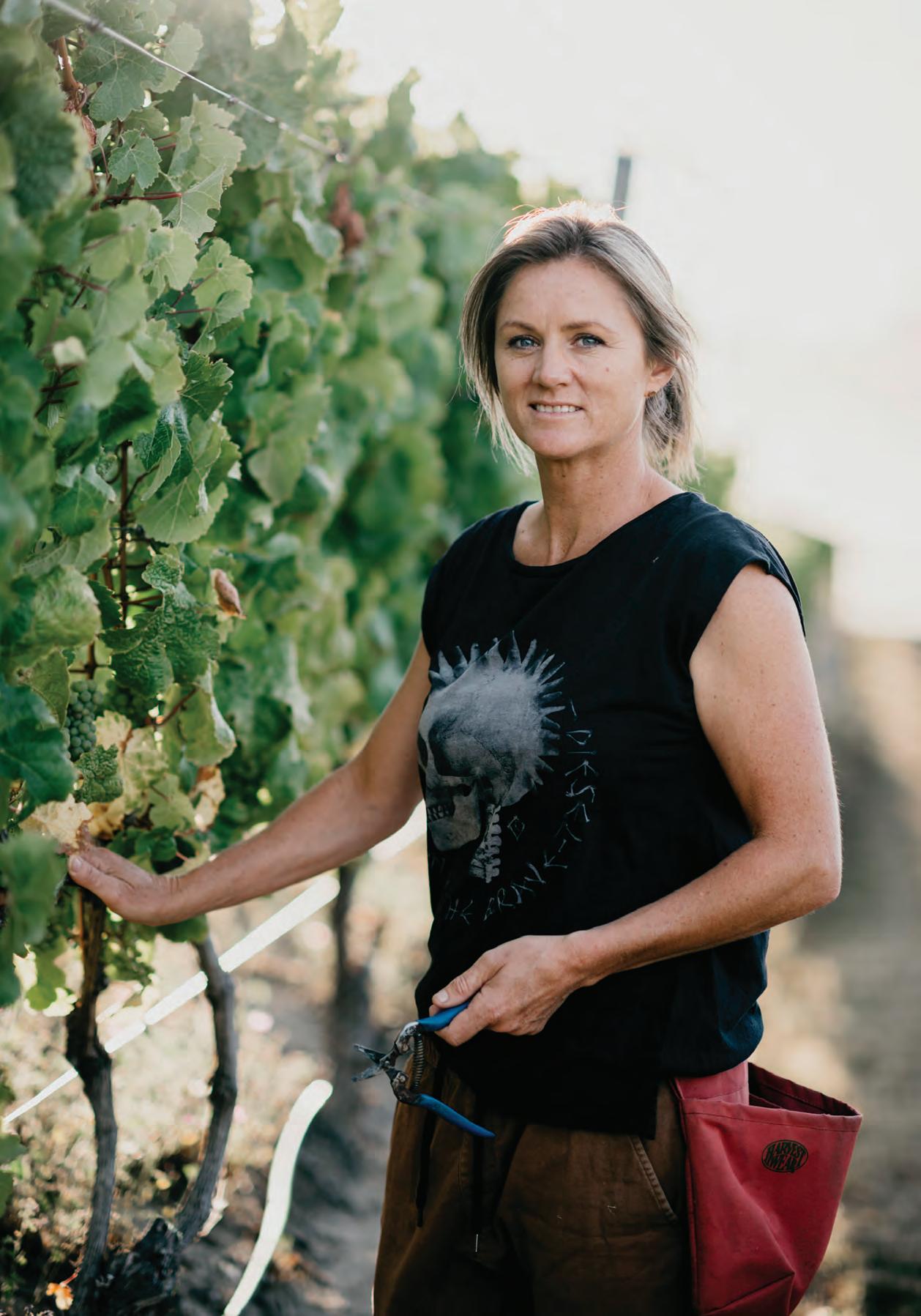
37 I Women in Wine
Sarah-Kate Dineen
39 I Lauren Yap
Brood Fermentation
40 I The Profile
Chris Scott
42 I Point of View
Jo Cribb
You’d be hard-pressed to find a more gleerich photo than that of Sarah-Kate Dineen holding the Heritage Rosebowl trophy at the 2023 National Wine Awards Aotearoa New Zealand. Her grin was intensified by the fact that it was the second year running that she and husband Dan Dineen took this coveted hunk of silverware home. They also bagged Winemaker of the Show and won a trophy for their 2023 East Block Riesling.
There’s a bittersweet note buried behind that photo’s megawatt smile, though; the man who kicked this Maude adventure off 30 years ago – Sarah-Kate’s dad Terry Wilson – died seven months before the gratifying back-to-back Rosebowl triumph.
Terry and Dawn Wilson (or, as SarahKate calls them, “beautiful Mum and Dad”) took a leap of faith in 1994 and upped sticks to Wānaka to plant grapes. Terry had been a country GP in Winton, and Dawn a potter. “At the age of 50, Dad decided, ‘right, let’s have a look at this wine game’. It wasn’t foreign to him because his family had a vineyard in the Esk Valley. But it was pretty foreign down here at that time –there were only about 10 vineyards and five wineries in the region.”
Sarah-Kate says her father was one of many doctors who’ve fallen vine-wards. “It suits their analytical brain to figure out what’s happening and come up with a solution.” Also, vines don’t moan out loud about their ailments. “They don’t confuse you with emotions. It’s more straightforward – they show their symptoms and you treat them.” The
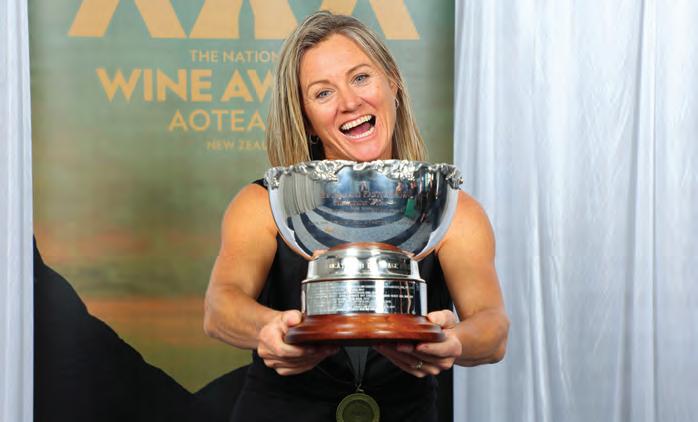
Wilsons leaned on local nous to help steer their Wānaka grape course. “They asked Robin Dicey (a consultant viticulturist for the area at that time) to find a site for them. Then Rolfe Mills (founder of Rippon vineyard) came over and made sure it was OK.” They then did everything bar the winemaking at Maude Wines, established on four hectares of steep, north-facing land in Maungawera Valley, with plantings that included cuttings from original Riesling vines grown at Rippon.
When it came to choosing her own career, Sarah-Kate almost chose the doctor route: “I thought I’d follow in my father’s footsteps and do medicine – but didn’t quite have the brains or diligence for it!” She opted instead for a post-graduate degree in wine science and viticulture at Lincoln University, before heading across the ditch to spend a heady decade in Australia’s Hunter Valley. “It was a brilliant place to learn your winemaking craft,” says SarahKate, who gained more than a robust wine education there; she gained a Dan Dineen too – a man with quite the shiny wine report card: “He’d been to Roseworthy College in Adelaide and had a CV of
amazing Australian wineries under his belt.” The pair worked together at Brokenwood Wines – a place famous for its culture of nurturing young winemakers and sharing wines over a harvest lunch. “It was a great learning ground.”
When they came back to New Zealand to get married at Rippon in 2003, SarahKate and Dan clocked the region’s new viticultural vigour. Wine industry friends who came across from Australia for the couple’s nuptials were wowed by what they saw and predicted an imminent Dineen loss for the Hunter Valley. “At that stage Central Otago was really on the map – it was exciting. The quality of what was coming off these young vines was massive and the calibre of young winemakers was exceptional.”
Those wine-savvy Australian friends weren’t wrong: the Dineens moved to Wānaka in 2005 and became the second generation of Maude-ers. Had Terry and Dawn lobbied for this excellently seamless
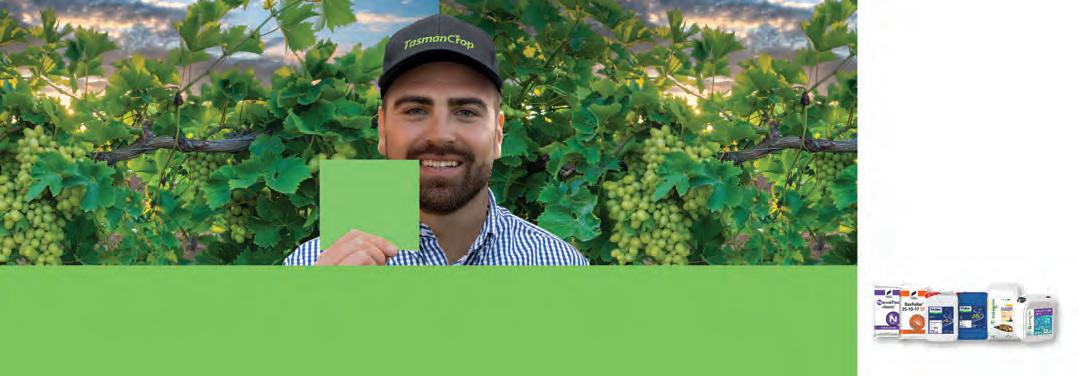
succession plan? “I think they always hoped for it but never presumed,” SarahKate says. “When we told them we were coming home they were delighted – and probably quite scared as well.” Since then, she and Dan have built a winery, developed the Maude Wines brand, started a family (two daughters, Stella and Mae) and expanded their vineyards beyond the Riesling, Pinot Noir and Chardonnay they produce from Mt Maude. They lease Mohawk Hill in Cromwell for Pinot Noir, Chardonnay and Pinot Gris, and have 6ha of Pinot Noir at Two Degrees Vineyard in Queensberry.
The Dineen marital winemaking duties tend to fall along grape variety lines: “Dan will put the final touches on the Pinots and I’ll have the last say on aromatics and white wines.” On the Maude website, Sarah-Kate is described as “a self-confessed dreamer and schemer” and “Energizer Bunny”, while Dan is “the Devil’s advocate”, Sarah-Kate explains: “I tend to be wild with my ideas and he brings me back into line.”
Vineyard Manager Brendon Wilson is another Energizer Bunny moderator in the Maude mix. His website profile reads:
“As the older brother of Sarah-Kate he is probably the only other person in the winery and family apart from Danno who can come close to getting the upper hand in a ‘discussion’ with Sarah-Kate. He used to do it by dangling her over the toilet but now uses more mature methods like silence.” Which is to say, the culture at Maude is anything but stuffy. “Dan prefers a flat management style”, Sarah-Kate says. “There’s not really a hierarchy at Maude. And meetings are like margarine – a waste of time.” While the winery and vineyard are extremely labour-intensive, fun is always paramount. “We bring winemakers in from around the world to help out every harvest. We have a chef and we put on lunches and a bracket of wines to inspire discussion.” It’s that same nurturing they experienced at Brokenwood – they’re paying it forward.
This year marks a big milestone for Mt Maude. “The vines have been in the ground for 30 years now – and unirrigated for about 15, which is very rare for Central Otago. The vineyard is getting better and better all the time. The fact that Mum and Dad had the foresight to plant a vineyard and the dedication to find the right sitewe’re just reaping the benefits of that now.”
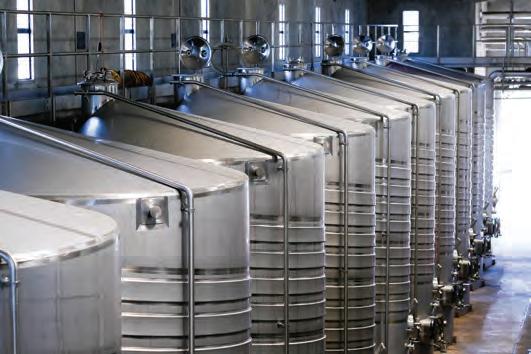
Maude’s team now spans three Wilson generations. Dawn is still there with her grape radar poised: “We have to hold her back from doing too much – she’s a gogetter. She’s always out there assessing what we’re doing in the vineyard. She’ll come in when I’m knees-deep in the winery and tell me that the East Block Reisling is ready to pick and I’ll say, ‘oh that’s rubbish, Mum. We’re still two weeks away’. She’ll say, ‘nope, it’s ready now’ – and she’ll be right.” The third generation is ready to add further familial buttressing, with SarahKate’s nephew Sam Wilson returning to the role of Assistant Winemaker at Maude after a brief dalliance with brewing. “He’s 28 so it’s the right time to come back and settle in. It’s a great succession plan.”
But what of the pair’s 16-year-old science-keen eldest daughter Stella? Might she tag in on the winemaking one day too? At the moment, says Sarah-Kate, it’s a hard ‘no’. “She’s told me there’s no way on earth she’ll ever be involved in the wine industry. She’s said, ‘Mum, I’m really sorry but I want to live in a city and I’d quite like to dress nicely.’”
Clearly, Mum’s shorts and gumboots just
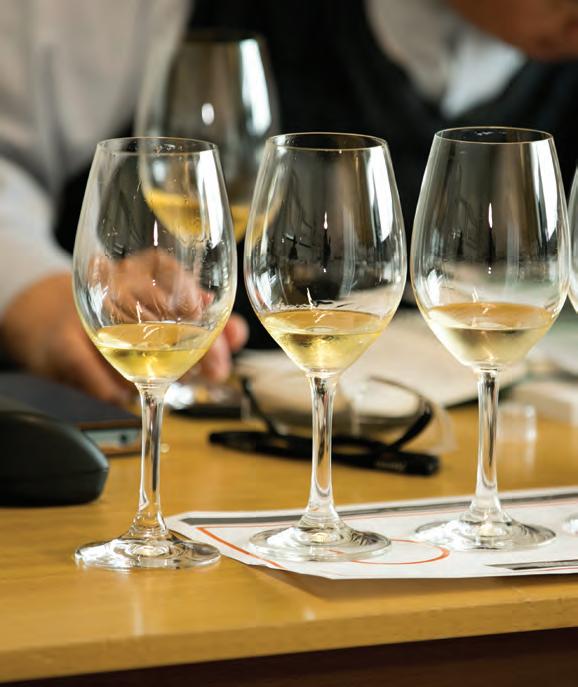

Brood Fermentation is doing things differently. Not only are Jim Brown and Lauren Yap winemakers, they’re beer brewers too. They strive to make low-intervention wines that are a pure expression of what Nelson has to offer – the climate, heavy clay soils, surplus of sunshine and cool nights. “We’re not here to make bold proclamations about winemaking approaches, but we both think very critically about how to create the best product,” Lauren says.
“We thought it was poetic that the brood is a place of nurturing and a designated safe space for growth, which we are still very much doing.”Lauren Yap
Jim fell in love with low intervention wine back in 2016 while studying viticulture and winemaking at NMIT in Blenheim. Following that, he travelled overseas and worked with organic farmers and producers of organic and wild fermented wines in South Australia, Italy, and Willamette Valley, Oregon.
Lauren first found her place in craft beer by way of the hop industry, under hop breeding programs and alongside hop growers. She worked for several breweries in Portland, Oregon, and also worked several vintages, before starting Brood Fermentation.
Why Nelson? “We picked it off a map!”
In late 2019 Jim and Lauren were living in Portland where Lauren was brewing for Migration Brewing and Jim was winemaking for Brooks Winery, when they casually contemplated either staying in the US, or heading to New Zealand to start their own project. “We’d collectively spent little time in Nelson but we knew the Nelson Tasman boasts good soil, lots of sunshine, and grew grapes and hops alongside other fruits and nuts which we imagined incorporating into seasonal

beers,” Lauren says. “The rest is history. We made the jump in January 2020 and are so happy we did.”
The name Brood Fermentation is a nod to Lauren’s interest in beekeeping. In apiculture the ‘brood’ is the area of the beehive where the eggs, larvae, and queen are. “We thought it was poetic that the brood is a place of nurturing and a designated safe space for growth, which we are still very much doing,” says Lauren. “‘Fermentation’ covers both beer and wine and whatever else we might choose to ferment in the future, so we felt it most appropriate for our project.”
When asked why they decided to pursue both brewing and winemaking as opposed to one or the other, the pair point to their experience and passion in both crafts. “We feel we have something to bring to the table with both products. Brewers and winemakers operate on the same plane but have different approaches to fermentation. Producing both beer and wine allows us to become better and think more critically about our process and our products.” Jim focuses his attention on farming their vineyard while Lauren focuses hers on the brewery, and they make the wine together, but “everything we do is a team effort”.
The beer and winemaking industries complement each other “so well”, they say.
“It keeps things exciting for us, plus we have more product releases throughout the year as beer is often (though not always) a quicker product. Getting to offer a full array of beverages is pretty fun too. Lagers, stouts, sours, whites, rosés, and reds are all in our portfolio.”
The entrepreneurial couple love the diversity that comes with winemaking and viticulture. “Being small keeps us involved in every process. From pruning all through winter, spring shoot thinning, wire lifting and spraying, to fermenting, pressing and bottling. The whole year our work is changing and engaging,” Lauren says.
They attribute some of their success to their network. “The support and transparency from the industry is great. We have really good relationships with people we work with, from packaging supplies to agriculture services. Other winemakers in Nelson have really helped us in our start-up phase – we’re so grateful to the growers and producers who lend a helping hand or words of advice. It’s a special part of this industry that we hope to pay forward someday.”
Lauren was named by Cuisine Magazine as one of Aotearoa New Zealand’s TOP 50 most influential & inspiring women in food & drink 2024. This story first ran in the Our People section of nzwine.com.
Chris Scott was driven by boredom when he picked up his dad’s copy of the Cuisine New Zealand Wine Annual in the 1990s. “I got the bug almost instantly,” says Church Road’s head winemaker 30 years later. “It seemed an awful lot more interesting than accounting.”
Growing up in Hamilton, Chris planned to be a farmer, far from the madding crowds, but ended up in a business management degree, “mostly due to a lack of any better ideas”. The Wine Annual offered a much better idea indeed, and he immersed himself in wine books and tastings, including an organised wine tour of Hawke’s Bay with Vince Picone, a wine tour legend who recently passed away.
Vince took him to Ngatarawa, where the group sat at a long table and tasted a tank fermented Sauvignon Blanc and Alwyn Chardonnay side by side. “They explained the different flavours that come from different grape varieties and the impact of winemaking techniques such as choice of fermentation vessel, lees aging and malolactic fermentation.” To see such contrasting styles side by side was a “revelation”, he says. “I was so excited that I could see such a clear distinction and I loved the Chardonnay - still the world’s greatest white grape variety in my opinion. I remember sitting there thinking ‘I want to learn how to make this’.” He went home with a case “which was a serious financial commitment on my meagre student income”.
Vince also took Chris to Church Road for a ‘behind the scenes’ tour of the winery. “It was his infectious enthusiasm on that tour that ultimately led me to abandon business studies for wine science,” Chris says. “Some 30 years later he was still bringing guests to Church Road.”
Chris quit his degree and moved to Hawke’s Bay to study at Eastern Institute of Technology (EIT), picking up a casual summer job in Church Road’s vineyards in the summer of 1995. The first week of bud removal amid stinging nettle, in 32C heat, demolished any romantic ideas he’d nurtured about the industry. But he went on to work in the cellar door and, after a couple of years “hanging around”, was offered a cellar job for the 1998 vintage.
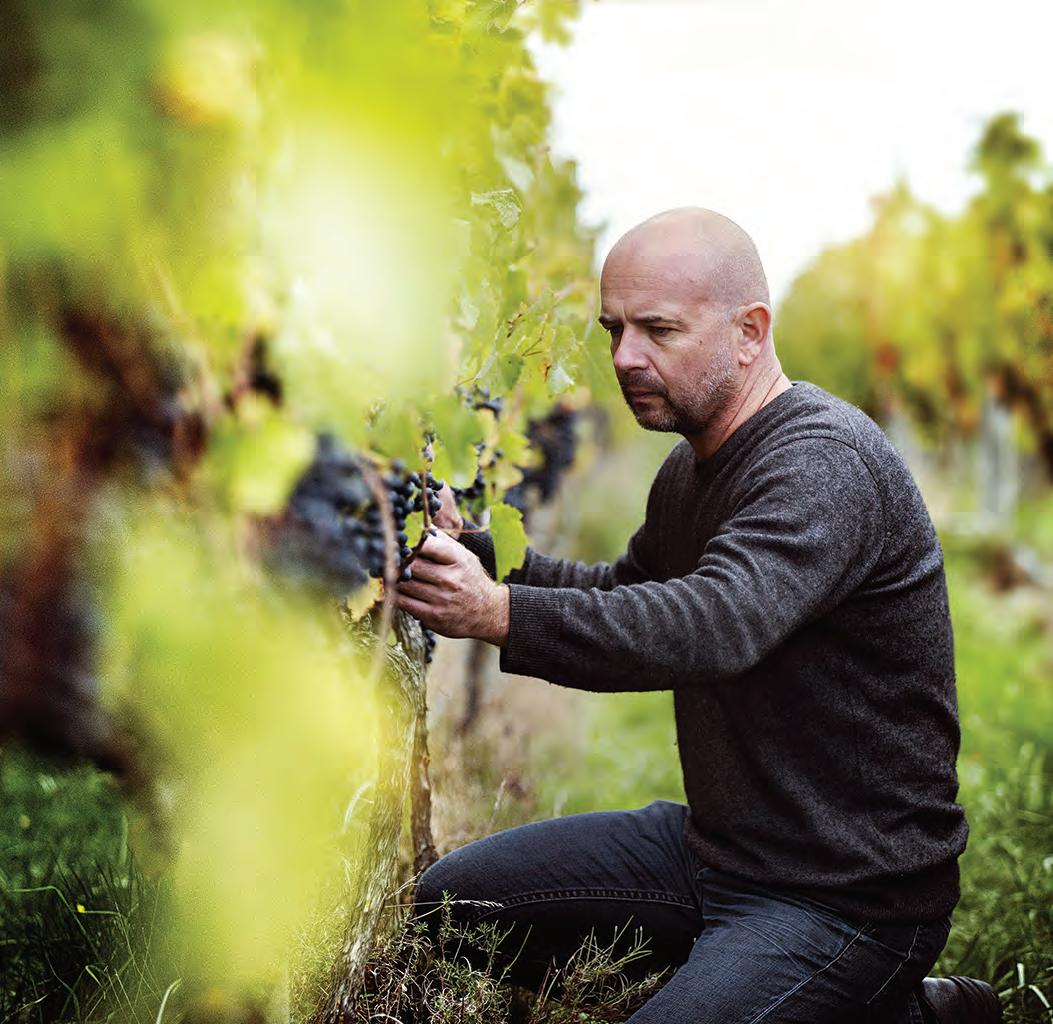
“Everyone I know that makes it, loves making it and I think it’s a firm favourite amongst winemakers.”Chris Scott
Apart from a two-year stint at Montana in Gisborne, he’s been there ever since, taking up the Church Road Assistant Winemaker job in 2002, then Head Winemaker in 2005. The past 25 years have given him a seasoned understanding of the company’s vineyards and harvest decisions, “and knowing where the little gems are within a block”, Chris says. “The knowledge that under certain seasonal conditions, at a certain ripeness level, you know what the personality of the wine will be.”
He’s seen plenty change since the days a “shotgun approach” was taken to plantings. These days subregional specialisation is key in Hawke’s Bay, with its myriad soil types and altitudes. Meanwhile, the changing climate requires a new view of what should be planted where. “We’re getting warmer and earlier and that is starting to be reflected in what grows well,” Chris says. “For example, making good, highly Cabernet dominant
wines used to be about a once every threeyear proposition. These days, we make great Cabernet in all but the very worst seasons.”
When it comes to subregional favourites, the Bridge Pa Triangle lives “unfairly” in the shadow of Gimblett Gravels, but is a district producing some “truly exceptional” red wines. “With a bit more topsoil it can be a little less forgiving in a wetter year, but in most seasons, it makes our top wines at least as often as the Gimblett Gravels blocks. The wines aren’t as strongly structured as the Gravels wines, but they’re incredibly aromatic and they have a plush, fleshy silkiness that makes them very easy to love.” That’s a great example of terroir, he adds. “Arguably the two best red wine districts in Hawke’s Bay, side by side. It’s a three-minute drive, yet the wines from each area have distinctively different personalities.”
In October, Church Road was shortlisted for Best Red Wine Producer at the IWSC awards for the second year running, which is a boon for the reputation of fuller bodied red styles from New Zealand, including Syrah and Cabernet Merlot, Chris says. Syrah makes up about 2% of Hawke’s Bay’s grape plantings but has achieved more international acclaim for the region than any other variety, he says. “Our 2020 Church Road 1 Single Vineyard Redstone Syrah was one of the Drink Business Masters series
top 10 wines of 2022, selected across all varieties. The same wine was 97 points in Decanter.” That’s one example of a “string of incredible accolades” for producers across the region going back for many years, Chris says. “Time and time again these wines are excelling in international comparisons. The potential for the region is huge.”
People love Pinot Noir for its elegance and fragrance and its gentle tannin structure, Chris says. “They can be complex and interesting but they usually still have this beguiling approachability. A Cabernet blend by contrast can be much fuller bodied, but usually positively demands time in the cellar to tame those austere young tannins.”
Good cool climate Syrah has the best of both worlds, he adds. “Supple tannins and beautiful fragrance, but more flesh and density than Pinot Noir and a darker, more brooding intensity. With Syrah I often talk about walking the line. Harvest too late and you’ll get good weight and flesh and supple, ripe tannin, but you lose the floral and spice fragrance that’s such a hallmark of the Hawke’s Bay style. It becomes quite generic. Harvest too early and the wines are thin and mean with weedy leafy notes, which
for me is the less attractive side of Syrah aromatics, though not everyone agrees.”
Chris mostly loves making Syrah because he loves drinking it, including the Church Road entry level Syrah, which is “deliciously approachable, elegant but not insubstantial, and still quite a complex and interesting”. At the other end of the scale, he makes the $220 Tom Syrah, which allows for more bespoke experimentation. “What we learn there certainly flows down to the commercial end and ultimately, as we’ve learnt more about Syrah, the entire range has benefited.” The wines higher in the range have more density and savoury complexity. “I think that’s one of the great things about good cool climate red in general, it can be dense and full but still incredibly complex, with savouriness both aromatically and texturally. Compared to so many warmer climate two-dimensional
Wine DRC – May be my only chance!
Meal Duck confit or proper yakitori
sweet fruit bombs, well, I know what I’d rather drink any day.”
Syrah is an important variety for the company, “though I hear mixed reports from others,” Chris says. “There’s probably a job to do in the market raising the profile of Syrah amongst consumers. I’m not sure people in New Zealand are aware of how phenomenally these wines have been reviewed and accoladed internationally. Everyone I know that makes it, loves making it and I think it’s a firm favourite amongst winemakers.”
Chris has won Winestate New Zealand Winemaker of the Year five times between 2013 and 2022, but says that while it’s often the winemaker who ends up in the limelight, it takes a bunch of “wonderfully talented people” to make these wines. “I’m very proud of what we have collectively achieved.”
Album My wife’s eclectic Spotify. She has very good taste
Book The Bookseller at the End of the World, by Ruth Shaw
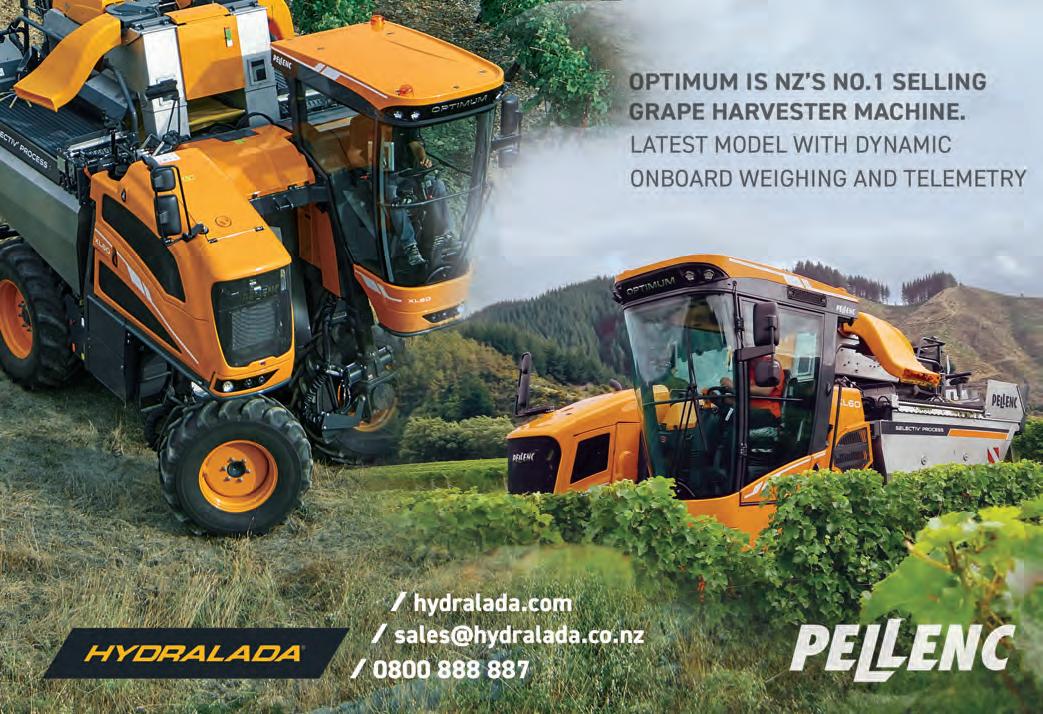
“I’m a woman and I’m in wine. Why do we need Women in Wine?” I was asked this great question recently.
Her colleague joined in: “Yeah, there are loads of ponytails driving tractors on vineyards now. Why do women need a separate group?” His question might be one you have asked yourself. We have much to celebrate in that women are succeeding and making an increasingly important contribution to our industry. Our industry needs the best, most skilled and motivated people and gender shouldn’t get in the way.
This data didn’t paint a picture of a modern, attractive workplace, nor of an industry getting the best out of all its people.Jo Cribb
But research shows that it does. Seven hundred industry people responded to the New Zealand Winegrowers ‘Our People Survey’ in 2019. It reported that 55% of women reported being shut out of opportunities by ‘old boys’ networks’ as a barrier to their career progression (compared with 27% of men). Childcare and maternity provisions were another barrier for 31% of women (only 11% of men).
Perhaps this starts to explain why women held only 38% of senior roles (board members, chief executives, senior management, and chief roles) despite having the same levels of career ambition as their male colleagues. Worryingly, 40% of women respondents said they had experienced gender-based discrimination (5% of men) and 30% of women had experienced sexual harassment at work (4% of men).
While survey participants acknowledged that discrimination based on gender has reduced over time, it’s still an on-going
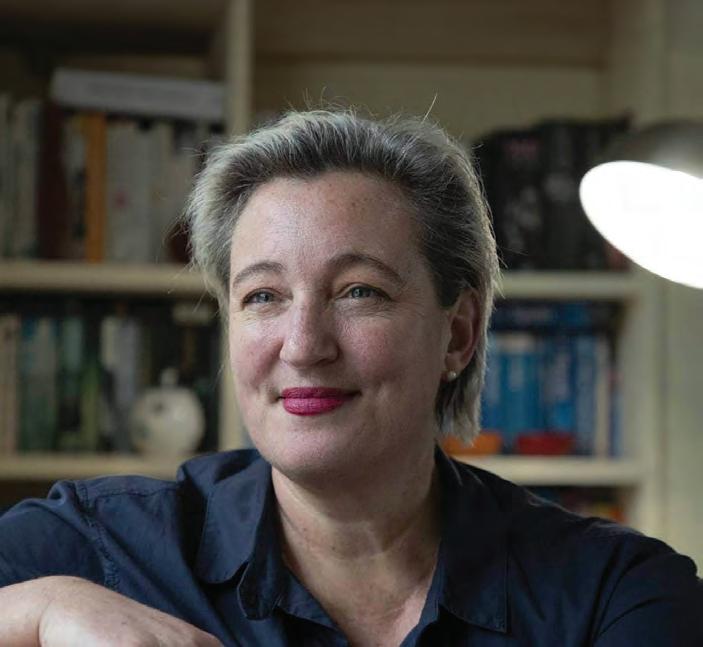
problem. This data didn’t paint a picture of a modern, attractive workplace, nor of an industry getting the best out of all its people. That’s why there is New Zealand Women in Wine: to support women to progress their careers, and their employers to attract and retain the best and the brightest without barriers based on gender.
The National Steering Group for Women and Wine met recently to plan for the upcoming year. I am lucky enough to chair this group. We confirmed the three goals of the programme: Connect, Inform and Change. Women are often in workplaces with only a handful of other women. The Connect goal aims to create a community of women in wine, and their supportive colleagues, at the regional and national level and online. The Inform goal is about sharing relevant information and evidence, with a focus on supporting women to develop their careers. Actions under the Change goal aim to support organisations to ensure women thrive at their workplace.
• linkedin.com/groups/14340481/
• @womeninwinenz
• facebook.com/WomeninWineNZ/
These are our priorities for 2024/25:
Connect
Regional committees will continue to provide opportunities for networking. Nationally, there will be space for women in wine conversations at future industry celebrations and events. We will also aim to build our presence on social media.
Inform
The well-regarded mentoring programme contributes to all three goals and will continue to support the development of a cohort of women in wine each year. Along with that, we will provide a women’s development series of online, bite-sized sessions on relevant topics identified by the steering group.
Change
New Zealand Women in Wine aims to undertake a similar survey to the 2019 ‘Our People’ report to track industry progress towards being a modern, inclusive employer. We will also share updated industry gender pay gap data.
All New Zealand Women in Wine actions are focused on ensuring the New Zealand wine industry attracts, develops, and retains the best and the brightest talent, with gender being no barrier. I’m sure we’d all drink to that.
Belanty fungicide gives New Zealand growers complete confidence in the control of powdery mildew in grapes. Setting a new global standard for DMI’s, Belanty is able to control pathogen strains that old DMI’s are struggling to control. Belanty is the breakthrough you’ve been waiting for.
Talk to your local reseller or visit our website
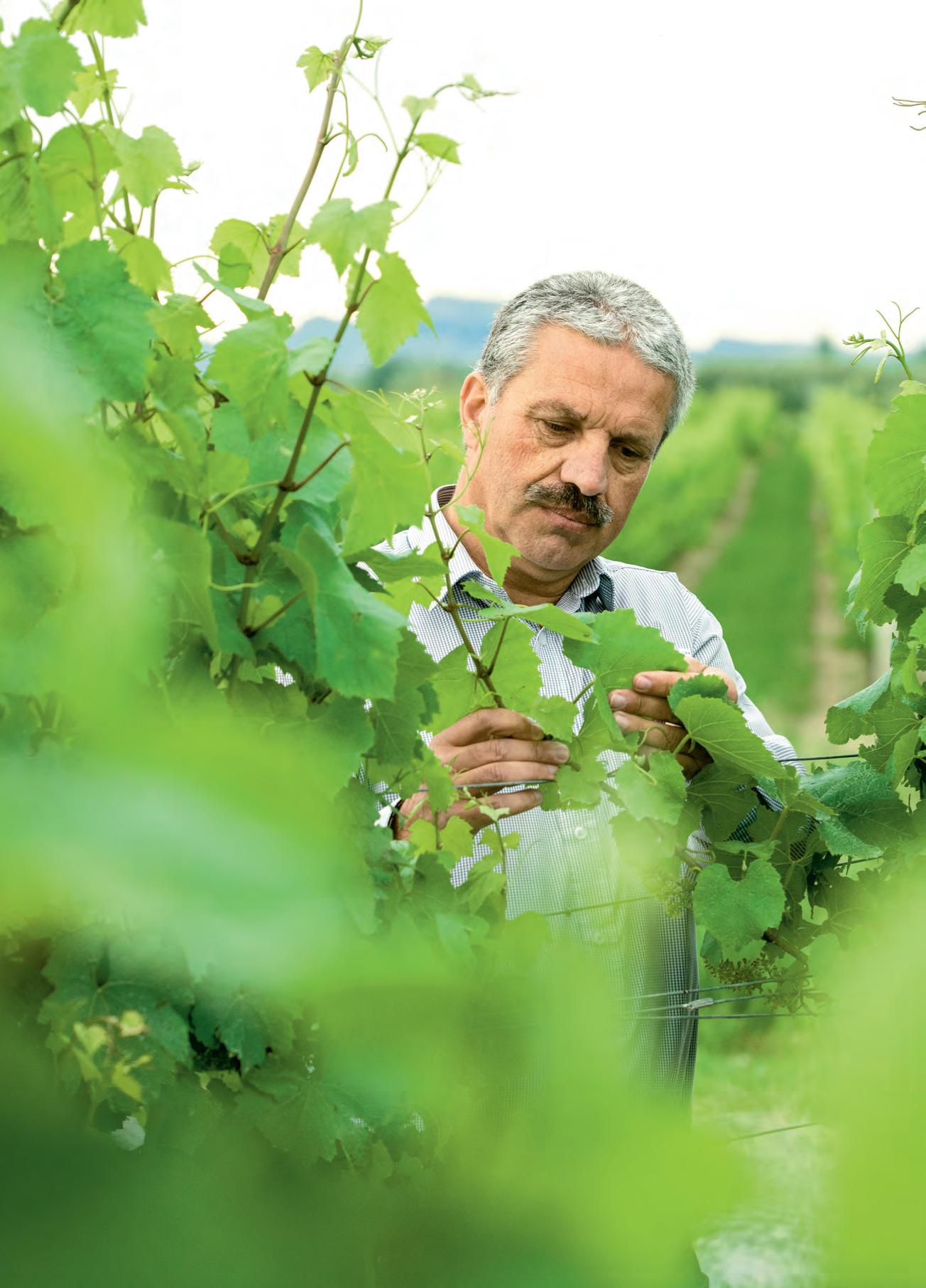
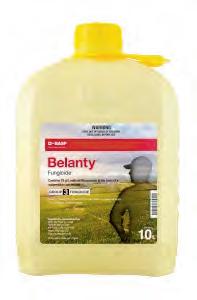
Recently I have been studying inversion patterns during cold nights across parts of inland Australia. The size of some of the inversions across an orchard or vineyard at just 15 metres was at times jaw dropping when compared to some of the more conservative inversions that are found in parts of New Zealand. It was not uncommon to see inversions of over 8C during cool, calm conditions, whereas in Marlborough, Hawke’s Bay and other regions, a good inversion may be anything over 2C. Parts of South Canterbury can see regular inversions of over 4C at times. The inversion is one of the critical parts of frost fighting during the growing season and a good inversion is a great asset when using frost fans or helicopters to mitigate the risk of frost.
The mountains, hills and valleys of our islands create a complex environment for inversion development in New Zealand. Katabatic drifts form higher in valleys and hillsides as the air cools after sunset. This
cold air, then being denser, sinks and drains down the hillsides into wider valleys and basins and eventually to the coast. Some of these drifts can be quite significant and reach speeds of over 20km/h. One such example is the drift that flows down the Wairau Valley in Marlborough. The movement of a large amount of air creates turbulence and as a result that air mixes with the surface and inversions become weaker. In areas such as the Canterbury Plain, inversions are stronger as the cool air from drifts emanating from the Southern Alps spreads out across the plains. The wind flow is lighter and there is less mixing and little turbulence above the surface. A detailed and accurate understanding of how the aforementioned factors affect inversion development over a vineyard can be achieved by frost mapping and analysis of daily weather. The investment put into studying land to understand inversion development and the overall risk of frost results in more efficient and effective
use of frost protection during those long, cold, sleepless nights in spring.
No sooner did El Niño arrive in 2023 and we are already talking about its departure in early 2024. The transition from La Niña to El Niño during the final months of 2023 was quite slow and although the Southern Oscillation (SOI) and other indicators of the La Niña/El Niño cycle were telling us we were in El Niño, it did feel like the humidity and warm northerly flow of the La Niña pattern didn’t want to leave in a hurry. Autumn 2024 is likely to see a move back to a more neutral position of the SOI and there are growing murmurings of the return of La Niña by Spring.
Outlook for April and May: Gisborne/Hawke’s Bay
An increased westerly flow is likely to see drier conditions increase as we move

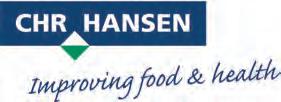

Tonnellerie Mercier combine technological innovation with the tradition of selecting the best oak with traceability to forest source alongside the very highest specifications for barrel fabrication. Working specifically with the forests Berce (minerality), Troncais (structure) and Hagueneau (volume, roundness). Quality, consistency and specificity are signatures of the Tonnellerie Mercier barrels.
Chr. Hansen has been both a pioneer and a leading industry player helping viticulturists and winemakers to better understand wine microorganisms and their interactions. We take our evolving knowledge and apply it to the management of alcoholic and malolactic fermentations in order to fully release Nature’s potential
VASONGROUP
More than just a
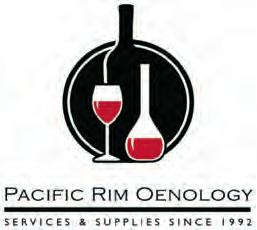

through April and into May. The westerly flow may start to ease by late April. Mean temperatures are likely to remain above average, although the drier westerly flow means that cooler nights are likely through April and some areas may even see nighttime minimums running a little below average. This can also encourage development of fog or mist. Rainfall totals are likely to be near or a little below average. It has been a quiet tropical cyclone season so far, but there is always some risk to the upper North Island between February and May. Mean wind speeds are likely to decrease later through April and into May as the frequency of westerlies also decreases.
Wairarapa
Mean temperatures are likely to run close to average through early April with northwest winds present and likely to be stronger than average. These winds should become less frequent later in April and into May. Rainfall totals should run a little below average but there will be some rain produced by the stronger northwest events or colder southerly changes as we move closer to winter.
Nelson
Temperatures are likely to remain near or above average across the region. Inland areas may see cooler nights through April and early May as the stronger northwest flow eases. There is a chance of some moderate rain under the northwest flow but this may ease later in April. As conditions become more settled into May, cooler than average nights are possible inland.
Marlborough/North Canterbury
Northwest winds are likely to start easing through April, but conditions are likely to remain milder and with below average rainfall. The diurnal range may increase later in April with cooler than average nights about inland parts of Marlborough and North Canterbury. This is due to the northwesterlies becoming less frequent and an increase in high pressure over the upper South Island.
Central Otago
Mean temperatures should remain a little above average for April and into early May. The stronger northwest flow will continue to bring some rain and encourage milder temperatures but this eases as the northwesterlies retreat. Dry periods may increase from mid-April as high pressure replaces the northwest flow through into late autumn. The diurnal range between minimum and maximum temperature is likely to increase through April and into early May.
James Morrison runs Weatherstation Frost Forecasting: weatherstation.net.nz
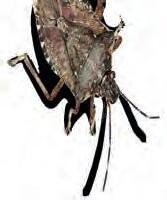
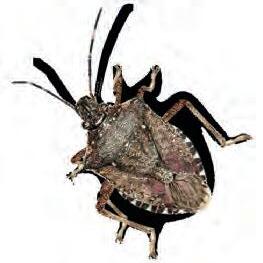
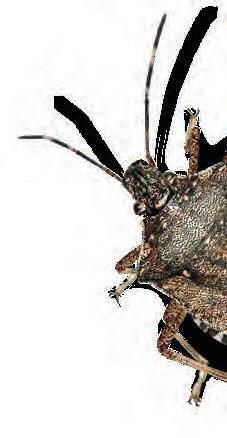


The brown marmorated stink bug is a pest that infests homes, ruins gardens, stinks when crushed, and is almost impossible to get rid of. It could also destroy our fruit and vegetable industries. It’s not in New Zealand yet, and we want to keep it that way. So if you see one, don’t kill it. Catch it, take a photo, and call us on 0800 80 99 66. For
information (including how to identify the bug) visit biosecurity.govt.nz/stinkbug


Following the New Zealand government’s introduction of Freshwater Farm Planning regulations last August, local authorities are now activating them on a region-byregion basis out to the end of 2025. These regulations require all farm operators for vineyards over 5 hectares to develop a Freshwater Farm Plan (FWFP) to mitigate the impacts of their activity on freshwater ecosystems. From the date the regulations are activated in your region, farm operators will have 18 months to complete a FWFP.
Supercharging SWNZ: Changes required to meet Freshwater Farm Planning regulations
Following the completion of an 18-month project funded by the Ministry for Primary Industries (MPI), New Zealand Winegrowers (NZW) received a final Technical Assessment and Gap Analysis of the Sustainable Winegrowing New Zealand (SWNZ) programme from the Agribusiness Group in early March 2024. This report examined the potential alignment between SWNZ and the FWFP requirements. This report identifies that the key gaps in the SWNZ programme that will be required in a FWFP include:
• The provision of vineyard property-level GIS maps which identify the location of land units, land uses, soils, slopes, infrastructure, etc.
• The identification of inherent risks relating to freshwater from the property (i.e. soil type and slope) and risks posed by vineyard management activities (i.e. redevelopment or cultivation). Identifying these risks is an important part of developing a FWFP as it provides the basis for action to mitigate the risks posed by viticulture. Identification of these types of risks is not currently mandated within the SWNZ programme.
• Catchment context – links with catchment context, challenges and values (CCCV). Currently, SWNZ sets a national standard for sustainability certification. This may need to change to incorporate specific requirements in different catchments.
Overall, the report concludes that the SWNZ programme could be modified to assist members to develop FWFPs, but

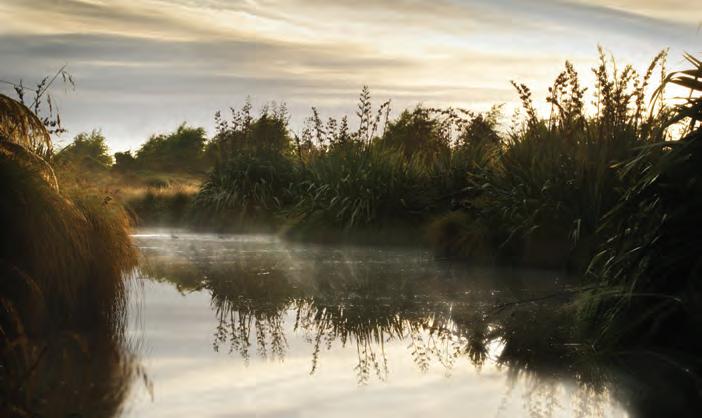
that significant technological innovation is required for these adjustments to meet regulatory requirements.
Project Raumatatiki: Freshwater Farm Planning for Viticulture
To address the gaps found in the Agribusiness Report, NZW has received financial support from the Essential Freshwater Fund, which is administered by the Ministry for the Environment (MfE). This funding has enabled NZW to launch ‘Project Raumatatiki: Freshwater Farm Planning for Viticulture’. Project Raumatatiki is an opportunity to enhance our industry’s commitment to sustainability by integrating FWFP requirements into the SWNZ programme. Consistent with our industry’s sustainability goal for water, the project will help us demonstrate that we are a world leader in efficient water use and the protection of water quality.
The funding from MfE will help us to develop an industry specific tool that members can use to create a FWFP for their property which is individualised, specific to their catchment, and identifies risks and vulnerabilities from vineyard activities and mitigations to address them. This tool will be essential for addressing the gaps identified in the Supercharging SWNZ final report.
In addition, the funding will help us deliver an education programme that provides advice to members on how to meet
FWFP requirements and how the tool that is being developed can assist them. Funding from MfE will finish in June 2025, which is before FWFP regulations will be activated in all regions. This means that Project Raumatatiki will act as a pilot to determine how best to assist members with meeting these regulations through the SWNZ programme. Any major changes to the SWNZ programme will be delayed until the regulations have been activated right across the country.
Fabian Yukich, Deputy Chair of New Zealand Winegrowers, is leading Project Raumatatiki, alongside representatives from three wine regions, central and local government. Collaboration will be crucial to the success of the project by considering feedback and perspectives from these stakeholders, as well as from a dedicated project technical advisory group and input from other primary sector organisations who are also impacted by these new FWFP regulations. If you are interested in finding out more about the project and those involved, go to nzwine.com/members/ sustainability/swnz/fwfp/
The project name Raumatatiki derives from the kupu ‘raumatatiki’ which refers to unfailing and endless freshwater springs. Here, it acknowledges the importance of our water that has and will continue to sustain Aotearoa and the wine industry’.
Dr Edwin Massey is NZW General Manager SustainabilityManufactured in Australia / Distributed by Eckford Engineering NZ
Material: G450 high tensile steel for strength
Coating: GALFAN Coating 5% Aluminium, Rare Metals, 95% Zinc, the ultimate in corrosive resistant coating for durability
Thickness: CV 1.6mm thick Galfan
BV 1.8mm thick Galfan
Length: 1.05m
• Ocloc V fits onto the round or flat , on a half round post
• No sharp edges, ideal for under vine management
• No need for new toxic replacement posts
• No new wooden posts, reduces your vineyards carbon footprint
• All Ocloc products are carbon offset
• Maintain your organic status
• You will not have to cut staples or remove plastic clips
• No more posts to the broken post graveyard
• Ocloc V application requires a side by side, 4-wheeler or equivalent, petrol rammer, impact driver or drill
• Find broken post repair with Ocloc V with one pass
• 4 x 75mm shark tooth screws supplied
• Ocloc V is an inexpensive install that alleviates the expense of tedious traditional treated wooden post replacement and the ecological footprint legacy they create
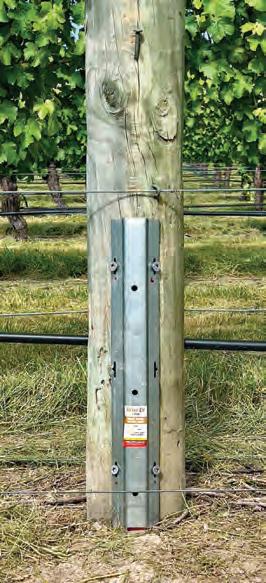


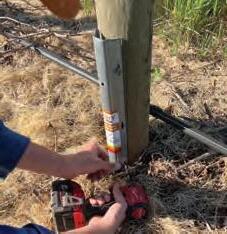
Ocloc

For further details please contact
Eckford Engineering
Phillip Gleeson: 027 275 9057 oclocnz@eckford.co.nz
Sam McConway: 027 422 4738 www.ocloc.com.au
DripperIn this biosecurity article, I touch on four subjects of recent interest: the new New Zealand Winegrowers (NZW) Biosecurity Contractor Resources, a Brown Marmorated Stink Bug update, a Xylella Action Group update, and the Forest Biosecurity Conference.
Over the past few years, we have been able to put together biosecurity resources for vineyard owners and managers. They have included a biosecurity plan template, pest and disease guide, and best practice flip chart. We have now produced a new resource for vineyard contractors. The resources are a Contractors Biosecurity Guide and a factsheet for vineyard operators and workers. We have hard copies available upon request, or you can download the documents from the member’s website. We will also make a copy of the Vineyard Pest and Disease guide available for contractors who request it.
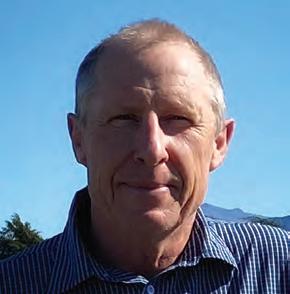
Last year, the brown marmorated stink bug update (BMSB) operational agreement was renegotiated, defining the terms by which we partner with other primary sector groups and the government to undertake BMSB readiness and response activities. The new operational agreement is now in place and active, ensuring ongoing risk mitigation against one of the New Zealand wine industry’s most unwanted pests and diseases.
The BMSB Council strategy was also reviewed, guiding the Council’s work programme over the next five years. This includes understanding how a BMSB response might transition towards effective management or containment should an eradication approach not be feasible and looking at collaboration with overseas partners to try and test some of the tools we think might be helpful in a response. Another priority in the new strategy is
understanding how we can work more closely with iwi to raise awareness of BMSB and develop support for some of the tools that may need to be used in a response situation.
The work programme around sourcing a supply of the samurai wasp, a biological control agent of the BMSB, is also being independently reviewed. The review will determine whether it’s something that can feasibly continue to be pursued or whether Council resource is better directed elsewhere.
The Action Group had a piece of recent work completed by Plant & Food Research, the outputs of which will assist in early response situations and inform where to best target response efforts. The tool is a matrix database of xylella sequence types, the host plants that those sequence types can infect, and vectors known to be associated with those host plants.
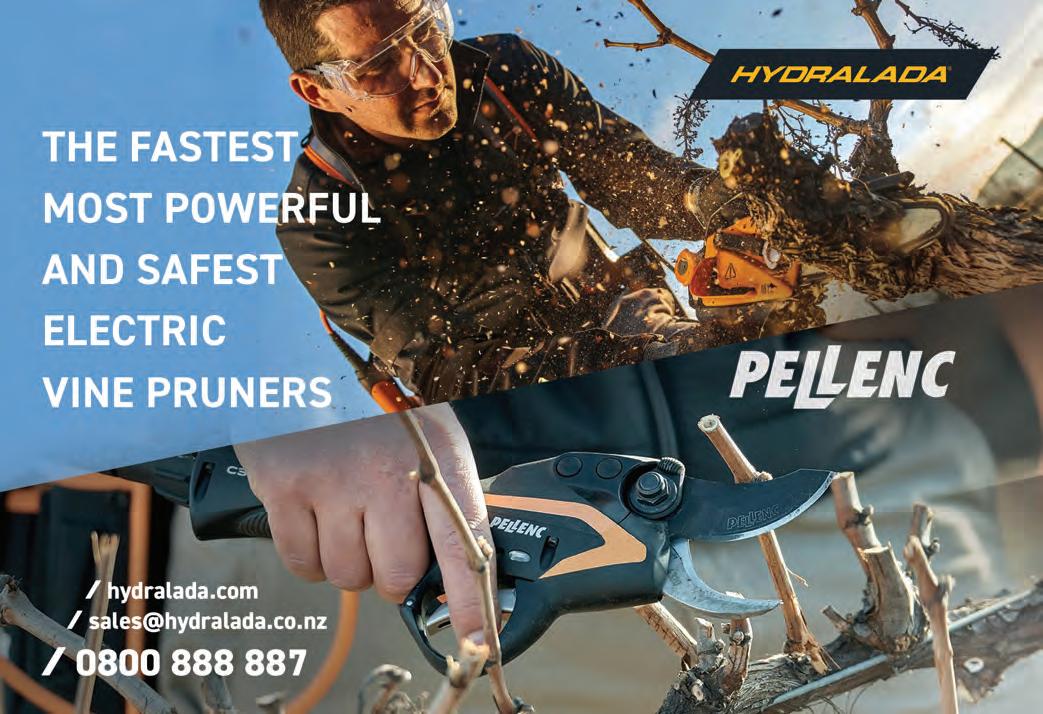
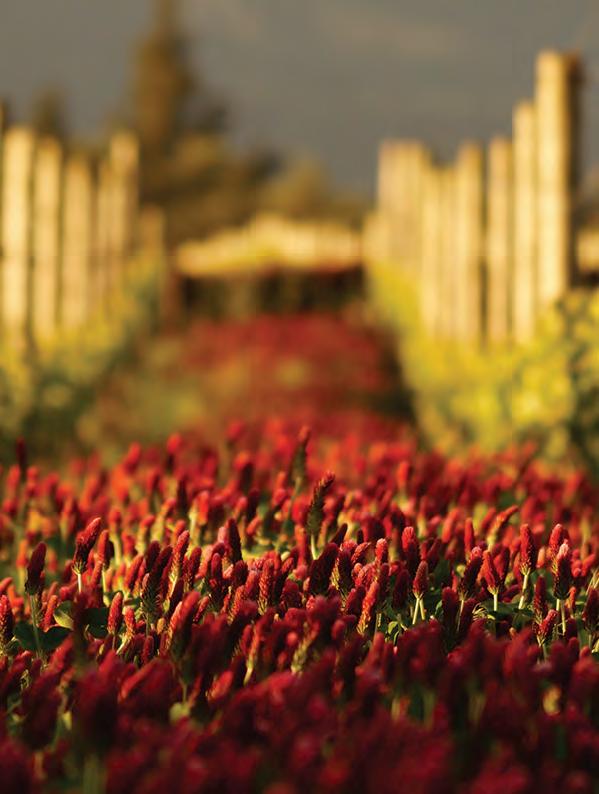
This enables response planners to know what plant hosts and vectors to target for action in a response situation, providing a head start in a response. The host range is extensive, and there are a lot of asymptomatic xylella hosts that don’t show symptoms.
Given the wide host range of xylella, the Xylella Action Group has made a call to focus efforts initially on readiness work for horticultural crops of high value, including wine grapes, summer fruit, and citrus, as well as looking at the nursery pathway around those crops. Readiness activity and impact on other host species will be considered in due course – the Xylella Action Group also includes members representing the Department of Conservation and Te Uru Rākau. Sophie Badland from NZW Biosecurity chairs the BMSB council and the Xylella Action Group.
On 28 and 29 February, I attended the Forest Industry Biosecurity Conference. Like the wine industry, the forest industry is a member of the Government Industry Agreement (GIA) for biosecurity. The GIA’s goal is to achieve better biosecurity outcomes in New Zealand. It brings together government and primary industry groups to better manage pests and diseases that could damage New Zealand’s primary industries, economy, and environment. The conference focused on emerging threats and issues in biosecurity and discussed what’s at stake. Most of the sessions were of interest to the primary sector. The sessions on risk evaluation, aerial invaders, and the Plant Pass nursery biosecurity scheme were of particular interest. Speakers also shared an insight into new surveillance technologies, molecular diagnostic tools, and gene technologies within the innovation space.


On your behalf
Taking NZ wine to the world: Bringing the world to NZ wine
Advocacy on matters of vital importance to the industry
Larissa TrownsonHave your say in 2024
Later this year, all members of New Zealand Winegrowers Incorporated (NZW) get to have their say through:
• a Special Members’ Meeting (SMM), which proposes to extend the audit date;
• the Annual Members’ Meeting (AMM), which proposes to implement the new Incorporated Societies requirements (in addition to the usual business); and
• the election of five Member Class directors to the NZW Board.
More information will be provided to members through our various channels at the relevant times. In the interim, please contact the Advocacy team at advocacy@nzwine.com with any questions. You can also find a dedicated webpage for each event on the NZW members website under ‘Governance’ (a subsection of ‘About Us’).
In addition, the Governance Review is underway and members will be hearing more about this very shortly.
Special Members’ Meeting –change of audit date
The current turnaround time for audits after the end of NZW’s financial year is very short and the auditors have requested an extension of time for this. The current timing requirements come from legislation and the Rules of NZW (the Rules). Of these, the Rules are actually the most restrictive, but if these were to be amended, the deadline for the audit could be extended to 29 September while still meeting other legal obligations. The audit conducted would not be any less thorough, it would just allow more time for this to be completed. The deadline is also during the busiest time of year for auditors, which creates additional costs for NZW which are likely to be reduced if the date can be deferred.
Making this change to the Rules would require a SMM, which is currently planned for Thursday 2 May. As the SMM is on a single topic which is not expected to be controversial, it is being conducted online. The Notice of Meeting and Notice of

Special Members’ Meeting – Thursday 2 May
Nominations open – Monday 5 August
Nominations close – Friday 6 September
Members advised of candidates – Monday 23 September
Annual Members’ Meeting – TBC (proposed as Friday 4 October)
Voting opens – Monday 7 October
Voting closes and results announced – Friday 18 October
Business for the SMM, which will include full details on how to attend and vote, will be sent to members before the Meeting in accordance with our Rules – watch this space.
- implementation of the new Incorporated Societies requirements
At the next AMM, in addition to the usual business, we plan to restructure the Rules to accommodate the requirements of new incorporated societies legislation (which applies to NZW). The related documents and information, including the amendments to be voted on, will be put to members in advance of the Meeting. We anticipate that the AMM will be held on Friday 4 October and will be held online and in person, however, this is still to be confirmed by the Board. As always, we will keep you updated.
In October this year, NZW will be holding an election for the five Member Class directors on its Board [Member Class directors are elected for a term of four years on the basis of one vote per member]. The last Member Class director election was in 2020, and the terms of those five directors also finish in October this year.
The Board’s role is to govern and provide strategic direction to NZW, as your national industry body. As part of this, it directs the spending of your levy money – so it is important that you get involved. NZW members can stand for, and vote for who
makes it on to, the Board – both are very important.
Because of the Member Class voting system, every member – large or small –will have an equal chance to influence who is elected for these positions. NZW hopes to see a diverse range of talented candidates standing across gender, ethnicity, age, regions and industry roles.
Any member of NZW may nominate a candidate from 5 August to 6 September. More information, including regarding eligibility and the nomination process, will come closer to the time. Members can also vote for their preferred candidate from 7 to 18 October.
The election will be run by electionz.com, an independent agent which has run many of NZW’s previous elections. There is still lots of time until it kicks off, and we will be putting out plenty of information in the second half of the year to keep you updated, but it’s never too early to begin thinking about the election, and who you want to govern your national body. Get involved!
• Who do you want to represent your industry’s interests?
• Who is good at seeing the bigger industry picture, and asking perceptive questions?
• How can we ensure the Board reflects the diversity of our membership?
• Who do you know that you might want to nominate to stand?
• Are you interested in standing yourself?
We encourage all members to take these opportunities to have their say in 2024.
Over 3 days, WinePRO will showcase the latest products, new technology, and connect leading suppliers with members of the wine production industry. The event includes an exhibition showcase as well as a comprehensive conference programme and workshops.

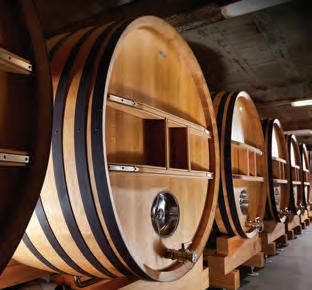

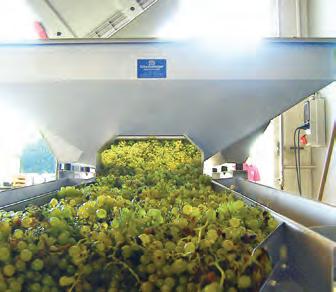
This expertly tailored event brings together the finest talents and offerings from the renowned New Zealand wine industry and beyond, attracting attendees from around the world. Whether you’re a winegrower, winemaker, vineyard manager or any other member of the wine production industry, WinePRO is the event you don’t want to miss!
Discover the latest equipment, services, sustainability measures, automation and so much more.
Learn from industry leaders with key knowledge. One sentence or piece of knowledge could change the trajectory of your business.
Connect with new people and suppliers in the industry and maybe finally put a face to an old name.
Ask questions and get the answers at WinePro! See you there!
Want to learn more? Watch this space!
The WinePro 2024 conference is in the works! It will be filled with challenging & thought provoking topics. Details and tickets will be up on winepro.co.nz very soon so watch this space. ELEVATE • INNOVATE



A regular feature to inform and update the wine industry on research projects being undertaken for their benefit. Newly approved projects when available are briefly summarised. Ongoing projects have longer articles that describe progress and what has been achieved so far. When completed, each project report will be shared in full detail in the Research Library on nzwine.com.
Bragato Research Institute conducts research in-house or collaborates with research organisations throughout New Zealand. The main research providers for each project are listed.
Updates are provided on the highlighted projects in this supplement.
Vineyard Innovation
Improving remedial surgery practices to increase vineyard longevity
Linnaeus, SARDI
Long spur pruning as an alternative to cane pruning for Sauvignon blanc
Bragato Research Institute
Evaluating water use efficiency and drought tolerance of various rootstocks grafted to Sauvignon blanc
Bragato Research Institute
Potential applications of nanotechnology for wine growing in New Zealand
University of Auckland
Varietal diversification – Cool climate aromatic white wine produced by Marlborough
Bragato Research Institute, EIT, NMIT
Genetics for winegrowing
Sauvignon Blanc Grapevine Improvement Programme
Bragato Research Institute, Plant & Food Research, Lincoln University
National Vine Collection Virus Eradication
Bragato Research Institute
Tuned Vines
Bragato Research Institute
Winemaking Innovation
Exploring reductive aromas in Pinot noir
University of Auckland
Precipitation of calcium tartrate and other compounds in wine
University of Canterbury
Lab on a Chip: Developing diagnostic devices for the wine industry
University of Canterbury
Prevention of quercetin instability in bottled wine
Indevin
Sustainable Winegrowing
Microbial community and vine responses to increasing temperatures in the New Zealand context
University of Auckland
Development of an anaerobic chainelongation bioprocess for grape marc valorisation
University of Auckland
Evaluating ecologically sustainable ways to disrupt the weta-vine association
Plant & Food Research
Potted Vines: Exploring the Role of Trichoderma on Marlborough Soil to Influence Drought Stress Shift
Bragato Research Institute
Building Soil Health on Vineyards
Bragato Research Institute


The National Vine Collection (NVC), situated at the Lincoln University campus and overseen by Bragato Research Institute (BRI), is an important resource for the New Zealand wine industry. It contains 1142 vines, ranging from our most popular varieties like Sauvignon blanc to unique ones such as Aligoté, Canada Muscat, and Volta, which are seldom grown. Importing new vines is challenging due to New Zealand’s quarantine regulations, so we maintain the NVC for research purposes and to provide access to the industry.
Despite its significance, a segment of the NVC is marked by low health, predominantly attributed to virus contamination (Figure 1). This trend threatens the loss of unique accessions and diverse grapevine genotypes.
BRI’s Grapevine Improvement team have been undertaking research with innovative approaches to confront these challenges. There are two aims:
to explore internationally recognised technologies capable of treating virus-infected grapevines across various genotypes, and to apply this technology for high-throughput virus cleaning in the low-health portion of NVC. The project aims to halt further losses and establish a virusfree collection comprising grapevine leafroll-associated viruses -1, -2, and -3, and grapevine virus A.
This approach focuses on treating the infected grapevines directly, instead of relying on replacing infected vines with imported virusfree counterparts. This strategy avoids the need for importing new grapevines into New Zealand, a cumbersome process fraught with extensive disease testing and quarantine protocols.
To understand the types of virus infections affecting grapevines within the low-health portion of the NVC, we used a combination
of diagnostic techniques. The Enzyme-Linked Immunosorbent Assay (ELISA) serves as our primary tool for initial screenings. ELISA is a widely recognised method for detecting specific proteins, including viral antigens, in grapevines. It is particularly effective for targeting known viruses with specific antibodies, offering a straightforward and quick approach for large-scale screenings. This process involves the selection of random vines for testing, which assists in understanding the prevalence and distribution of Grapevine Leafroll-associated Virus 3 (GLRaV-3) within the low-health portion of NVC.
However, to uncover a broader spectrum of viral infections that may be present, we also employ highthroughput sequencing (HTS) of the Ribonucleic Acid (RNA) extracted from the vine tissue. HTS offers a more comprehensive analysis, enabling the detection of not only known viruses but also novel or previously undetected ones.
While identifying viral infections, we also explored ways to grow healthy vines from the existing plants. Tissue culture offers a controlled environment where small tissue samples from grapevines can be grown under sterile conditions. This approach allows us to propagate healthy plant material while effectively eliminating viruses that may be present. Various tissue culture techniques were employed to address virus-infected grapevines of different genotypes within the lowhealth section of the NVC.
Importing new vines is challenging due to New Zealand’s quarantine regulations, so we maintain the NVC for research purposes and to provide access to the industry.
One technique we are utilising is heat therapy combined with meristem tip culture. By carefully excising and culturing these meristematic tissues, we can generate virus-free plantlets that serve as copies of the initial virus-infected grapevines. This is done by subjecting grapevine plantlets to elevated temperatures for a specific duration, followed by isolating and culturing the apical meristems - the actively growing regions of the plant where viruses are less likely to reside (Figure 2 (a & b)). Another approach involves the use of antiviral chemical compounds or treatments that may suppress grapevine viral replication or enhance the plant’s immune response against viral infections, followed by meristem tip cultures. These treatments, along with others, are meticulously evaluated for their efficacy and their effects on the survival and regrowth of grapevine plantlets.
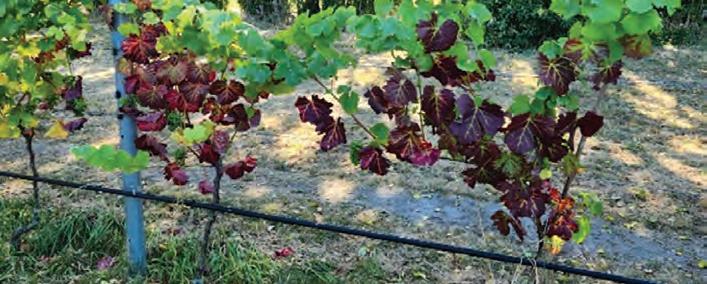
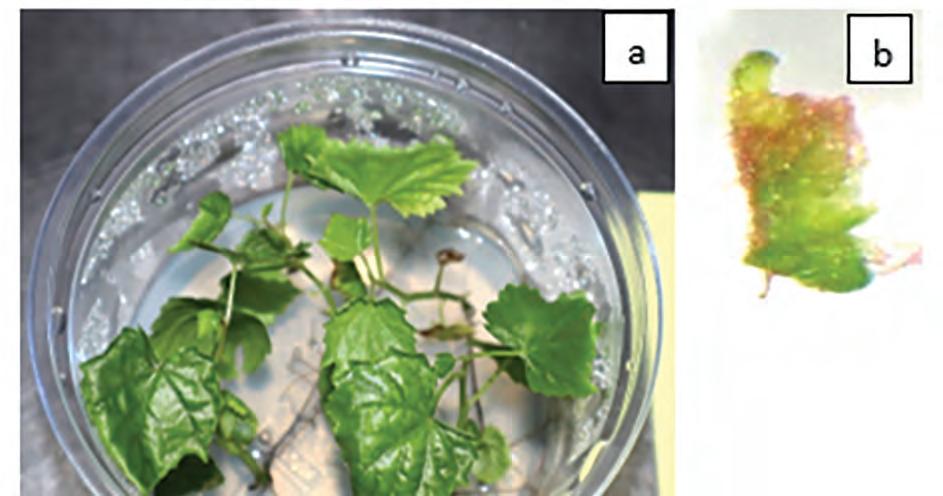
BRI is collaborating with national experts to expedite molecular detection using quantitative Polymerase Chain Reaction (qPCR) to assess the virus status of the recovered grapevine tissue culture plantlets post-treatment. Quantitative Polymerase Chain Reaction (qPCR) is a sensitive molecular technique that allows for the rapid and accurate detection of viral nucleic acids within grapevine samples. This method amplifies specific regions of viral DNA or RNA and quantifies the amount of target nucleic acid present in the sample.
By employing qPCR, we can precisely determine the efficacy of treatments in reducing viral load and monitor the progress of virus elimination throughout the recovery process. Through the integration of qPCR into our diagnostic workflow, we can enhance our understanding of
viral dynamics within the recovered grapevines and refine treatment strategies.
The ongoing research endeavours to improve the health of the National Vine Collection present promising insights into effective strategies for eliminating grapevine viruses within the low-health portion. However, there is still a long way to go to establish mature virus-free grapevines. This work will ensure the conservation of the grapevine genotype available to the wine industry and other researchers to access.
This research is funded by the New Zealand Winegrowers levy.
Lead by Dr Darrell Lizamore and Dr Solomon Wante from the Bragato Research Institute
Grapevine Improvement team, the project runs for three years.


Introduction
Wineries routinely monitor the changes in wine composition, particularly during fermentation when many biochemical reactions are taking place, to inform the production decisions that determine the overall taste, texture, and quality of the finished wine. Both in-house testing capability and contract wine testing can be costly, particularly when a winery is running multiple ferments.
The University of Canterbury (UC) is collaborating with Bragato Research Institute (BRI) to develop a device that delivers rapid, cost effective analysis of the components in wine samples without the need for a lab, expensive equipment, or specialist staff training.
The technology: Winealyse
The project, working under the concept name Winealyse, is applying advances in microfluidics to miniaturise traditional laboratory techniques to provide a testing platform that brings wine samples and analytical reagents together on a small ‘chip’ device. The technology
applies principles similar to Covid-19 rapid antigen tests (RATs) whereby the analytical chemical reactions happen in the device enabling rapid testing of small sample volumes, on site, and the results can be read within minutes.
The technology Winealyse employs is called ‘capillarics’. While RATs use paper strips to pull the fluids through the test device, capillarics utilises microchannels (0.1-0.25 mm wide x 0.1 mm deep) fabricated in hard materials (chips). Sample and reagent solutions are drawn together via capillary action along these microchannels to deliver the required reaction ratio, removing the need for manual handling and pipetting. The team at UC has patented a new type of capillary valve which enables channels to be automatically closed where needed, allowing for devices with more complex functionality to be developed. This approach significantly reduces the size and training required for the devices, allowing them to be used by anyone, anywhere. This means winemakers and cellar
hands can take readings right at the barrel or tank, giving them realtime feedback for more control and understanding of their process.
The team has now tested a prototype glucose assay using the microchannel chip technology. The device provides a quantitative reading for the glucose concentration in a juice, ferment, or wine sample by presenting a colour change in the reaction. Testing in a working winery environment during the 2023 vintage has shown promising preliminary results for glucose content in juice and wine samples tested throughout the wine production process.
The device is now being further developed for improved robustness, accuracy, and reliability alongside extending the technology to test for a wider range of analytes important to winemakers, including alcohol, sulphur, and TA.
Over the past two years, the team has been fortunate enough to win
several awards and be accepted into prestigious programmes. In the UC Innovation Jumpstart competition, the team won the Greatest Global Impact award, sponsored by Bridgewest Ventures. PhD candidate Daniel Mak was then accepted into the Kiwinet Emerging Innovator programme, a six-month programme that provided Daniel with funding and mentorship to promote his commercial and professional development. The team has won Research RunnerUp in Christchurch NZ’s Food, Fibre, and Agritech Supernode Challenge. Off the back of this, the team was also invited to participate in Sprout Agritech’s Accelerator programme.
The team would like feedback on this project to make sure they can provide the best value to you, the people of the wine industry. Some key questions we have and would appreciate your input on are: what problems do you face in your winery?; What are your testing requirements?; How would you implement a new testing device in your winery; And what would you like to see a test developed for?
If you have any thoughts about these questions or any other aspect of this project, please get in touch with the team via info@bri.co.nz.
The funding for this project is from the University of Canterbury, Bragato Research Institute, the Ministry for Business, Innovation, and Employment, the MacDiarmid Institute, and Kiwinet. The project team includes PhD candidate Daniel Mak, post-doctoral researcher Dr Azadeh Hashemi and two UC academics – Professor Renwick Dobson and Associate Professor Volker Nock. BRI is providing expert guidance on different aspects of testing the components in wine and deep knowledge of the New Zealand industry. The team is passionate about providing a solution to vineyards and wineries for their testing needs.
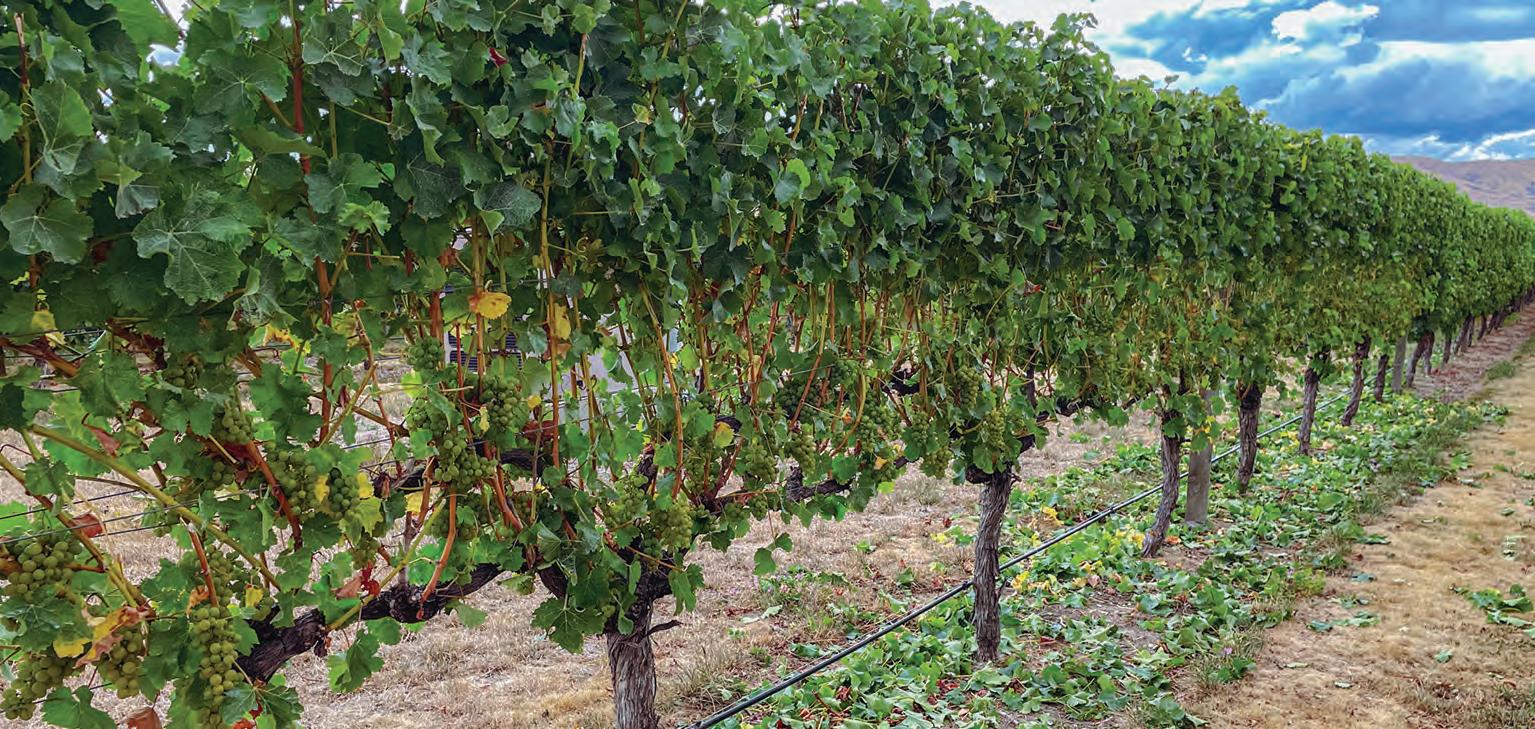
Background
The rise of vineyard and labour costs required for maintaining high-quality grape growing poses challenges to vineyard financial sustainability. In Marlborough, vineyard expansion is showing no signs of slowing down, accelerating regional labour shortage
issues. These challenges signal a need to explore alternative growing systems for producing Sauvignon blanc.
One of the biggest vineyard expenditures is winter pruning, and for a long time cane pruning has
been the favoured pruning method in the region. Cane pruning delivered sufficient yields each year, meaning there was little appetite to search for an alternative pruning system, and spur pruned Sauvignon blanc was believed to have lower fruitfulness. Modified spur-pruned Sauvignon

blanc vines, with longer spurs than traditional two-bud spurs, were quietly trialled among some growers 20 years ago. The anecdotal feedback was that the system could produce equal or more yields than cane pruning while reducing labour inputs and pruning cost, but it was never tested under an objective trial setup. Also, there were limited demonstrations of the effects of the different pruning systems on the quality of grapes with equal bud loads in the New Zealand context.
The trial
In 2020, the entire horticulture industry encountered an unprecedented challenge due to a shortage of seasonal labourers caused by New Zealand border closures. This led to many vineyards experiencing delayed pruning, or worse, pruning during bud burst.
To prevent a recurrence of this crisis, Bragato Research Institute (BRI) actively sought solutions, including a long spur pruning technique pioneered by Mark Allen, a viticulture consultant. Long spur pruning has the potential to reduce labour inputs at a similar yield and quality, as well as enable more mechanisation than cane pruning. BRI set up a trial to gather objective data on the effectiveness of long spur pruning across three Marlborough vineyards
to give growers the new knowledge they need to decide whether this alternative pruning technique was appropriate for their circumstances.
The trial compared the typical Marlborough pruning system of four canes per vine to two long spur techniques. Four cane vines (4C) as control were laid with the specific bud number set by the vineyard target. Four bud-spur vines (4BS) consisted of the same bud numbers as 4C but pruned with four bud-spurs, and five bud-spur vines (5BS) had the same spur number as 4BS but each spur had laid with five buds, e.g. 23% increased bud numbers than 4C. Three treatments were applied to four adjacent vines in a bay and replicated six times with a complete randomised block design. Three vineyards grown in moderate soils with 15 to 20-year-old vines in the Wairau Valley that have been producing over 15 t/ha were selected and monitored for two years from the winter of 2021.
The effects of long spur pruning on vine performance and wine quality were investigated each season by measuring vegetative and reproductive responses, disease assessment, wine compositions, volatile aroma compositions, and sensory evaluations.
Compared to 4C, 4BS and 5BS vines had higher blind buds in all vineyards for season one, and two vineyards in season two. Blind budding in long spur vines was mainly observed at the first bud from the base of the spur at incidence rate of about 50%. Although 5BS recorded significantly higher blind buds than 4C, 5BS tended to have a higher shoot number per linear metre, which was likely the reflection of a higher bud density retained. Blind budding at the first bud can lead to spur castling over time, limiting canopy growth and impacting yield and quality. To mitigate this risk, the finger and thumb technique was introduced during the second season’s pruning where spur site was lifted and it helped lower those spur sites at the following year’s pruning.
There were no differences in the percentage of canopy gaps and interior bunches using point quadrat analysis in season one, but image analysis showed that cane-pruned canopies had more porosity than spur-pruned vines. However, the differences in the canopy gaps between treatments disappeared once vines reached full canopy in February. During the second season,
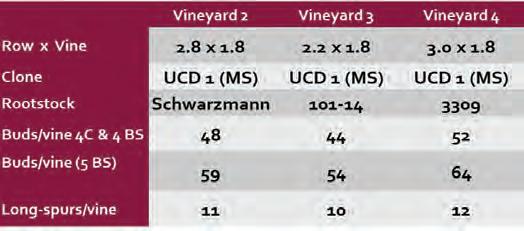
there was a tendency to have higher leaf area in spur pruned vines using an area meter, but the difference was only significant in one vineyard.
Yield, bunch architecture, and juice compositions
Fruit yield exceeded the target of 15 tonne/ha set at the beginning of the experiment for all but 4BS in one vineyard in both seasons. Compared to cane pruned vines, 4BS tended to have lower yields, but the differences were less noticeable in the second season, except for in vineyard 4. In the second season, 5BS yielded significantly higher than other treatments in one vineyard. There were few differences in fruit composition in season one. Juicesoluble solids were higher in spur pruned vines in two vineyards in season one and one vineyard in season two. These seemed a reflection of lower yield in spur vines, which was less noticeable in the second season.
Pruning treatments did not affect the disease occurrence in both years, except for 5BS, which had a lower botrytis incidence in one vineyard second season.
Wine evaluations
Wine compositions were similar between treatments. In season one one vineyard had a lower pH and higher TA and Malic acid in 4C. This was likely the reflection of the significantly higher yield in the treatment than long-spur treatments. There was no difference in season two.
Overall, there was no noticeable difference in wine sensory attributes


across pruning treatments in both seasons. Each season of wines made from each treatment were served to experienced Marlborough winemakers for sensory evaluation. The panellists scored the rate of one to ten for each descriptor relevant to Marlborough Sauvignon blanc aromas and mouth-feel.
The comparison of four cane pruning and long spur pruning on Marlborough Sauvignon blanc over two seasons has provided valuable insights into vineyard management practices and their impact on various parameters. The findings indicate that long spur pruning had higher blind budding than cane pruning, which may have reflected lower yield in 4BS than 4C in season one. Although pruning treatments influenced canopy density, architecture, yield, and fruit composition, there was no notable difference detected in wine sensory
attributes evaluated by experienced winemakers.
The project is now in its final season. In addition to the measurements discussed here, BRI will also collect information on field and financial data from growers who have been implementing the long-spur pruning system at a commercial scale. By evaluating three-year objective data and growers’ information, the project aims to determine if long spur pruning can be a viable alternative system in the Marlborough region.
Long spur pruning as an alternative to cane pruning for Sauvignon blanc in Marlborough is a three-year research project led by Bragato Research Institute in collaboration with Mark Allen and Dr Stewart Field. It is funded by the New Zealand Winegrowers levy.




